
- The catacombs of Saint Callixtus: one of the largest and most important underground cemeteries in Rome
- Official cemetery of the Church of Rome in the 3 rd century AD
- The crypt of the Popes: the heart of these catacombs
- About five hundred thousand Christians were buried here
- A destination for pilgrimages due to the numerous martyrs who were buried here

VISITORS INFO
To visit the Catacombs:
Groups should make reservations online: https://www.catacombesancallisto.it/en/modulo-prenotazioni.php
Individual visitors and groups of up to 15 people must make reservations online.
Visiting hours can be found on the reservation site: https://www.catacombesancallisto.it/en/prenota-10.php
ONLINE RESERVATION
https://www.catacombedisancallisto.it/en/prenota.php
The Catacombs of St. Callixtus in Rome
They were the official cemetery of the Church of Rome in the 3 rd century AD. Around half a million Christians were buried here, among them many martyrs and 16 popes. They are named after the deacon St. Callixtus who, at the beginning of the 3 rd century AD, was assigned by Pope Zephyrinus to the administration of the cemetery. The Callistian complex is the property of the A.P.S.A. Administration of the Patrimony of the Apostolic See. Governance, custody, and preservation are entrusted to the P.C.A.S. Pontifical Commission of Sacred Archaeology, a body of the Holy See. Since 1930 the reception of pilgrims and guided tours of the catacombs open to the public have been entrusted to the Salesians of Don Bosco.
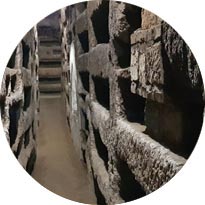
The Christians of Rome began to excavate their own community cemeteries (known today as ‘catacombs’) at the beginning of the second half of the 2 nd century AD, when a few wealthy families, having been converted to the Christian faith, donated their lands to the Church.
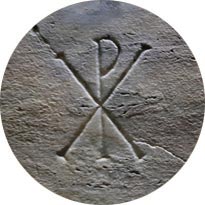
The first Christians loved to greatly express their own faith through symbols, because it was both possible ‘to say’ many things with a symbol, and because the images were easily understood even to the illiterate. Among the symbols most used in the catacombs we find...

Admission Fees

Reservations
Guided Tours & H. Masses

How to Get Here
USEFUL LINKS

- Holidays in Rome
- New Years Eve
- Where to Stay
- Where to Eat
- Best Time to Visit Rome
- Top 10 Tips for Rome
- Bathrooms in Rome
- What to Pack & What to Wear
Money Matters
Getting Around
Getting to Rome
- Learn Italian
- Rome & Vatican Tours
- Italy Tours
- Transfers & Transport
- Sign up & get a FREE ebook Subscribe NOW! Our New Italy Travel Website Is HERE VISIT NAPLESWISE TODAY!
- Romewise Home Page
- What to Do in Rome
- catacombs of Rome
Everything you need to know before visiting the Catacombs of Rome

By Elyssa Bernard
February 19, 2023
Thinking of visiting the catacombs of Rome?
Wondering if it's worth it?
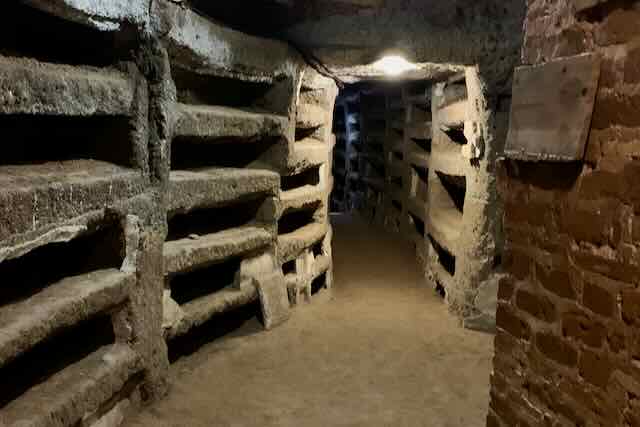
Catacombs of Rome - Everything you need to know
If you love Ancient Roman history, art, and off-the-beaten-path sightseeing, add the catacombs to your Rome itinerary!
On this page, we'll go over:
- A brief history of the catacombs of Rome - what are they, when were they built, and what were they used for?
- What is the Christian history of the Roman catacombs?
- Where are the Rome catacombs?
- How can you visit the different catacombs of Rome?
- What will you see when you visit Rome's catacombs? Are there bones?
- Is it worth seeing the Rome catacombs?
So read on for some fascinating Roman catacombs facts!
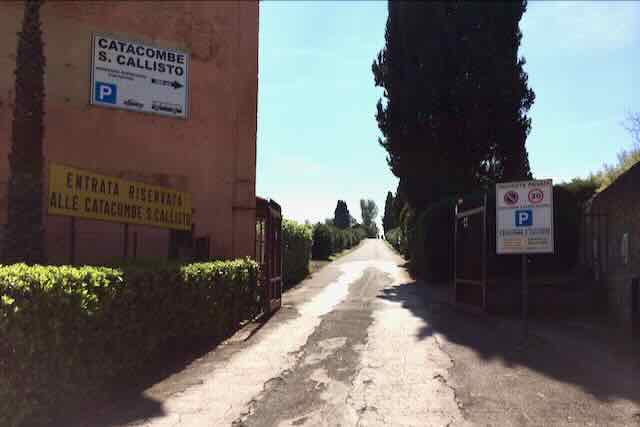
History of the catacombs of Rome
What are the catacombs.
So whats a catacomb?
The catacombs of Rome are a network of underground burial chambers located around the city of Rome.
There are probably 50-60 catacombs underground Rome, but only a handful have been excavated and only 6 are open regularly.
The catacombs began being used as burial sites for centuries, starting in the 2nd century CE.
They were used by people of varying faiths - Christian, Jewish, and pagan, but fell out of use around the 5th century.
In the 9th century, Rome was often vandalized by Germanic tribes from the north, and many catacombs were plundered for their valuables.
As a result, popes began moving Christian martyrs and saints remains and relics to churches in Rome where they can be found today.
The popes then blocked the entrances and they were forgotten for over 500 years.
In 1578, Maltese-born archaeologist, Antonio Bosio (1576 – 1629 CE), stumbled upon an entryway to a catacomb along the Via Salaria.
In 1593, he rediscovered the Catacombs of Domitilla, nearly getting lost in the labyrinth as he delved further in.
Nick-named “Columbus of the Catacombs” because he was the first to systematically explore and document the Roman catacombs, Bosio published Roma Sotterranea , which became an essential guide to future archeologists and those studying the catacombs.
When and how were the catacombs of Rome built? Who built them?
From the earliest days of the Roman Republic (6th century BCE), it was forbidden to bury the dead inside city walls.
This was likely to prevent the spread of disease, but also to prevent overcrowding in rapidly growing cities.
This law was later observed across the Roman Empire, which is why you find ancient necropolises, or "cities of the dead", also at Pompeii , Ostia Antica , etc.
(Many of these are above-ground.)
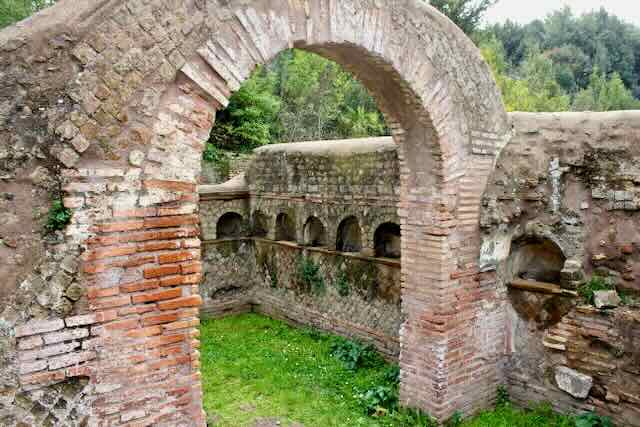
Before Christianity became popular, Ancient Romans cremated their dead and placed them in urns which in turn were placed in honeycomb-like structures called a colombario .
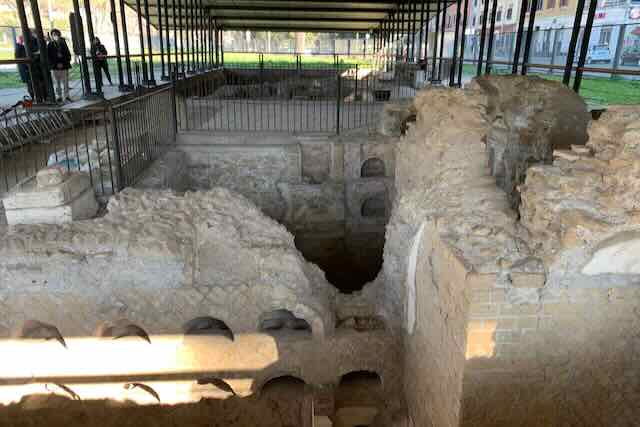
Christians and Jews did not want to be cremated, preferring "inhumation", which kept the body intact.
The earliest underground tunnels near Rome were dug by the Etruscans and primitive Romans, who were looking for minerals and other useful underground substances such as sandstone and limestone.
These tunnels were dug out of the soft earth we have around Rome, called "tuff" or tufo in Italian.
As the idea to bury people in inexpensive mass graves outside the city limits began to take hold, these same underground tunnels were repurposed as catacombs.
This began in around the 1st century, making them the oldest catacombs ever built.
The wealthy sometimes built impressive tombs for themselves and their families above ground, and you can see some of these if you visit the Appia Antica .
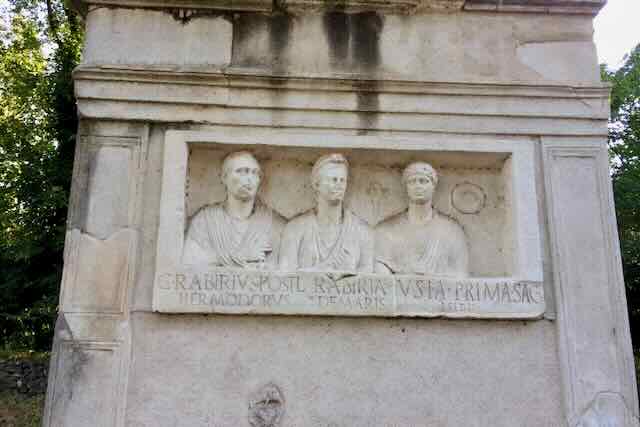
One of the largest and most famous of these is the tomb of Cecilia Metella, a 1st century BCE tomb of a daughter of a Roman Consul.
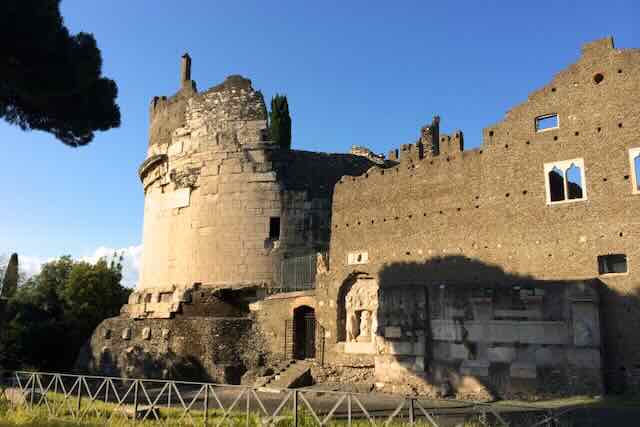
But the tunnels were a convenient way to bury a lot of people in a relatively safe way, far from the city limits.
The bodies were usually wrapped in 2 layers of linen, sprinkled with lime to help mask the smell, and placed in loculi , or small niches cut into the walls of the tunnels.
When you visit the catacombs, you will also notice smaller loculi for children.
The catacombs were built over the course of several centuries, with the majority built during the 3rd and 4th centuries CE.
👣 Discover the secrets of Rome's catacombs and original highway 👣
The Appian Way heading south out of Rome was the ancient city's original highway, constructed over 2000 years ago.
You can still walk this road, going back in time as you explore its sites including the world famous catacombs.
Consider book on to this tour where you'll be guided by an expert guide:
Click here to find out more now
What were the catacombs of Rome used for?
The Rome catacombs were used as a place to bury the dead.
This included people of all faiths, Christian, Jewish, and pagan.
The word " cemetery " derives from the Greek word for "sleeping place", and this is exactly what the catacombs were - a place for the dead to rest.
The word "catacomb" also derives from Ancient Greek. " Kata " meant "near" and " kymbas " meant "cave".
This in turn became the Latin " cata cumbas ", in English catacombs meaning "among the graves".
Contrary to popular belief, they were likely not used as a place for Christians to meet in secret to avoid persecution.
Ready to plan your trip?
Book your train.
Planning to travel between cities in Italy and other parts of Europe?
Use Trainline to see all the different options available across the different rail companies.
Find your hotel
Find your perfect place to stay in Rome.
Use Booking.com to choose between hotels, guesthouses, and self-catering apartments in neighborhoods throughout the Eternal City.
Buy your TurboPass
Purchase the convenient Turbopass and visit all of Rome's top attractions including the Colosseum, Pantheon, and Vatican.
With one handy pass, it's all included.
How many people were buried in the catacombs of Rome?
As the tunnels go for miles and miles (much of this has not been excavated), and as the dead were often piled on top of each other, thousands upon thousands of people were buried in the Roman catacombs.
Are there still bodies in the catacombs of Rome?
There are no longer any visible bodies buried in the catacombs of Rome. The catacombs are now mostly empty.
Some of the bodies that were once buried there have been moved to other burial sites, and in many cases, the remains have simply disintegrated over time.
How long are the Rome catacombs?
There are several catacombs around Rome, and some of them have not even been excavated yet.
But of those that have been, there are miles and miles of them.
One could easily get lost in there, which is one reason you must visit as part of a guided tour .
Christian history of the Roman catacombs
What did the first christians use the catacombs of rome for.
Christianity began to spread through Rome in the mid-1st century CE, and by the 2nd century CE there was a large and thriving Christian community in Rome.
The catacombs were an important part of early Christian life in Rome.
They provided a place for Christians to bury their dead.
This tradition continued until around the 5th century CE.
Is it true that Christians would meet in secret because Christianity was banned?
The idea that the catacombs were used by Christians as a place to meet in secret because they were being persecuted has largely been discredited - most scholars today debunk this urban myth.
First of all, the persecution of Christians was sporadic and inconsistent, happening over long stretches of time.
Second of all, the catacomb locations were well-known, so it would be hard to hold secret meetings there.
It is more likely that when people, Christian or otherwise, met in the catacombs, it was to celebrate their dead family members.
What are the features of the Christian catacombs?
They're home to a wealth of early Christian art.
This includes examples of early Christian symbol like the Good Shepherd, as well as depictions of scenes from the Old Testament.
You will also find many examples of early Christian inscriptions or graffiti in the catacombs.
This writing often contains the names of the dead which helps us to understand who was buried there.
One of my favorite catacombs is the catacomb of Santa Priscilla.
There you can see the earliest known depiction of Mary as mother of God.
What are the cubicula?
The function of the cubicula was to provide small, private burial chambers for wealthy families, something like a family crypt.
Each cubiculum consisted of a number of small rooms that were used to bury the dead.
The rooms were often decorated with Christian symbols and inscriptions.
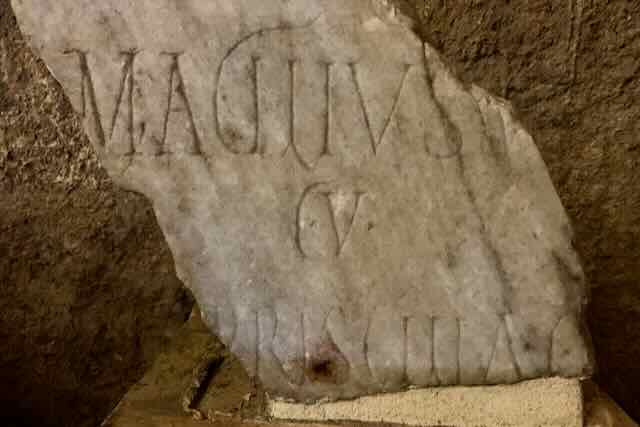
The catacombs also contain arched recesses called arcosolia .
The word derives from Latin arcus , "arch", and solium , "throne".
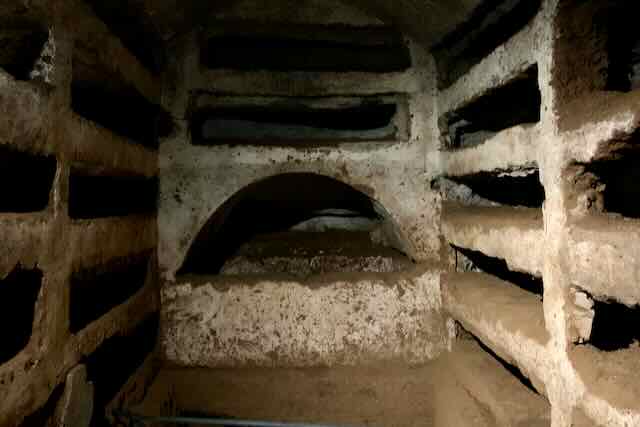
How to visit the catacombs of Rome
Which catacombs can you visit in rome.
The catacombs you can easily visit in Rome are the catacombs of Callixtus , Sebastian , Saint Domitilla , Agnes , Priscilla , and Marcellinus and Peter .
There are a few more that you can visit only upon request, such as the catacombs of Comodilla or San Pancrazio.
There are six known Jewish catacombs in Rome.
Only two are open for visits - the tombs at Vigna Randanini and at Villa Torlonia (these are currently being restored, so as of 2022 are not open to visitors).
These catacombs, while sometimes available for visits, are not regularly open.
The only way to see them is with a guided visit upon special request.
Some tour companies offer these visits - take a look at the following options:
- Jewish Roma Walking Tours
- Roman Jews - Jewish Catacombs Tour
- Walks Inside Rome - Jewish Catacombs and Appian Way Tour
Other examples of burial places or tombs in or near Rome you may want to visit include:
- Saint Peter's tomb
- The Capuchin Crypt (not a catacomb, but the best place to see bones if you are interested)
- The Mausoleum of Augustus and the Mausoleum of Hadrian (today Castel Sant'Angelo .)
- If you are interested in cemeteries , we have some beautiful and interesting ones in Rome.
- Etruscan tombs not far from Rome (a great day trip from Rome or shore excursion)
You can also see some Etruscan tombs in the Villa Giulia and inside the Vatican Museums' Etruscan wing.
What is the best time to visit the catacombs in Rome? What are the opening hours of the catacombs? What is the entrance fee?
All the catacombs have differing opening hours so you can almost always find one open.
Many of them have a period of closure in summer or winter .
- San Callisto : Open Monday - Tuesday, Thursday - Sunday 09:00 - 12:00, 14:00 - 17:00. Closed on Wednesdays, on holidays: January 1st, Easter (April 17th), Christmas (December 25th) and during winter (20 January - 15 February)
- San Sebastiano : Open Monday - Wednesday, Friday-Sunday 10:00 - 17:00 (last visit starts 16:30). Closed on Thursdays and during winter (25 November - 25 December)
- Santa Domitilla : Open Monday, Wednesday - Sunday 9:00 - 12:00, 14:00 - 17:00 (The last guided Rome catacombs tour begins 20 minutes before closure, both in the morning and in the afternoon). Closed on Tuesdays, and during winter (17 December - 14 January)
- Santa Priscilla : Open Tuesday - Sunday 09:00 - 12:00, 14:00 - 17:00. Closed on Mondays, on holidays (Christmas, 1 January, Easter) and during summer and winter pause (27 December 2021 - 13 January 2022 and 16 - 29 August 2022)
- Sant'Agnese : Open Thursday - Friday: 9:00 - 12:00, 15:00 - 18:00; Saturday 9:00 - 12:00, 15:00 - 19:00; Sunday: 15:00 - 18:00. Closed on Mondays, on mornings of religious holidays (Christmas, Easter, August 15th, January 1st) and during November
- Saints Marcellinus and Peter : Open Monday - Wednesday, Friday – Sunday 10:00 - 12:00, 14:00 - 17:00. Closed on Thursdays and during August.
Can you visit the catacombs without a guide?
No, you must go with a guide.
You cannot buy Roman catacombs tickets and walk around on your own inside.
In some cases, you can go with a guide working for the site.
In many cases, you can book a tour with a tour company .
This can be convenient because with a tour company you can usually see more than one site, and transportation is often included.
Can you take pictures in the catacombs?
No, you cannot take pictures or film inside the catacombs.
You can, however, take a tour on Google.
Just visit Google maps, enter the name of the catacombs you want to see, and when the results come up, choose image mode.
Here is Santa Priscilla for example .
What should you wear when visiting the catacombs?
You should wear comfortable shoes as you will be doing lots of walking.
You may want to bring a sweater or jacket as it can be chilly underground Rome - this is a great way to keep cool in the summer !
Finally, because these are considered holy sites, you should make sure to cover knees and shoulders, as you would when visiting the Vatican or other holy site.
For more tips about what to pack for a trip to Rome, visit our page here .
No matter what season you visit Rome, here are 4 essential things we recommend never leaving home without:

Disclosure: If you make a purchase through a link on this page, I may receive a small commission - at no extra cost to you. Thank you for supporting my site!
Is it claustrophobic? How long do visits or tours last?
The guided tours generally last around 1-2 hours.
If you are very claustrophobic, you may not enjoy a visit to Rome's catacombs.
Some of them are quite small and cramped.
In some cases, the tunnels lead to larger openings but overall, it can be a claustrophobic visit.
How to get to the catacombs of Rome?
The catacombs of Rome are all over the Eternal city.
If you do not take a guided tour that includes transportation, you could take a taxi , but you'll want to have a way to call or order a taxi for the return trip.
Probably the best way to reach a catacomb is by public transportation . There is no Metro stop that's very near to any of the catacombs, but quite a lot of bus routes will get you close to them.
The Hop-on Hop-off buses stop near the catacombs along the Appian way .
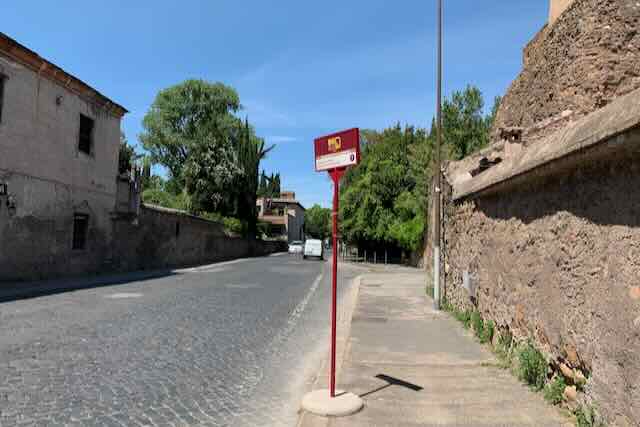
One nice way to visit the Appian Way catacombs is to go by bike - you can rent bicycles in the area and cycle in the Caffarella Park nearby.
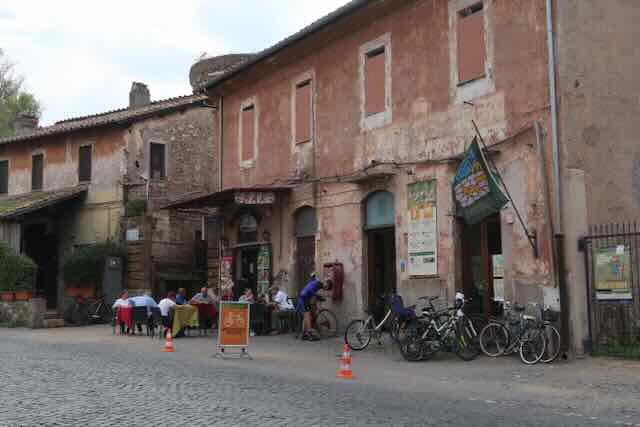
Here's how to get to the main Rome catacombs:
Appia Antica Catacombs
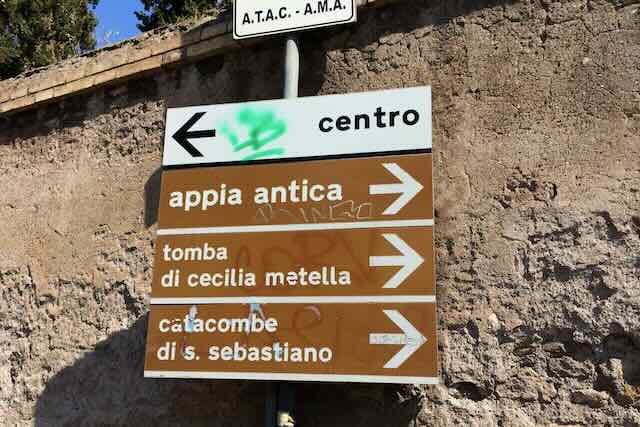
Three of Rome's best-known catacombs are near each other, on or near the Appian Way in the southern part of Rome.
- Catacombs of San Callisto (Via Appia Antica, 110/126) - The 118 bus drops you about 2 minutes' walk from the entrance. The 218 bus drops you about 5 minutes' walk from the entrance.
- Catacombs of San Sebastiano (Via Appia Antica, 136) - The 118 bus stops almost in front of these catacombs. The 218 bus stops at Fosse Ardeatine which is about a 10 minute walk to these catacombs.
- Catacombs of Santa Domitilla (Via delle Sette Chiese, 282) - These are also along the Via Appia Antica but in a different spot from the above two. The 714 bus and the 30 express bus both stop at Navigatori, about 9 minutes from here. The 218 bus stops at Fosse Ardeatine which is about a 5 minute walk away.
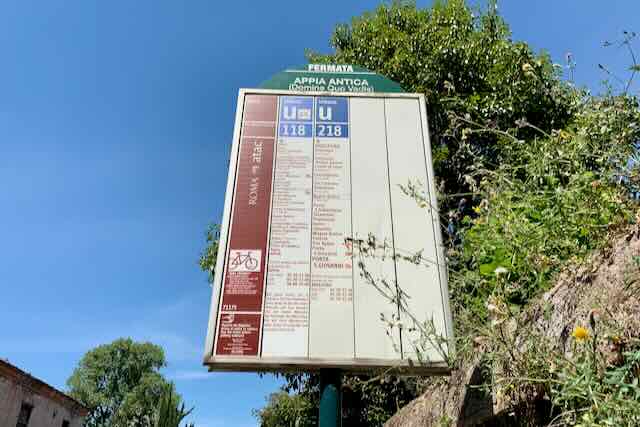
Catacombs in northern Rome:
- Santa Priscilla (Via Salaria, 430) - The 92 bus and the 310 bus each stop a few minutes from the entrance.
- Sant'Agnese (Via Nomentana, 349) - Being on a very busy road, there are many city buses that stop just outside the entrance to this site.

Catacombs in eastern Rome
- Saints Marcellinus and Peter (Via Casilina, 641) - The tram Giardinetti stops right in front, as does the 105 bus.
What will you see in the catacombs of Rome?
While all the catacombs in Rome were the burial place for ancient Romans, they all have different things for you to see.
Some, such as the Catacombs of San Callisto were home to the final resting place of prominent individuals - these catacombs are nicknamed “the little Vatican ”, because 9 popes were buried here.
Even more impressive examples of important figures are at the Catacombs of San Sebastiano, which is where St Paul and Peter were both initially buried.
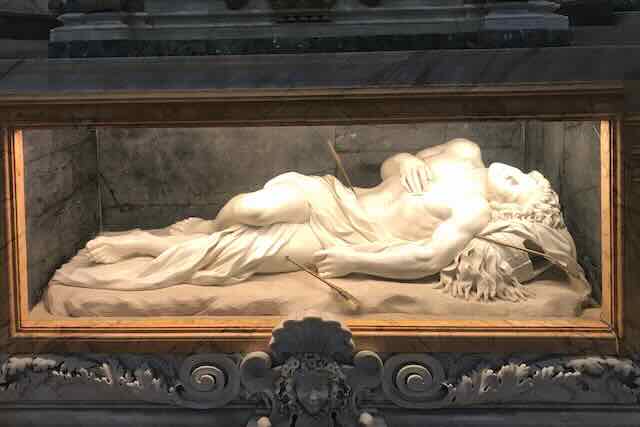
The Catacomb of Santa Domitilla is the only location you can visit that still has human remains.
It also has a 4th century basilica inside where you can worship, with vividly restored frescoes.
The Catacomb of Santa Priscilla is inside a monastery.
You will see stunning intact frescoes, including the earliest known depiction of Mary with the baby Jesus, and because there were so many martyrs and popes buried here, they're nicknamed the regina catacumbarum , the queen of the catacombs.
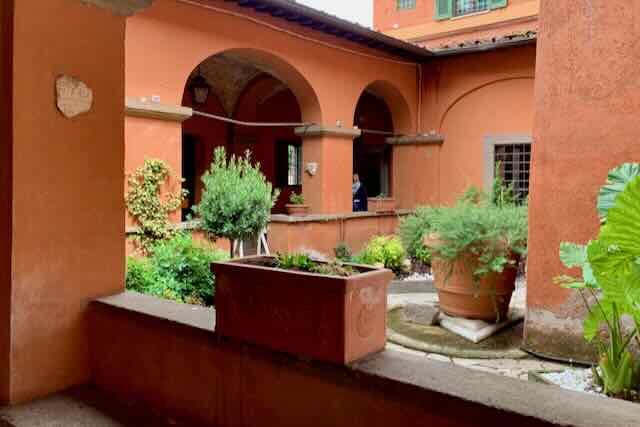
The catacombs of Sant'Agnese are under the basilica of the same name, and next to the Mausoleum of Santa Costanza.
It's worth taking a tour of the entire complex.
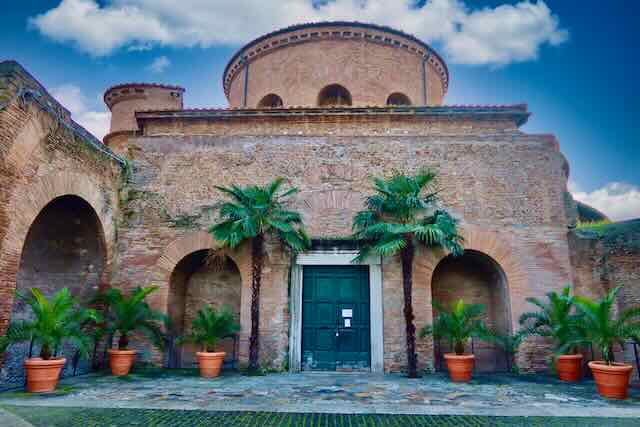
The catacombs of Saints Marcellinus and Peter are under the Mausoleum of Saint Helen, today a museum.
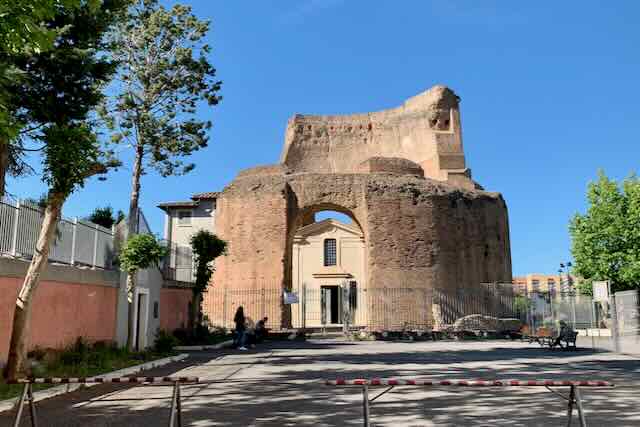
Is it worth visiting the Rome catacombs?
They definitely are worth visiting for these reasons:
- If you're interested in Ancient Rome, this is a great way to learn about how the Romans handled death and burial, and how early Christians celebrated their dead.
- The catacombs are usually not on people's bucket lists so tend to be less crowded than the " must-see " attractions in Rome.
- If you're interested in art, this is the perfect way to learn about early fresco art techniques and themes.
- Visiting the catacombs and other underground sites can be a nice way to cool down in summer. The exception is Saint Peter's tomb (not a catacomb), which is actually hotter than above ground, and is best visited from fall through spring , and avoided in summer if possible.
If you had to pick one, which is the best catacomb in Rome?
Many people would say that the catacombs of San Callisto are the best catacombs to visit in Rome.
They are the largest and most well-known.
My favorite is the catacomb of Priscilla, not only for its beautiful frescoes, but also because it is lesser known, and therefore not as crowded as some of the others .
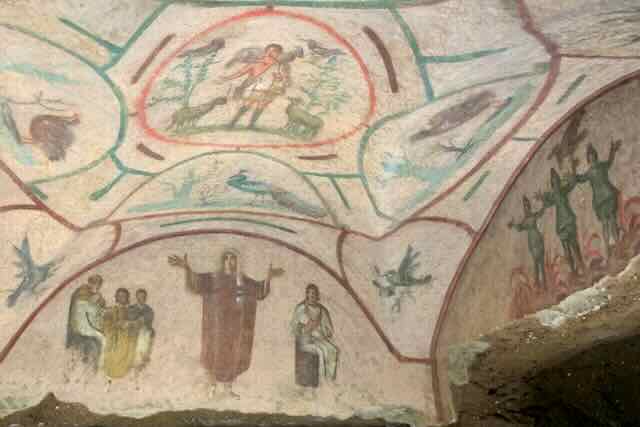
No matter which catacombs you visit, you are sure to have an interesting and educational experience.
For more information, visit the website of the commission responsible for the catacombs for opening hours, catacombs Rome map and more.
Want to save this to Pinterest?
Pin it here!
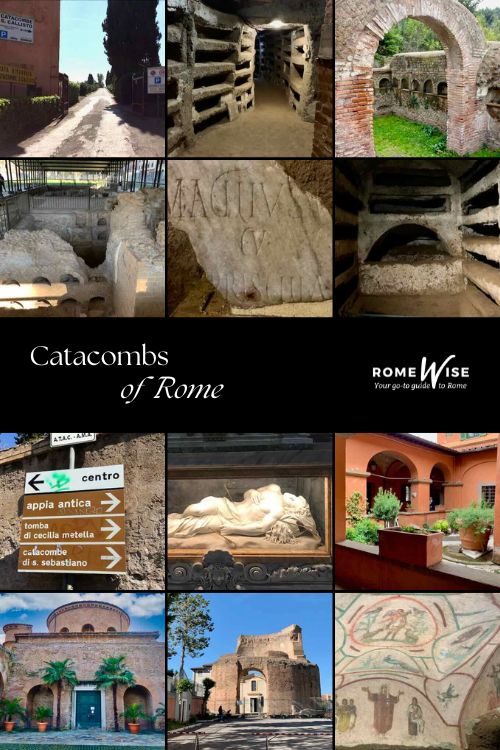
Romewise's Top Travel Resources
Ready to book your trip to Rome? Take a look at these helpful links to companies we use and trust:
- Keep your travel spending simple with the Wise card, which removes all the worry about exchange rates and high transaction fees all over the world
- Search for and book your perfect accommodation
- Our complete guide to what to pack for Rome
- The number one travel accessory, a multi-point travel adapter and voltage converter
- Browse a huge range of tours in Rome and beyond
- Experience unique tours and special access to Rome's most popular sights
- Protect yourself with comprehensive travel insurance
Within this post there are some affiliate links for products and services. For more details about our affiliate policy click here .
Get your 100% free Rome trip planner now!
Simply sign-up today for our free newsletter and get the Romewise Quick Start guide to Rome:
We are committed to respecting your data. Click for our Privacy Policy .
Comments? Questions? Suggestions?
Please come over to the private Romewise Facebook group and join in the conversation.
You will often find me there, happy to answer your questions / comments!
You will also meet other Rome lovers and experts, too.
What are you waiting for?
Come join in the fun !

Read here about our sponsorship policy
Top attractions and tours

- Colosseum - Don't miss visiting Rome's most iconic monument
- Vatican Museums - This is where the Sistine Chapel is
- Pantheon - Book ahead and skip the line
- Galleria Borghese - You'll need to book ahead for one of Rome's best museums
- Castel Sant'Angelo - See Rome's history through its architecture
- Rome City Pass - A great way to make your Rome visits easier
Disclosure : If you make a purchase through a link on this page, I may receive a small commission - at no extra cost to you. Thank you for supporting my site!
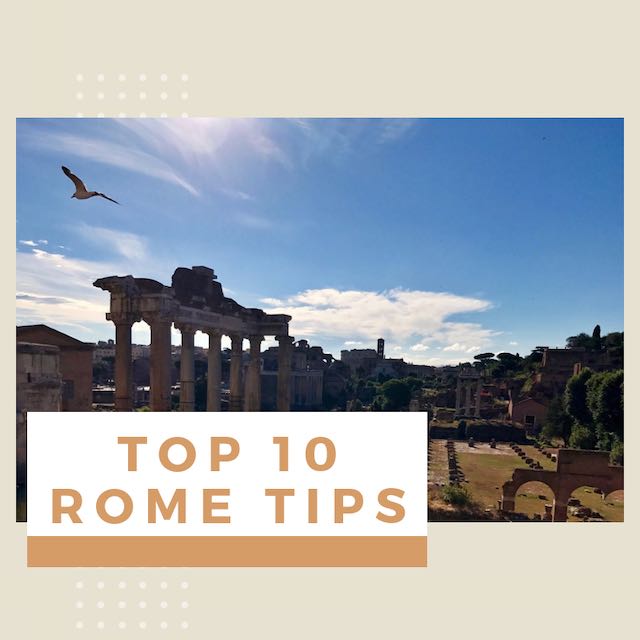
New to Romewise? Start Here
Get the most out of Romewise
Coming To Rome?
Weather in Rome
Accommodation
Already in Rome?
Things to Do
MORE CITYWISE WEBSITES:
Florencewise
Atlantawise
Citywise LLC
Home | About Me | STORE | Privacy Policy | Legal Disclaimer | Affiliate Disclosure | Contact Me
Copyright © 2009-2024 by Elyssa Bernard, Romewise.com | All Rights Reserved.
Rome catacombs: how to visit + what you need to know
All you need to know about Rome catacombs: what they are, where they are, the best catacombs in Rome to visit and how to book a tour.
The catacombs are one of the most fascinating underground attractions in Rome .
Rome’s catacombs are early Christian cemeteries , dating from the early days of Christianity in the Roman Empire.
They develop as an extensive network of underground tunnels and they are one of the most fascinating ancient Christian sites in the city.
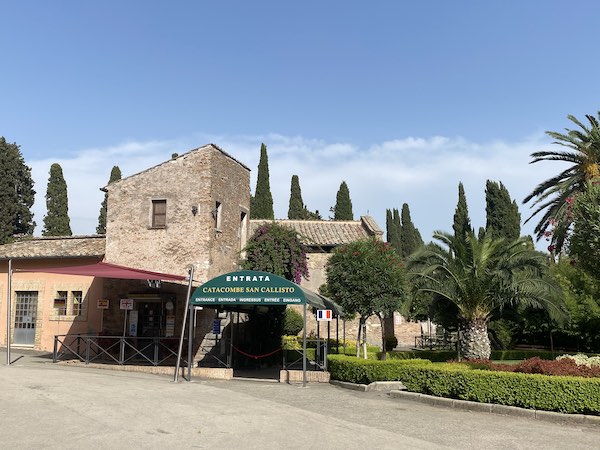
There are several catacombs in Rome, all wonderful for different reasons.
In this guide, I share fun and intersting facts about the Rome catacombs and tips to plan your visit.
Since photography is not allowed inside the catacombs, I added images of the outside and the free info panels at San Callisto, showing drawings of the catacombs.
Safe travel planning!
Please note: this post contains affiliate links and, should you make a purchase through them, we might make a small commission.
Table of Contents
What are the catacombs of Rome? Essential catacombs facts at a glance
- Rome catacombs are underground, early Christian cemeteries
- The Catacombs of Rome date from the II century AD and stayed in use until the V century
- They are excavated in tufa, a volcanic rock typical of central Italy
- The catacombs spread over several kilometres. The catacombs of St Callixtus alone are over 20km long!
- The catacombs develop over several floors and get to a depth of over 20mt underground
- The catacombs of Rome hosted the remains of many saints, martyrs and Popes
- The catacombs were abandoned in the Middle Ages
- The were rediscovered during the Renaissance(XVI century) and partially restored and made accessible in the XIX century
- There are many catacomb complexes in Rome, only some of which are open to the public
- Visits to the catacombs are by guided tours only
How to visit Rome’s catacombs
There are five catacombs in Rome currently open to visitors and managed by organisations offering guided tours.
Due to the nature of the site, access to the catacombs is by guided tour only: booking is essential.
Need to know : access to the catacombs is by steep steps that are not suitable to people with mobility impairments. Due to the underground nature of this site, the catacombs are always cold: bring a shawl even in the hight of summer! See more tips about what to wear for your visit at the end of this page.
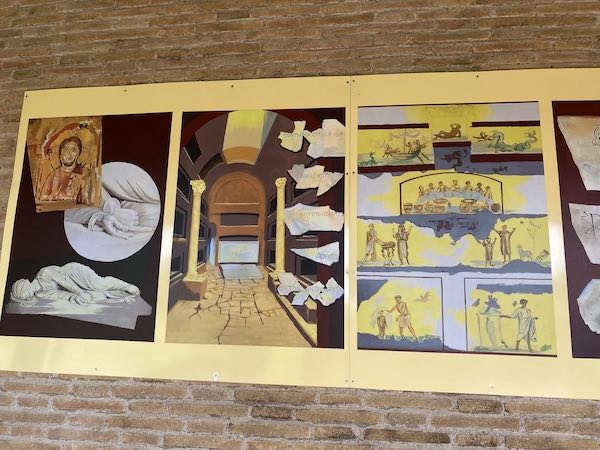
The Catacombs of St Callixtus – recommended for a first visit
The Catacombs of St Callixtus (Catacombe di San Callisto) are the largest in Rome and the most visited.
The are along Via Appia, in an area with several other significant attractions such as the Quo Vadis Church and ancient Roman Tombs.
They are managed by the Vatican, via the Religious Congregation of the Salesians Don Bosco.
Guided tours are available in several languages; you can book online here .
The tour is excellent and aI found it to be the most informative I have take so far.
This is why I recommend this a a tour of choice for a first catacomb visit. the tour is child friendly (school age and up for accessibility and type of attraction – see below)
The Catacombs of Saint Callixtus date from the II century AD and are one of the most important Christian sites in Rome.
They are there esting place of over half a million Christians and count, among their original residents, St Cecilia and many Popes, resting in a chamber aptly called ‘Little Vatican’.
The most noticeable things in the catacombs of St Callixtus are the tunnels themselves, a stunning statue of St Cecilia, now marking her original burial niche, the ancient frescoes in some of the wealthiest chapels and the impressive Little Vatican, a powerful place for Christians especially.
The visit to the Catacombs of St Callixtus lasts about 45 minutes and includes a talk explaining what the catacombs are and how they came to be and a walk though the tunnels.

Catacombs of San Sebastiano
The catacombs of ST Sebastian are also located on Via Appia, only a short distance from those of St Callixtus.
These are among the most ancient catacombs in Rome and are wonderful especially for the beautiful frescoes that still decorate the chamber known as the cubicle of Jonah , dating from the IV century AD.
The catacombs of St Sebastian started as a pagan burial area and became Christian cemeteries in the II century, when they were dedicated to St Peter and St Paul.
They owe their name to St Sebastian, who died martyr in Rome and whose remained where moved here by matron Lucina, who saw the Saint in a dream and felt called to give him proper burial in this location.
You can visit the Catacombs of St Sebastiano with the aid of a guide. You can book your tour here .
Catacombe di Priscilla
The catacombs of Priscilla are located in the north of Rome, close to via Salaria, and are unique as they are where you find the first ever depiction of the Virgin.
The fresco represents Mary with the Christ Child on her lap and dates from the IV century AD.
Access to these catacombs is by guided tour, you can book your ticket here .
These are among the best and most interesting catacombs in Rome.
I recommend a visit especially to visitors with religious interests, Christian art lovers and to families with kids, as they are beside the large Villa Ada park.
Catacombs of Domitilla
Domitilla Catacombs are on Via Ardeatina, in the south of Rome. They have tunnels over 17 kilometers long, they develop over four levels and were the burial grounds of over 150,000 Christians.
They are most famous for being the resting place of St Nereus and Achilleus, who were buried here in the IV century AD and they are also home to a unique site: a partially underground basilica, dating from the Pontificate of Pope Damasus 366-384 A.D.
Access is by private tour only: you can book your ticket contacting the catacombs office directly here .
Catacombe di Santa Agnese
The catacombs of St Agnes are under the stunning Christian complex of St Agnes’ Basilica and Costanza’s mausoleum, in the north of Rome.
The catacombs develop under the church and take their name from St Agnes, who is celebrated here and in the church of Sant’Agnese in Agone in P iazza Navona , where you canals see her relic.
These catacombs are lesser visited than others in Rome; however, they are interesting, especially if you combine your visit to the church of Sant’ Agnese and the unique Christ of Santa Costanza beside it, which is a rare example of round church in Rome.
You can arrange a tour of the catacombs contacting the parish office here
Visiting Rome catacombs with kids
The catacombs are an interesting site for kids; however, due to the nature of the attraction and the the logistics of its accessibility, they may pose challenges to families with small kids.
Based on my experience visiting the Rome catacombs with kids, I believe it is important to know the following things.
The catacombs are not stroller friendly : access is by steep steps and due to the humidity in the tunnels, they can be slippery.
If you plan to visit the catacombs with a baby , a baby carrier and proper shoes are essential.
Also, always hols handrails when climbing down as it is very easy to slip!
I do not recommend visiting the catacombs with a toddler : while it is technically possible, it is of paramount importance that they do not trot ahead or ever leave your side.
Getting lost here is very easy and there are over 20km of tunnels: while safety precautions are in place, it is not a chance you want to take!
They also have no interest for small kids since there is nothing they can touch or engage with except the echo – which is fun for them to experiment with but not ideal for you or anyone else present..
Kids of primary school age and up are likely to love the catacombs: the underground tunnels and the history of the place is likely to pique their attention and curiosity.
However, I recommend you take into account that these are cemeteries and that you will hear stories of gruesome deaths and see the graves of babies and children.
This may or may not be an issue for your children, however, I believe it is essential to be prepared.
A grave of a young child, even if very ancient, is the one thing my daughter remember the most about the whole experience. Preparation is key.
I believe the catacombs are a fantastic site to visit in Rome with teenagers .
Those I recommend with them are those at St Callisto , which you can combine with a bike trip along Via Appia.
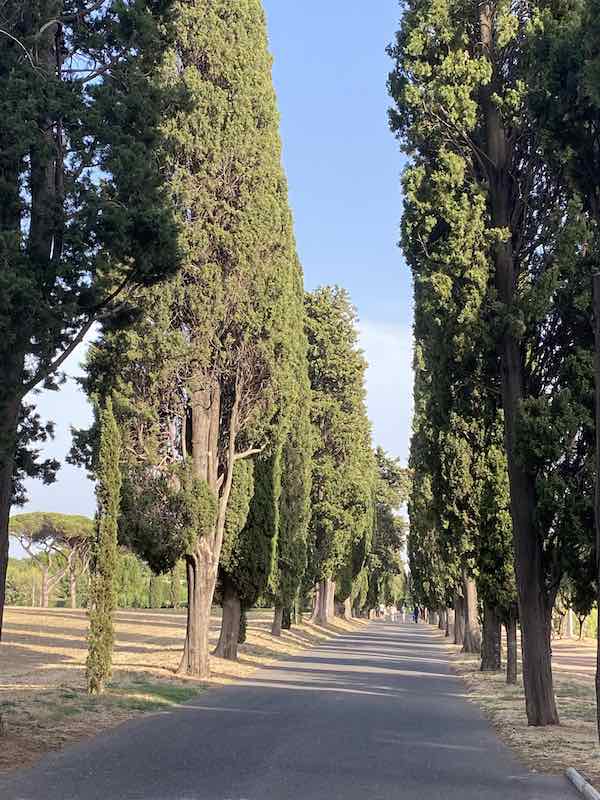
More interesting facts about the Catacombs of Rome
The catacombs of Rome are early Christian underground cemeteries.
According to the Vatican, Christian catacombs started under Pope Zephirinus (199-217).
To answer the growing need for a safe burial ground for Christians, he assigned to soon-to-be-Pope Callixtus the task of managing the burial grounds on Via Appia and turn it into a Christian cemetery, able to host the remains of Popes and fellow Christians alike.
The cemetery grew over time and became a vast underground city for the dead.
The same concept replicated in several areas of Rome so now we can visit several catacombs, in different parts of the city.
What are Rome catacombs made of?
The catacombs are excavated in a type of stone that is typical of central Italy and called tufa.
This material is very malleable when underground but become very strong and resistant once exposed to air.
This characteristic means that diggers ( fossores , in Latin) were able to efficiently excavate long tunnels and burial slots that were then solid and able to stand the test of time once completed.
The excavation would have started with one layer of underground niches, like a modern cemetery; as the need for space grew, diggers would go deeper, adding more and more corridors.
The biggest catacombs in Rome are over 4 storey deep, each storey hosting several rows of burial slots on each side of its walls and numerous chambers.
What do the catacombs look like?
Pleas note: Photography is not allowed inside the catacombs.
The catacombs are a network of long underhand tunnels.
You enter them by rather steep staircases leading you several stories underground and they spread like tall, meandering corridors.
Along their walls, there are slots excavated to accommodate a lying body. Each wall has several niches, one on top of the other, to allow the use of all the space possible.
Each slot would have been covered with a burial stone and had space for a small oil burning lamp, for light and hygene.
As you walk along the corridors, you also encounter chapels and bigger chambers.
These were mausoleums belonging to the wealthiest families or, in the case of the catacombs of St Callixtus, the burial chapel for Popes.
Overall, you experience the catacombs like an underground city, with streets (corridors), crossroads (the network is vast) and a mix of more modest homes and beautifully decorated ones.
What does ‘catacombs’ mean?
The word catacombs comes from the elating ad catacumbas , which in turn seems to come from the Greek expression kata koumbas = at/among the grottos.
How dark are the catacombs? Can I visit if I suffer from claustrophobia?
Since they are underground, there is not natural light in the catacombs.
The areas accessible to the public are now lit up by electric lighting but, back in the day, the small burial lamps and torches would have been the only light sources.
Currently, the catacombs are not ideal if you suffer from claustrophobia but they are well lit and ventilated, so the overall feeling is not too oppressive.
What to wear to visit Rome catacombs
There are two main items you need to visit the catacombs in Rome:
A shawl or a cardigan and good walking shoes.
The shawl/cardigan is essential in all seasons: the catacombs are cold and stay at a temperature of about 16C/61F degrees.
This is regardless of the temperature outside: the last time we visited, we have 35C/95F degrees out and 16C/61F in – make sure you have an extra layer you can easily out on/ take off!
In terms of shoes, I recommend you opt for comfortable shoes with rubber sole: this is to help you with the long walking required and also to give you extra grip on the steps. Avoid flip flops at all costs.
You can find here >>> my tips on the best shoes for Rome .
I hope you found this quick guide to the Rome catacombs useful and it helped you plan your visit. Safe travels to Rome!
My name is Marta, I am a travel-loving mama born and bred in that messy, wonderful, infuriating, awe-inspiring unbelievably beautiful city that is Rome. A classics graduate and professional travel blogger, on this site I share my insider tips to help you plan your dream trip to Rome, Italy.
Underground Rome: the best subterranean ruins in Rome + how to visit
How many days in rome recommended rome itineraries you’ll love for 1 to 5 days in rome, you may also like, 50 free things to do in rome you’ll..., american breakfast in rome: 5 delicious addresses you’ll..., best things to do with kids in rome..., the 29th of june in rome: what you..., the best things to do in rome at..., villa borghese gardens: how to visit, best things..., outdoor swimming pools in rome you’ll love this..., how to see rome in two days: perfect..., fun and interesting facts about the colosseum for..., christmas markets in rome you will love this..., privacy overview.

- Things to do
- Tourist Attractions
Catacombs of Rome
The Catacombs of Rome are former underground burial grounds that date from the second to the fifth century and were principally used by Christians and Jews.
The catacombs are subterranean passageways that were used as place of burial for a number of centuries . The burials of Jewish, pagan and early Christian Roman citizens in the catacombs began in the second century and ended in the fifth century.
The word catacomb, which means "next to the quarry", comes from the fact that the first excavations to be used as a place of burial were carried out in the outskirts of Rome, next to the site of a quarry .
The reason for the catacombs
The Christians did not agree with the pagan custom of burning the bodies of their dead, for which reason to solve problems created from a lack of space and the high price of land they decided to create these vast underground cemeteries.
The catacombs possess a huge number of subterranean passageways that form real labyrinths that are several kilometres long , along which rows of rectangular niches were dug out .
The corpses were wrapped in a sheet and placed in the niches, which were then covered with gravestones made of marble or, more commonly, baked clay. Subsequently, the name of the deceased was carved on the cover accompanied by a Christian symbol .
Roman law at the time prohibited the burial of the deceased in the interior of the city, for which reason all of the catacombs were located outside of the walls. These separated and hidden places below ground constituted the perfect refuge in which the Christians could bury their own, freely using Christian symbols .
The end of persecutions
On signing the Edict of Milan in the year 313, the persecution of Christians ceased , and they could begin to build churches and acquire land without fear of confiscation. In spite of this they continued to use the catacombs as cemeteries until the 5th century .
During the barbarian invasion of Italy in the 8th century many catacombs suffered continuous lootings, for which reason the Popes caused the still remaining relics to be transferred to the city's churches . After these transfers, some catacombs were abandoned completely and forgotten for centuries .
In Rome there are more than sixty catacombs made up of hundreds of kilometres of underground passageways that hold thousands of tombs. Currently only five of them are open to the public :
- Catacombs of San Sebastiano (Via Appia Antica, 136): These 12 kilometre long catacombs owe their name to San Sebastiano, a soldier who became a martyr for converting to Christianity. Together with those of San Callisto they are the best that can be visited. Opening times are Monday to Saturday from 9:00 to 12:00 and from 14:00 to 17:00.
- Catacombs of San Callisto (Via Appia Antica, 126): With a network of passageways over 20 kilometres in length, the tombs of San Callisto were the burial place of 16 pontiffs and scores of Christian martyrs. Opening times are Thursday to Tuesday from 9:00 to 12:00 and from 14:00 to 17:00.
- Catacombs of Priscilla (Via Salaria, 430): These hold some frescoes that have great importance for art history, such as the first representations of the Virgin Mary. Opening times are Tuesday to Sunday from 9:00 to 12:00 and from 14:00 to 17:00.
- Catacombs of Domitilla (Via delle Sette Chiese, 280): Discovered in 1593, these catacombs, which are more than 15 kilometres in length, owe their name to the granddaughter of Vespasian. Opening times are Wednesday to Monday from 9:00 to 12:00 and from 14:00 to 17:00.
- Catacombs of Sant’Agnese (Via Nomentana, 349): After being a martyr because of her Christian faith, Sant’Agnese was buried in the catacombs that subsequently bore her name. Opening times are from 9:00 to 12:00 and from 16:00 to 18:00; the catacombs are closed on Sunday mornings and Monday afternoons.
How to get to the Catacombs
To visit the catacombs, you have several options:
- Take a tour : reserving a visit is the easiest way of visiting the catacombs and monuments on the Via Appia. Here you can reserve a tour which includes transport, tickets, and an official guide.
- Public bus : although it's the cheapest way to get there, you can lose plenty of time heading there on your own. The 118 and 218 lines head to San Calixto and San Sebastián, and lines 218 and 716 go to Domitila.
- Taxi : the high price, and difficulty in finding a taxi for the return journey to Rome means we don't recommend this option.
A walk through the insides of Rome
The catacombs of Rome offer a very special visit in which the funeral remains of those buried many centuries ago can be seen. It is fascinating to travel through the dark and damp passageways, where you can see, in addition to the niches, some inscriptions with the names of the people that once occupied them.
Due to the high infant mortality at that time, you can see a large quantity of spaces prepared for these children, alongside some larger graves in which the whole family was buried .
During the visit, a guide who is specialized in the topic gives the visitors several interesting facts relating to the catacombs and the period in which they were operating . The guided tours are in Spanish and are included in the cost of entrance.
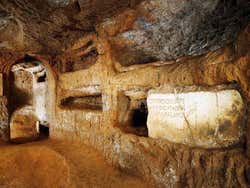
Various locations
Adults: € 8 ( US$ 8.80) Children (less than 15): € 5 ( US$ 5.50) Includes a guide in English
Rome Catacombs Tour & Appian Way € 40 ( US$ 44)
Nearby places
Baths of Caracalla (3.2 km) Basilica of St. John Lateran (3.3 km) Basilica of St. Paul Outside the Walls (3.4 km) Basilica di San Clemente (3.9 km) Circus Maximus (4.2 km)
You may also be interested in
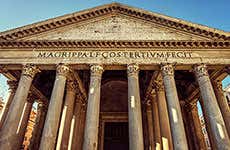
The Pantheon, completed in 126AD, was a Roman temple with a surprising oculus that is the building's main source of natural light.

Vatican City
The State of Vatican City, in the centre of Rome, is the smallest state in Europe, both in population and expanse. It's the head of the Catholic Church and also one of the main tourist sites of interest in the whole of Rome.

- Nov 9, 2023
- 15 min read
A Guide to Rome Catacombs: Everything you Need to Know
Updated: Nov 14, 2023
Introduction:

Rome's catacombs represent a historical intertwining of faith, death, and the art of burial, offering an unparalleled glimpse into the spiritual life of the early Christians. As you consider delving into this subterranean world, here's a comprehensive guide to prepare for your journey.
Origins of the Term 'Cemetery'
The term "cemetery" holds its etymology in the Ancient Greek word meaning "place of rest," reflecting a serene finality. The catacombs of Rome, an intricate labyrinth of narrow passageways beneath the city’s edge, encapsulated this sentiment. Here, the first Christians in Rome found their final resting place, an intricate underground network that bore witness to their hope for resurrection and salvation.
The Catacombs: Rome's Underground Enigma
A journey into the catacombs is like a descent into the pages of history. These catacombs were not only the resting place of martyrs and saints but also of everyday individuals like farmers—all part of the nascent Christian community. The vastness of these subterranean tunnels, housing hundreds of thousands of the deceased, is a humbling reminder of the past. Located adjacent to the venerable Appian Way, these catacombs present an entangled maze so complex, that without a knowledgeable guide, one could become a permanent addition to its ancient enigma.
Subterranean Symbolism: The Catacombs' Spiritual Significance
Visitors are often captivated by the catacombs' spiritual resonance, an echo of the enduring faith of those who once walked the streets of ancient Rome. These catacombs are an emblem of the trials and tribulations faced by early Christians and their unwavering hope for a life beyond death.
A Modern Pilgrimage: Touring the Appian Way and Catacombs
Embarking on a tour along the Appian Way is a journey through time. The road itself is lined with relics and whispers of the past, from imposing tombstones to the picturesque Roman countryside. Yet, the catacombs remain the centerpiece of this historical pilgrimage. Venturing deep beneath the earth, visitors traverse corridors carved with the simplest of tools, an enduring testament to the sheer will and devotion of Rome's early Christians. These tours do more than illuminate history; they provide a profound connection to the nascent moments of Christianity—a Rome seldom seen and rarely experienced.
Ensuring a Memorable and Enlightening Experience
A visit to Rome's catacombs is more than a simple tourist excursion; it's an emotive expedition offering insight into the world of those who lived two millennia ago. By choosing to explore these ancient passageways with a guide, one not only ensures safety but also gains access to the rich tapestry of stories and historical context that might otherwise remain buried in the sands of time.
Remember, the catacombs are not merely an attraction; they are hallowed ground, a place of deep historical and religious significance. As such, visitors are encouraged to approach with respect and a readiness to discover the profound legacy of Rome's early Christian ancestors.
Table of Contents:
What are the catacombs, history of the catacombs in rome, facts about rome's catacombs, visiting rome's catacombs, tickets for the catacombs, what to see at the catacombs, insider tips.
In Conclusion
Crypts & Catacombs Tour
Rome Catacombs Tour
Understanding the Catacombs: Rome's Underground Sanctuaries
The catacombs of Rome stand as enigmatic portals to the ancient past, beckoning the curious to uncover the sacred practices of early Christian burials. Here, we delve into the essence of these cryptic tunnels and the traditions that led to their creation.
The Birth of the Catacombs
The Appian Way, one of Rome's oldest and most significant roads, serves as more than a historical thoroughfare; it is a bridge to the city's ancestral rituals. The catacombs here were not a mere matter of choice but a necessity, as early as the 5th century BC, due to Roman law prohibiting burials within the city's sacred boundaries. This led to the establishment of necropolises at the city's margins, with the Appian Way, the crucial artery to the south, becoming a preferred burial ground.
A Refuge for the Deceased
For Romans, the commemoration of the dead was an affair marked by roadside monuments and elaborate tombs. In contrast, early Christians opted for a more discreet, communal form of burial, carving out extensive networks of tunnels into the soft volcanic tufa rock beneath Rome. These catacombs became the final resting place for a multitude of believers, from the most venerated saints and martyrs to the multitude of unsung Christians.
The Appian Way's Holy Underground
The catacombs along the Appian Way are significant not only for their spiritual importance but also for their historical and architectural merit:
The Catacombs of St. Domitilla (Santa Domitilla):
As the oldest and most sprawling catacomb complex, it showcases the longevity and extent of early Christian burials, offering visitors a rare glimpse into antiquity with some areas still adorned with skeletal remains.
The Catacombs of St. Callixtus (San Callisto):
This is the most extensive and frequently visited network, renowned for its early Christian art, a testament to the faith and artistic expression of the era's devout.
The Catacombs of St. Sebastian (San Sebastiano):
A site of significant pilgrimage, reputed to have once cradled the remains of Apostles Peter and Paul, and home to a treasure trove of ancient Roman and Christian tombs, epitomizing the confluence of cultures.

A Tour Through Time
Embarking on a catacomb tour is to step into the past, tracing the hallowed steps of history. Each catacomb offers a unique narrative, a distinct glimpse into the socio-religious fabric of early Christianity. As you traverse the labyrinthine corridors, you encounter not only the sacred silence of the crypts but also the evocative artwork and inscriptions that speak volumes of a bygone era's beliefs and ways of life.
In conclusion, Rome's catacombs are not simply ancient tunnels but sanctuaries of history. They serve as a testament to the resilience of faith and the human spirit in the face of adversity and temporal law. Through these tours, visitors can connect with the distant past, engaging with stories etched into the very stones beneath Rome's bustling life.
Tracing the Epochs: The Evolution of Rome's Catacombs
The catacombs of Rome offer a silent narrative of the city's transformation from the zenith of imperial grandeur to the symbolic heart of Christianity. This section unveils the catacombs' historical journey and their significance in the broader tapestry of Rome's history.
The Contrast of Ancient Burial Customs
As one strolls the Appian Way, the stark disparity between ancient Roman and early Christian burial practices is evident. Grand monuments like the Mausoleum of Cecilia Metella stand as a testament to the wealth and power of Rome's elite. These opulent edifices, erected for the nobility, contrast sharply with the modest beginnings of Christian burial sites. Unable to afford such lavish memorials, the early Christians sought refuge in the subterranean depths, carving out their sanctuaries beneath the land.
The Christian Underground: A Realm of Equality
The catacombs became the great equalizer in death. Here, the bodies of hundreds of thousands of Christians, from revered saints and martyrs to common folk, were interred on multi-tiered shelves, a humble yet poignant reminder of the community's unity in faith and fate.
Middle Ages to Modern Rediscovery
With the catacombs falling into disuse by the Middle Ages, they slipped from the collective consciousness of Rome, their entrances overgrown and their memory fading into legend. It was not until the resurgence of interest during the 18th century, particularly among the intrepid travelers of the Grand Tour, that the catacombs were thrust back into the limelight. Intrepid explorers, drawn by the allure of the past and the thrill of discovery, ventured into the catacombs’ enigmatic embrace, guided by the flicker of candlelight.
The Catacombs Today: A Journey into the Past
Today, although stripped of bones and the physical remnants of those who once lay within, the catacombs remain a poignant pilgrimage site. They invite the modern visitor to step away from the sunlit splendor of Rome into the dimly lit passages that once cradled the city's earliest Christian ancestors. These tours are not only an exploration of the physical tunnels but also a journey through the annals of early Christian history, offering an alternative perspective on Rome's cultural and religious evolution.
The catacombs, now absent of their original occupants, continue to captivate those who seek a deeper understanding of Rome's complex past. Each silent corridor and empty tomb offers a story, an indelible connection to the lives and beliefs of the early Christians. For today's seekers of history or the simply curious, Rome's catacombs stand as an enduring testament to a faith that once, and still, shapes the world above.
Deciphering the Catacombs: Revelations from Rome’s Underground Labyrinths
The catacombs of Rome hold countless stories in their silent chambers, their origins and rediscovery as shrouded in mystery as the tunnels themselves. This section aims to illuminate some intriguing facts about these subterranean wonders.
Etymology and Origin of 'Catacomb'
The term "catacomb" itself whispers of antiquity, rooted in the Greek words 'kata' and 'kymbas', suggesting proximity to caves. Adopted into Latin as 'cata tumbas', it aptly described the resting places nestled among the graves along the Appian Way. These ancient names evoke the catacombs' essence as communal resting places by the caves.
A Serendipitous Rediscovery
Antonio Bosio, the intrepid explorer of the 16th century, stumbled upon the catacombs almost as if by fate, his quest nearly leading him to a permanent residence among the ancient dead of St. Domitilla. His subsequent work, "Roma Sotterranea," became a foundational text for the archaeological community, offering insights and guidance into the catacombs' depths that continue to benefit researchers and historians today.
St. Domitilla and Her Legacy
The Catacombs of St. Domitilla carry the legacy of a devout Christian woman from the influential Flavian family, cast into exile and ultimately finding eternal rest in a familial mausoleum that would later bear her name. The catacombs emerged as a poignant homage, a place where faith and social status intersected in death.
Resting Places of Saints and Martyrs
Throughout the warren of catacombs, saints were interred, their remains sometimes relocated to other sacred sites as their veneration grew. The notable shifts of St. Cecilia to a cathedral in Trastevere and the absence of St. Sebastian, St. Peter, and St. Paul from the catacombs bearing St. Sebastian’s name reflect the evolving landscape of religious relics. However, the catacombs still cradle the remains of lesser-known martyrs and saints, serving as hallowed pilgrimage destinations.
The Unseen Labyrinth
Today's catacomb tours offer but a glimpse into the sprawling network that ancient Rome's Christians created. What visitors traverse is a mere fragment of the entire subterranean matrix, with vast sections remaining shrouded in darkness, their secrets locked away in history. Archeologists continue to theorize about the full scale of these underground sanctuaries, suggesting an expansive complex that might never be fully uncovered or understood.
The catacombs of Rome, in all their elusive grandeur, stand as a testament to early Christian life and death, a reminder of a community that thrived on the edges of ancient society. They beckon the living to remember, to explore, and to wonder at the profound legacy left in the depths beneath the Eternal City.
Unveiling the Journey to Rome's Ancient Underground: A Visitor's Guide
Embarking on a voyage to the past, the catacombs of Rome await beneath the storied cobblestones of the Appian Way. This guide is meticulously crafted to ensure a seamless pilgrimage to these venerable relics of early Christianity.
Embarking from the Heart of Rome
While the catacombs are nestled away from the bustling city center, modern Rome has embraced these ancient sanctuaries within its urban sprawl, making them accessible for the intrepid traveler. Here's how to navigate your way:
Via Public Transport: The 118 Bus Odyssey
The 118 bus, a chariot of the modern age, wends its way from the grandeur of the Colosseum, past the Circus Maximus, and onward along the Via Appia Antica. Alighting at the catacombs is made easy with stops directly in front of these subterranean marvels. To circumvent the whims of Roman bus schedules, arm yourself with real-time updates from a transport app such as Muoversi a Roma, transforming potential waits into mere moments.
The Cyclist’s Path
For those wishing to blend the joy of exploration with the rhythm of the pedals, cycling to the catacombs offers a delightful prelude to the underground tour. Rental havens near the Appian Way’s origin provide the steeds for your adventure, which can extend beyond the catacombs, especially on Sundays when the ancient road transforms into a haven free from the modern chariot's hustle.
A March through History
Only the most ardent of walkers are advised to undertake the trek to the catacombs on foot. Those setting out from points like Circus Maximus or the Baths of Caracalla will find the journey manageable, with St. Callixtus welcoming visitors a mere 20 minutes from Porta San Sebastiano. Caution is urged where the pathway wanes, as travelers must share the road with vehicles.
A Word to the Wise: Secure a Ride Home
Regardless of how you arrive, it is prudent to keep a local taxi service’s contact details at hand. Roman buses are fickle, and after delving into the catacombs' depths, even the most resilient of explorers may prefer a restful chariot ride back to the city's heart.
Effortless Explorations: The Rome Catacombs Tour
For those seeking to immerse themselves fully without the encumbrance of logistics, our Rome Catacombs Tour offers an all-encompassing experience with transport included, ensuring your focus remains on the awe-inspiring history that lies beneath.
This guide serves as your compass to navigate the terrain above before you uncover the stories of antiquity below, making your visit to Rome's catacombs a chapter in your journey as timeless as the Eternal City itself.
Securing Your Passage to the Past: Catacombs of Rome Ticket Guide
Unlocking the secrets of ancient Rome requires more than just a map and a sense of adventure. Here's your key to ensuring that your journey into the depths of the city's history is guaranteed.
St. Domitilla's Subterranean Labyrinths
Availability: Open daily, save for Tuesdays.
Admission: A portal fee of €8 opens the gates to this realm of history, with tickets procurable via an online system reminiscent of bygone days or at the on-site ticket office.
Visitation Hours: The hours of passage are from 9:00-12:00 and 14:00-17:00, providing ample time to explore the depths.
The Vast Expanse of St. Callixtus
Availability: Welcoming visitors every day.
Admission: For €8, travelers can secure their entry online or at the ticket office, ensuring access to some of the most poignant Christian art and sanctified relics.
Visitation Hours: Open from 9:00-12:00 and 14:00-17:00, St. Callixtus offers a glimpse into the spiritual heart of ancient Christian Rome.
The Sacred Ground of St. Sebastian
Availability: Open daily, except for Sundays, and closed throughout December.
Admission: Tickets are priced at €8, available exclusively at the ticket office. Advanced booking is reserved for group pilgrimages, accessible via phone or email.
Visitation Hours: From 10:00-17:00, tread the paths once walked by saints and martyrs.

Maximizing the Experience: A Guided Exploration
For those desiring a comprehensive understanding of these sacred spaces, our catacombs tour in Rome includes a thorough exploration of St. Domitilla. By joining our expert-guided tour, you can delve deeper into the catacombs' history, symbolism, and the enduring legacy of the Christians who once sought refuge and eternal rest within these walls.
When planning your descent into history, this guide will ensure your exploration is not left to chance. Prepare to step beyond the veil of time with your tickets secured and witness the catacombs of Rome as few have seen them before.
Unearthing Ancient Wonders: Highlights of Rome's Catacombs
Embark on a time-traveling expedition to the catacombs of Rome, where the whispers of the early Christians resonate through the art and symbols etched in these subterranean sanctuaries.
Marvels of St. Domitilla
Rediscovered Beauty: The catacombs here are a canvas of restored frescoes, with the spotlight on a magnificent ceiling fresco portraying Christ. The crypt known as "the room of the bakers" boasts vibrant decorations that narrate tales of ancient livelihoods and devotion. Awaiting public unveiling, these areas, along with an anticipated new museum, will soon enrich the visitor experience.
Symbols in Stone: St. Domitilla showcases an array of Christian symbols. The olive branch-carrying dove and the salvation-representing anchor are among Rome's earliest Christian art, offering insight into the symbols' profound meanings.
Pagan Artifacts: Beyond the Christian imagery, the catacombs preserve pagan splendors, such as the 3rd-century AD painted cubiculum depicting the myth of Cupid and Psyche, symbolizing the soul's journey and the power of love.
Secrets of St. Callixtus
Labyrinthine Legacy: With miles of tunnels reaching heights of 70 feet, St. Callixtus presents an underground marvel. It houses "the little Vatican," an enclave where nine popes found their resting place, their presence marked by original Greek inscriptions.
Artistic Echoes: The catacombs bear Christian frescoes adorned with timeless symbols—the fish, dove, and phoenix. Family tombs converted into sanctified chambers host some of the most significant frescoes, revealing stories of faith and life eternal.
Saint Cecilia's Crypt: While St. Cecilia's remains have been moved, visitors can still pay homage to her original burial site, a crypt steeped in reverence and history.
The Wonders of St. Sebastian
Tombs of Antiquity: St. Sebastian's catacombs offer a unique perspective with well-preserved Ancient Roman tombs, initially part of an above-ground pagan necropolis. The stucco decorations within the burial chamber are testimonies to the artistry of a bygone era.
Saintly Sculpture: Although St. Sebastian's remains are elsewhere, a Bernini-attributed bust provides a poignant reminder of the martyr's eternal legacy.
Artistic Imprints: With artifacts like Jonah's cubicle paintings and the rich frescoes adorning the mausolea, the catacombs of St. Sebastian are a gallery of ancient narratives waiting to be discovered.
In the catacombs of Rome, the stones speak, the art tells tales, and the echoes of the past invite you to look closer. Your visit promises more than just a tour; it's a pilgrimage through time, art, and faith, etched in the silent corridors beneath the Eternal City.
Navigating the Depths: Essential Advice for Rome's Catacombs
Delving into the catacombs of Rome is a journey unlike any other, a literal step down into history. To ensure a seamless and respectful experience, here are some insider tips to keep in mind:
Confronting Claustrophobia:
The catacombs are a network of narrow, hand-hewn tunnels. They're intimate and enclosed, so if tight spaces make you uneasy, prepare mentally or consider this when deciding to visit.
Sacred Dress Code:
Remember, the catacombs are hallowed ground. Dressing modestly is not just a sign of respect; it's a requirement. Shoulders should be covered, and skirts or shorts should be of a modest length.
Guided Tour Variance:
While each catacomb provides its own guides—often monks or priests—the experience may vary. Some may offer spiritual insights along with historical facts. For a more balanced exploration, consider a group tour like our San Domitilla tour for a comprehensive historical narrative.
Explore Above Ground:
The catacombs are only one layer of Rome's rich religious history. Near St. Sebastian's catacombs, visit the church of San Sebastiano fuori le mure. Marvel at the artifacts, including the saint's statue and the legendary arrow.
Trace the Steps of St. Peter:
Don't miss the church of Domine Quo Vadis, steeped in the lore of St. Peter's vision of Christ. It houses what many believe to be the marble-encased footprints of Jesus.
Dining Options:
The catacombs are somewhat isolated, with limited dining nearby. Plan ahead with a picnic in the park or indulge in a meal at local establishments like the Appian Way Café for a casual bite, or L’Archeologia for a more upscale dining experience.
Visiting Rome's catacombs is more than a simple tour; it's a pilgrimage into the past. With these tips in hand, your expedition through these ancient underground corridors will be enriched with respect, understanding, and the right dose of adventure.
In Conclusion: Embracing the Echoes of Antiquity
As our journey through the hushed and hollowed grounds of Rome's catacombs comes to an end, we are left with more than just echoes of the past; we carry with us the weight and whispers of history. These catacombs, a somber lattice beneath the bustling life of modern Rome, serve as a solemn reminder of the city's layered and spiritual heritage.
Walking the same paths that early Christians did, under the soft illumination that dances across ancient frescoes and inscriptions, is to walk through a portal in time. In these cool, subterranean galleries, we find ourselves in intimate communion with those who came before us, their stories etched in stone and preserved in silence.
The catacombs remind us of Rome's enduring legacy, one that has witnessed the full spectrum of humanity, from the mundane to the divine. They challenge us to reflect on our own existence, our beliefs, and the mark we wish to leave for future generations to ponder.
In this sanctified darkness, with the company of martyrs, saints, and countless souls, our hearts beat in unison with the timeless rhythm of history. Here, in the catacombs, Rome's eternal heart pulses, inviting us to listen, to learn, and to remember.
Whether you came seeking knowledge, solace, or the thrill of exploration, may you leave with a sense of connection to the eternal city and the countless lives that have shaped its narrative. The catacombs of Rome, with their silent majesty and enduring presence, are not just a destination but a journey—one that resonates deeply within the chambers of the soul.
Let us carry the memory of our journey into the catacombs as a treasured keepsake, a humbling encounter with the past that enriches our understanding of the human spirit. As the light of day welcomes us back from the depths, may we hold in our hearts the serene beauty and profound tranquility of the catacombs, an indelible part of Rome's immortal story.
Sacred Journeys Beneath Rome: Exclusive Catacomb Tours with Roma Experience
Embark on a profound journey through the sacred underworld of Rome with Roma Experience's bespoke catacomb tours. Whether you choose the intimate encounter of standing alone in St. Agnes' Catacomb with our "Crypts & Catacombs Tour," or the rare opportunity to uncover hidden histories with "Catacomb Tour with Exclusive Underground Access," each tour promises a unique and deeply moving exploration of the eternal city's most ancient sanctuaries. These meticulously curated experiences offer an unparalleled glimpse into the spiritual bedrock upon which Rome is built, inviting you to traverse time and tradition in the silent footsteps of the past.

Step back in time with Roma Experience's "Crypts & Catacombs Tour," where the whispers of early Christian Rome echo through the solemn corridors of antiquity. This immersive tour takes you into the heart of devotion and memory, as you stand alone in the hallowed St. Agnes' Catacomb. Traverse a sacred past across three venerable burial grounds and connect with the spiritual odyssey that shaped a world beneath the bustling streets of Rome. Prepare to be enveloped by the serene embrace of history on a journey that transcends the ages.

Rome Catacomb Tour Exclusive Underground Access
Unlock the veiled mysteries of Rome with Roma Experience's exclusive "Catacomb Tour with Underground Access." Our privileged passage opens doors to a catacomb hidden from the world for generations, inviting you on a rare expedition beneath Rome's storied landscape. With intimate insight, this exclusive tour invites you to delve into the depths of time, where each layer unravels tales of ancient lives and eternal beliefs. Stand where few have stood before and witness history unveiled in the silence of the underground.
- Religion & Culture
Recent Posts
Your Ultimate Guide To the Colosseum: Everything You Need to Know
A Guide to the Palatine Hill: Everything You Need to Know
A Guide to Ostia Antica: Everything you Need to Know about Rome's Ancient Port
Catacombs of Saint Callixtus
Tickets sell out fast in Rome: check availability now »
Explore the largest Christian catacombs in Rome.
The Catacombs of Saint Callixtus are not only the most famous of Rome’s Christian catacombs, but they’re also one of the oldest official cemeteries of the Church of Rome. Visit the tombs of popes, martyrs, and half a million Christians in this subterranean complex.
- Discover the Crypt of the Nine Popes, known as ‘the little Vatican’ of the cemetery.
- Marvel at the mosaics and frescoes covering the walls of the Crypt of St. Cecilia – the patron saint of music.
- Try to decode the carvings of early Christian symbols found on the walls and tombs – see if you can spot the phoenix.
Tickets & Prices
Enjoy a 45-minute guided tour of the catacombs and its highlights with an official live tour guide. You’ll delve deep into the history of the cemetery and learn about the period of Christian persecution in Rome, hear interesting stories about some of the occupants of the tombs, and discover the meaning behind the mystifying symbols etched into the stone.
Find out which ticket best suits your needs with this handy guide below.
- Guided Tour – 40-minute guided tour of the Catacombs.
- Panoramic Bus Transfer & Guided Tour – Get picked up from the city center and enjoy the views along the way with this direct return transfer ticket to the Catacombs. Includes a guided tour.
- Hop-on Hop-off Bus, Travel Card, & Guided Tour of St. Callixtus Catacombs – This ticket gives you 24-hour access to Hop-on Hop-off open buses (Vatican & Rome) and all forms of public transport within the Comune di Rome (urban, underground, and overground + Rome-Ostia train route in both directions). With entrance and a guided tour of the Catacombs included.
Standard Admission Fee and Concession Tickets
For standard tickets.
- Reserve your ticket online. Simply choose the language you wish to hear the tour in, select the date of your visit and your ideal time slot, fill in your personal details, and receive a confirmation email.
- On the day of your visit, you’ll pay at the ticket office after showing confirmation of your reservation (either in printed or digital form). Both cash and all major cards are accepted.
- You’ll then wait at the flag of your language until called by your tour guide.
- Tours are conducted in Italian, English, Spanish, French, German, and Polish.
For Concession Tickets
With this ticket, you’ll experience the same booking process and guided tour as the standard admission ticket. Find out if you’re eligible for a concession ticket below.
This ticket is intended for:
- Children from ages 7 to 16.
- Students of archeology, architecture, art history, or cultural studies up to 25 years of age (with proof of eligibility).
- Priests, novices, or seminarians (with proof of eligibility).
- School groups.
Free Admission
This ticket also grants you the full experience provided by the standard admission ticket, and the booking process is also the same. Some individuals are eligible to enjoy a free admission ticket. Find out below if this applies to you.
- Children under the age of 7.
- Disabled visitors and their companions.
- Students from the Pontifical Institute of Christian Archeology
- Salesian brothers of Don Bosco, and sisters of Mary, Help of Christians
- Professors, teachers, and catechist teachers accompanying groups of 15 and over.
- Two complimentary tickets for groups of at least 35 people when paying the standard admission fee.
- Licensed tour guides (with proof of eligibility).
- Researchers who make a request to the Pontifical Commission of Sacred Archeology.
Catacombs of St. Callixtus: Guided Tour
Experience a 40-minute guided tour with a live guide with this immersive ticket. Discover the history behind this underground cemetery, and walk around the tombs of the early popes and martyrs buried here.
This ticket is very similar to the standard admission ticket. Buy this ticket if you want the option to pay for your ticket online and to have the flexibility of free cancellation.
- Choose the date and time slot that best suits you online. Enter your personal details and pay by credit/debit card, PayPal, or AliPay.
- The tickets will be sent to your email, which you can then print out or show directly from your smartphone.
- Arrive ten minutes before your intended tour. Show your ticket, and you’ll be directed to your guide.
- Free cancellation until 23:59 on the day before your visit.
- Guides are available in English, French, German, Italian, and Spanish.
Additional Information
- The catacombs are open every day except Wednesdays from 9:00 – 12:00 in the mornings and 14:00 – 17:00 in the afternoons. The ticket office closes at 16:50.
- Wheelchairs are not permitted within the catacombs, and those with severe mobility issues may encounter walking difficulties.
- It is forbidden to take pictures or videos inside the catacombs.
- Remember to bring something to cover up, as it’s chilly and humid down in the catacombs.
How to Get There
The Catacombs of St. Callixtus are 20-30 minutes from the city center, depending on the traffic.
The best way to reach the Appian Way and the catacombs is by bus. There are 2 options:
Departing from San Giovanni ( metro line A), this bus does the first part of the Appian Way , then goes right when the road forks at Quo Vadis church.
Stay on board for a few more minutes until the Fosse Ardeatine stop, and you’ll almost be opposite the back entrance to the catacombs. The gate is above you on the other side of the road and is open whenever the catacombs are.
The Fosse Ardeatine bus stop seen from the back entrance to the Catacombs of St. Callixtus
You can catch this bus from the Circo Massimo (the bus stop is around the corner on Viale delle Terme di Caracalla) or Colosseo metro stops (line B). You should get off at the stop at Catacombe San Callisto, and you’ll see the entrance to the catacombs.
You can also get there by bike. Bikes can be rented at the Circus Maximus or the beginning of the Appian Way. There are also bike tours that include a visit to the catacombs. If you arrive by bike, there is a bike parking area inside the complex to the right before you reach the ticket office.
Walking to the catacombs will take about 45 minutes. You can either leave from the Circo Massimo metro, take Viale delle Terme di Caracalla, and continue in a straight line for about 40 minutes until you reach the catacombs, or start from San Giovanni and follow the ancient walls to Porta San Sebastiano and the beginning of the Appian Way, then turn left. Sunday is the best day to walk when most of the Appian Way is closed to traffic.
When to Visit
The catacombs of Saint Callixtus are closed on Wednesdays. If you are only able to visit the catacombs on Wednesdays, the nearby Catacombs of Saint Sebastian are open every day.
What to Wear
Inside the catacombs, it’s 16°C / 60°F, even when it’s hot outside. Initially, it’s wonderfully cool, but it will get chilly if you don’t cover up. You should wear closed shoes and bring something to cover your shoulders and back. However, although this is a religious site managed by the Vatican, they don’t impose a dress code on visitors.
When you arrive, go first to the ticket office. If you have bought your ticket online, show them the booking, and you’ll receive a ticket. If you haven’t got your ticket already, you can buy them for the next available timeslot.
You cannot use your Roma Pass here.
Tourist passes are not valid here
The ticket includes a guided tour as it’s not possible to visit the catacombs without a guide. When you buy your ticket, you’ll be asked to select the language you would like. There are tours throughout the day in English, Italian, French, Spanish, and German.
You have to wait in front of the language of your tour just before the time on your ticket. There are regular announcements informing visitors when to line up for the next tour.
Line up next to the right language
When the gate in front of the flag is opened, a member of staff will tear off part of your ticket and invite you to enter.
The tour starts outside with an overview of the catacombs. The guide uses boards to explain how the catacombs were built, but if you aren’t at the front, it can be difficult to see.
The first part of the tour is explained outside
After the introduction, you enter the catacombs down a steep flight of steps. From this point, you cannot take photos or videos.
The Catacombs of Saint Callixtus are the biggest and most famous of the catacombs, so you can expect to find a lot of groups there at the same time.
Each group can have up to 50 people, and there will be groups in front and behind you, so the guides have to keep moving and won’t answer questions during the tour.
The guide uses a microphone, but the visitors do not have headsets, so you might find it difficult to follow everything that is being said. If you’re part of a large group, the guide might be inside a room talking, and some of the group is left outside, unable to see or hear.
The tour visits the Crypt of the Popes, leaders of the church in the 3 rd century when Christians were persecuted in Rome. Other Roman martyrs were also buried here, like Saint Cecilia, whose statue is in one room, though their remains were moved into the city after Christianity was legalized.
Along the way, you’ll pass many corridors lined with tombs and see some of the larger cubiculum, family tombs of more wealthy residents, with wall paintings with Christian stories and motifs.
Accessibility
To enter the catacombs, you must be able to walk up and down steep steps and walk at a slow pace for 30 minutes.
With limited light underground, the visit may not be suitable for those with impaired vision.
The tour also isn’t recommended for anyone who suffers from claustrophobia. Although none of the tunnels are particularly small (most are about 1m wide), they are extensive. You won’t be able to see the exit, and the guide cannot leave the group to assist you outside, so be sure you are comfortable with this before the visit.
In the small complex, there are vending machines for coffee and snacks, water fountains, toilets, and areas for sitting in the shade while you wait for your tour to start. There’s also a gift shop selling rosaries, books, paintings, and postcards.
Inside the gift shop
Surroundings
The Appian Way is one of the most beautiful green areas in Rome, so it’s worth adding an hour or so to your visit to explore part of it. The way is well-signposted. Just follow the signs for Appia Antica after your tour.
Directions are easy to follow
A 20-minute walk will take you to some of Appia Antica’s most beautiful sites. If you go on a hot day, make sure to cover your head as there’s very little shade.
The Basilica of Saint Sebastian
There are other catacombs underneath the basilica, where the bodies of St. Peter and St. Paul were kept. Stop at the basilica to see the statue of St. Sebastian, the Roman soldier who was shot to death by arrows (a popular subject with Roman artists), and Bernini ’s final statue.
The Basilica of St. Sebastian
The Stadium of Maxentius (Closed Mondays)
Many people don’t know that the Circus Maximus isn’t the only stadium remaining in Rome. This one was built on the private land of the emperor Maxentius and is much better preserved than the Circus Maximus. You can walk inside (entrance is free) and get lovely views of the Tomb of Cecilia Metella.
The Circus of Maxentius
The Tomb of Cecilia Metella (Closed Mondays)
The circular tomb of a Roman noblewoman was made into a fortress in the 12 th century.
The Tomb of Cecilia Metella
Part of the Original Roman Road
Part of the original Roman road
In this same area, there are several places where you can stop for lunch. It’s best to book, especially on Mondays when several of them are closed.
There are many places to stop for lunch on the Appian Way
Did you Know That: 4 Interesting Facts
- Although only some areas are accessible to the general public, the whole complex of the catacombs spans five underground levels over an area of 90 acres.
- The reason the catacombs lie so far from the historic center is because of an Ancient Roman law that prohibited the burial of the dead inside the city for health reasons.
- The word ‘cemetery’ derives from ‘coemeterium’, the Greek for ‘dormitory’, as, for the Romans, the burial of the dead was a temporary ‘sleep’ while they waited for the final resurrection.
- The catacombs are located on the Appian Way, one of the earliest and most important Roman roads which are still in use today.
- The Catacombs of Saint Callixtus were founded in the middle of the 2nd century CE, shortly after the Christians started burying their dead underground, at a time when they were greatly persecuted by the Romans.
- Although probably started from family tombs, the burial grounds were open to everyone of the Christian faith and expanded over time.
- At the beginning of the 3rd century, the catacombs became the official cemetery of the Church of Rome. Pope Zephyrinus appointed the deacon Callixtus as their administrator. It’s from him that they get their name.
- Even after the end of Christian persecution, the cemetery stayed in use until the beginning of the 5th century, when Christians began to be buried in basilicas or above ground.
- They were subsequently abandoned and, by the late Middle Ages, even forgotten.
- They were rediscovered in 1854 by Italian archeologist Giovanni Battista de Rossi, considered the father of Christian archeology.
- In 1930 the Holy See entrusted the care of the catacombs to the Congregation of the Salesians of Don Bosco.
- Today, the Catacombs of Saint Callixtus are the most popular catacombs out of the five in Rome that are open to the public and are enjoyed by pilgrims and tourists alike.
How do I get tickets to the catacombs in Rome?
You can get tickets to the Catacombs of St. Callixtus from the official site or at the desk office on arrival.
How many popes were buried in the Catacombs of St. Callixtus?
A total of 16 popes are buried in the Catacombs of St. Callixtus.
Which is the best catacomb in Rome?
Which is the best catacomb is arguable. But the Catacombs of Callixtus are certainly the most famous and are also one of the oldest in the Church of Rome.
Are Rome catacombs worth seeing?
The catacombs are certainly worth seeing. They offer a unique experience and insight into the history of Rome and are the resting place of some of the greatest popes and martyrs.
Address: Catacombs of St. Callixtus, Via Appia Antica 110/126, 00179 Roma, Italy · view larger map
9 Best Rome Catacombs Tours of 2024
From the Colosseum to the Spanish Steps, there are so many attractions there is so much to see and do in Rome. However, When in Rome, don’t miss the famous Roman Catacombs! We’ve pulled together the best Rome catacombs tour for you whether you are interested in history, art, or cruising the countryside on a bike.
When I first heard about the Roman Catacombs, I had images of piles of bones, much like the famous Paris Catacombs. However, the Catacombs in Rome are some of the oldest catacombs in the world- and seeing stacks of bones is just the beginning. Inside the Catacombs of Rome, you won’t find many bones- instead, you’ll find ancient Christian art, and miles of early Christan history stretching beneath the outskirts of the city.
We spent six weeks exploring Italy with our kids, from Bari up to Venice on our Family Gap Year and we return as often as we can. While Trastevere is our favorite neighborhood in Rome, we love the mix of old and new throughout the city. There are always new things to discover and plenty of activities for all ages. We have found that the underground areas in Italy are some of the most fascinating spaces. We’ll cover the best tours of the catacombs in Rome, what to expect from each tour, how each Rome catacombs tour is different, and answers to all your questions about the different catacombs you might visit.
We also have a quick history of the Rome catacombs, as well as advice on what to bring with you on your Roman catacombs tour. Rome, called the Eternal City, is such a fascinating place full of history at every turn.
This article may contain affiliate links, which means we may earn a small commission if a reader clicks through and makes a purchase. As an Amazon Associate, we earn from qualifying purchases at no additional cost to you. All our recommendations are our own and are in no way influenced by any advertiser or commercial initiative.
At the bottom of this post, download free Mobile Wallpaper images to satisfy your wanderlust!
If you are interested in budget travel to Europe, join our free Facebook Group: Europe Travel with Families on a Budget .
Editors Pick: Rome Catacombs Tour In a Hurry? Book our Top Pick: Rome Catacombs Night Tour with Exclusive Access
Table of Contents
Are the Roman Catacombs Worth Seeing?
Yes, the Catacombs in Rome are definitely worth seeing! There is an immense amount of history in these tunnels, as well as precious artworks.
Unlike the Paris Catacombs, the main draw of the Roman Catacombs is not the bones, in fact, most Roman catacombs have removed bodies and bones from the tourist route, respectfully moving their final resting place deeper into the tunnels.
Instead, you’ll see ancient passageways, places where early Christians worshipped in secret, and priceless pieces of early Christan art. National Geographic calls Rome “the capital of catacombs”- there are rumors that the legendary Holy Grail may be here- buried in a lost section of the Roman catacombs.
We also visited the catacombs of St. Paul in Malta , and while we enjoyed them for other reasons, they had very few visible pieces of art remaining. Rome really does boast some of the most compelling catacombs in the world.
Quick Guide: The Best Catacomb Tours of Rome, Italy
Rome Catacombs Night Tour with Exclusive Access Restricted Areas Catacombs of St. Agnes
Roman Catacombs: After-Hours Tour
Crowd-free, Includes Bone Chapel Catacombs of St. Priscilla
Rome Catacombs Tour via Golf Cart
Best Catacomb Tour for Families Catacombs of St. Callixtus
The 9 Best Rome Catacombs Tours
These are the most engaging, best catacomb tours in Rome for every traveler- from those who love history to those who love the macabre. From group tours to biking tours, and even a ghost tour, we’ve got the best catacomb tour in Rome for you!
For each tour, we’ve listed which of the Roman catacombs you should expect to visit. Jump down below the tour list to see a description of each catacomb and what they are famous for to make sure you’re picking the one that interests you most.
1. Top Pick: Rome Catacombs Night Tour with Exclusive Access
🌟 Rating: 5 Stars ⏳ 2 1/2 Hours ✅ Exclusive Rooms, St. Agnes 🔎 Check Rates
This night tour is limited to six people at a time and has access to parts of the St. Agnes catacombs that are usually off-limits. You’ll start this catacombs tour at 5 pm with a visit to the Capuchin Monks Bone Chapel, then head to the Basilica of St. Agnes where you’ll see the interior and then descend into the St. Agnes catacombs.
“ Our guide was very knowledgeable and made this tour amazing. Didn’t want it to end. “ Heather_J (Read more reviews )
After the catacombs, you’ll visit the Mausoleo di Costanza behind the Basilica, where Emperor Constantine’s daughters are buried. There are impressive 4th-century mosaics here.
This tour is the only one that we found that visits these particular Roman catacombs- combine that with the extremely small size of the group, and you have a very special experience.
Book Now: Rome Catacombs Night Tour with Exclusive Access
Night tours are a fun way to explore Rome after the heat of the day. Rome is lit up at night and everything is aglow. From special photography tours to food tours, we’ve got the best night tours of Rome for every traveler.

2. Roman Catacombs: After-Hours Tour
🌟 Rating: 4 1/2 Stars ⏳ 2 1/2 Hours ✅ Crowd Free, St. Priscilla 🔎 Check Rates
With a 5:45 start time, this evening catacombs tour takes you first to the Capuchin Crypt and its famous Bone Chapel. You’ll then head outside of the main city to visit the catacombs of St. Priscilla after they have closed to the general public. You’ll have a more relaxed, quiet experience in these catacombs, which are renowned for their artwork including the oldest known images of the Virgin Mary.
“ Great tour. Crypts were interesting and catacombs were fascinating. Alessandra was very knowledgeable and kept the group engaged throughout the tour. “ Taxmonkey121 (Read more reviews )
This tour is a little larger than some small group tours, with a max capacity of 18 travelers, travelers often comment on how knowledgeable and enthusiastic the guides are.
Book Now: Roman Catacombs: After-Hours Tour
3. Semi-Private Small Group Catacombs Tour
🌟 Rating: 5 Stars ⏳ 2 1/2 Hours ✅ Small Group, St. Domitilla 🔎 Check Rates
This small group morning tour starts at the Capuchin Crypts and then moves to the Catacombs of St. Domitilla. This is a very small group- never more than six people so you can expect an intimate experience.
“ Fascinating tour, outstanding guide! We brought our children, and we all had a great time and learned so much. “ Clifford_G (Read more reviews )
St. Domitilla is where St. Peter’s daughter is buried and is known for its important ancient mosaics, which have been recently restored. The artwork in this Roman catacomb also includes a fresco that is the earliest known depiction of Christ as the Good Shepherd.
Book Now: Semi-Private Small Group Catacombs Tour
4. Rome Catacombs Tour via Golf Cart
🌟 Rating: 5 Stars ⏳ 3 Hours ✅ Golf Cart, St. Callixtus 🔎 Check Rates
Golf carts are a really fun way to get around Rome! These vehicles don’t get stuck in traffic, and are open-air, so you see more than from a closed van while cutting down on the walking time during your tour.
This catacombs golf cart tour includes a visit to the catacombs of Saint Callixtus, as well as stopping at the Colosseum, and Appian Way. This tour also includes a stop inside Basilica San Sebastiano to see a Bernini Masterpiece, as well as a stop at the famous Mouth of Truth.
“ Absolutely fantastic- one of the top highlights of our 3 week trip. So informative and interesting- a little off the beaten path of what you can see on foot. He was so passionate about the showing us the history of Rome and all it was, that the catacombs (which we thought would be the highlight) came in as just an agreed bonus. “ jKimmerling88 (Read more reviews )
A golf cart tour is fantastic for families with different abilities. The visit to the catacombs requires walking and often quite a few stairs, but the golf cart allows you to see a lot of Rome while escaping the heat, and with less walking than a standard tour.
Book Now: Rome Catacombs Tour via Golf Cart
We love golf cart tours of Rome- we wrote a whole article on the best tours! Don’t miss the best golf cart tours to explore Rome – from night tours to foodie tours.
5. Small Group Rome Catacombs Tour with Aqueduct
🌟 Rating: 4 1/2 Stars ⏳ 3 1/2 Hours ✅ Aqueduct, San Sebastian 🔎 Check Rates
This small group tour is longer than the standard half-day Rome catacombs tours as it includes time to visit the Roman Aqueducts at the end of the tour. You start at the Crypt of the Capuchins, then visit the Catacombs of St. Sebastian. This is a great catacomb to visit to learn a wide history of Rome as it is only partially excavated and includes pagan tombs as well as Christian.
“ Our guide through the catacombs was very informative and interesting. Even our 11 year old was kept interested. The added trip out to the aqueduct was very interesting – lots of lovely photo opportunities.” sandamuzzell (Read more reviews )
After the catacombs, you’ll drive to the Roman Aqueducts and have time to explore and take photos at this marvel of engineering. This tour is capped at 18 travelers per group.
Book Now: Small Group Catacombs Tour with Aqueduct
6. Hidden Gems and Catacombs of Rome
🌟 Rating: 5 Stars ⏳ 3 Hours ✅ Hidden Gems, St. Callixtus 🔎 Check Rates
This hidden gems tour does not include the Capuchin Bone Crypt that most catacomb tours begin with. Instead, a visit to the catacombs of St. Callixtus is part of a larger tour designed to show you some of the hidden gems of Rome.
“ Absolutely fantastic, probably the best trip we booked whilst in Rome, what a find!. Our host was Assem and he was kind, patient and knowledgeable .” Marcus_O (Read more reviews )
You’ll visit the ancient gates of Rome, walk along the famed Appian Way, and see the Vatican through a keyhole viewpoint. This is a great tour if you’re interested in seeing the catacombs but would like to combine it with a more expansive list of sights and countryside around Rome.
Book Now: Hidden Gems and Catacombs of Rome
7. Bike Tour of Catacombs and Appian Way
🌟 Rating: 5 Stars ⏳ 4 Hours ✅ Electric Bike, St. Callixtus 🔎 Check Rates
This five-star bike tour starts in central Rome and then heads out to the Appian Way. You can choose a 4-hour tour that includes the catacombs of St. Callixtus, or a 5-hour tour which includes biking to the Roman Aqueducts. This tour includes an electric bike, helmet, and a poncho in case of rain.
“ What a wonderful way to see another side of Rome! The guide was very friendly, knowledgeable and excellent for all levels of biking. Highly recommend! “ Jason_K (Read more reviews )
This tour is intended for all levels, but you will be biking approximately 29km (18 miles), including the first few miles from the center of Rome to the Roman countryside. There is some “city” biking, so judge for yourself whether this is right for you and your family.
Children are welcome to join this biking tour- those over 140 cm can ride on their own, shorter can join with a child extension, and infants up to 20 kg are welcome to join in a child seat at no charge.
Book Now: Bike Tour of Catacombs and Appian Way
8. Rome Catacombs and Ghost Walking Tour
🌟 Rating: 4 1/2 Stars ⏳ 8 Hours ✅ Combines 2 Tours, St. Domitilla 🔎 Check Rates
This double tour combines a more traditional Roman catacombs tour which includes a visit to the Bone Chapel and a visit to the catacombs of St. Domitilla, with a ghost and mysteries-themed walking tour around Rome. The catacombs tour begins at 2:30, followed by the ghost tour which begins at sunset and lasts well into the evening.
“ The tour of the crypts was really spectacular and Divan was a wonderful guide. It’s really obvious that he is passionate about Rome’s history and that comes across in your experience on the tour. The ghost and mystery walking tour wasn’t what I was expecting, it was much, much better. “ briann_R (Read more reviews )
This tour is a long day- but a great way to see more of the city, and keep teens and older kids entertained. The ghost and mystery tour is a 1 1/2-hour walking tour that is limited to 20 people or less. It focuses on the darker side of Roman history- stories of executions, murders, and more.
Book Now: Rome Catacombs and Ghost Walking Tour
9. Catacombs and Half-Day Walking Tour of Rome
🌟 Rating: 4 1/2 Stars ⏳ 3 Hours ✅ Countryside walks, St. Callixtus 🔎 Check Rates
This half-day tour of Rome combines walking routes along the Appian Way with a visit to the catacombs of San Callisto. This tour does not include the Crypt of the Capuchins and it’s Bone Chapel. Instead, you’ll visit the Claudian Aqueduct, Mausoleum of Cecilia Metella, and Circus of Maxentius among others on your walking tour of the Roman countryside.
“ Excellent guide and very interesting tour. Highly recommend it especially for teens. Also the aqueduct and Appian way was very interesting.” Gita_V (Read more reviews )
This is a walking tour- both above ground and below, so make sure to wear comfortable shoes and be prepared for some time in the sun while you explore the Appian way and the Roman countryside. This is a great way to get outside the city into a quieter area and also get a bit of exercise!
Book Now: Roman Catacombs and Half-Day Walking Tour
Is There More Than One Catacomb in Rome?
Yes, there are many catacombs beneath Rome, several of which are open for visitation. You’ll want to pay attention to which catacombs each tour visits, though they may switch if one is closed on the day of your tour. We’ve listed the catacombs of Rome that are open to the public below so you can choose the best catacomb in Rome for you.
Capuchin Crypt and Museum
Most Roman Catacomb tours begin with the Capuchin Crypt, known for its Bone Chapel. This is where you’ll see all the bone art. Here you’ll find 6 chapels filled with the bones of over 3,000 monks, arranged artistically to remind us all that death is part of the cycle of life. This is the most touristy part of many Rome catacomb tours, with more visual punch, and less historical significance.
Catacombs of Saint Callixtus
One of the most popular Rome catacombs to visit, the catacombs of St. Callixtus are located along the Appian Way- also called the Via Appia Antica, one of the most important ancient Roman roads. One of the largest catacombs, St. Callixtus stretches over 12 miles, with some tunnels reaching an impressive height of 70 feet!
This space includes the remains of 16 popes and many saints. It was famously featured in the movie Ben Hur. Please note that all bodies and bones along the tour route have been removed.
Catacombs of Santa Domitilla
These Rome catacombs include an underground basilica with 1,000-year-old mosaics that are newly restored. Parts of these catacombs are still unexcavated- the sacred spaces and artwork are the main draw. These are the only catacombs with some bones still on display. Closed on Tuesdays.
Catacombs of San Sebastian
The remains of apostles Peter and Paul were rumored to once reside in these Roman catacombs. This is one of the least preserved of the catacombs. Also includes some pagan Roman tombs. Closed Sundays.
Catacombs of St. Priscilla
This is one of the oldest catacombs in Rome. Several Popes were buried here, and you’ll find what might be the first depiction of Mary from the 3rd Century. There are also extensive frescos in the Greek Chapel here.
Catacombs of St. Agnes
This is one of the least visited Roman catacombs on traditional tours as it is not on the Appian Way but on Via Nomentana. There are three tiers to the catacombs here, as well as the beautiful Saint Agnes Outside the Walls Basilica.
Tips for Visiting the Catacombs in Rome
Here are a few tips to make sure you get the most out of your tour of the Bone Chapel and the catacombs of Rome.
- Photography is not allowed in the Bone Chapel or in the various Roman catacombs.
- These Roman catacombs tours are not recommended for people who struggle with confined spaces or have asthma or other breathing problems.
- All of these Rome catacomb tours are operated in English, check for other languages as needed.
- Tickets to enter the Rome catacombs may or may not be included in the tour, some expect you to purchase a ticket on-site, check details.
- While the Capuchin Bone Chapel contains bones (as one would expect), most of the Roman catacombs themselves have very few or no bones on display. Instead, you’ll find chambers, passageways, mosaics, and other artifacts as well as a lot of Roman history.
- Because it was illegal to bury people within the city walls of Rome, the Roman catacombs are located outside the city center. These catacombs tours are a great way to learn more about Roman history and see a bit of the Roman countryside. Some catacomb tours in Rome also include visits to the Appian Way and/or aqueducts in the same area.
- Roman catacombs are sacred spaces, so please dress respectfully, with both your shoulders and knees covered. Also, keep in mind that these underground spaces are quite cool, even in summer, so bring a light sweater or jacket.
A Quick History of the Catacombs of Rome
The Catacombs of Rome, Italy are some of the oldest in the world. Many of these man-made tunnels date back to the Etruscans who were mining for stone. While pagan Romans preferred to cremate their dead, Christians and Jews preferred burial. Burial was illegal within the city walls (for hygiene purposes), so these old passageways were expanded to use for burial, and later worship. This is also the reason that these sites are outside the main city walls.
Christians also worshipped in these spaces, and they are still considered sacred. You will see mosaics and paintings here. In fact, the Roman catacombs have one of the most valuable collections of Christian art outside the Vatican!
(Psst… don’t forget to visit the Vatican when in Rome!)
Christians buried rich and poor next to each other, in the same manner, so bodies were labeled with name only- with no mention of status or title. When Christianity became legal in the year 313 CE, there was no longer a reason to worship in secret, and the catacombs slowly fell out of use. The catacombs were then forgotten until they were rediscovered in the 1600s by an explorer who almost died when he got lost in the extensive maze below the streets of Rome.
What to Bring on a Catacombs Tour in Rome
- You won’t be able to take photos inside the Roman catacombs, so only bring your camera if you choose a tour that includes other sites around Rome.
- You will need a sweater or jacket as the catacombs in Rome can be quite chilly.
- Please dress appropriately for sacred spaces- catacombs and basilicas require that shoulders and knees be covered and that men remove hats.
- Please wear comfortable shoes that are suitable for uneven terrain.
FAQ: The Top Rome Catacombs Tours
You can go to any of the catacombs in Rome that are open to the public and buy a ticket directly. You will then join a tour by a priest or monk and may get a more spiritual than historical lecture. We highly recommend taking a guided tour which will include transportation and a balanced historical perspective.
The best Roman catacomb depends largely on your particular interests. For history and the “wow” factor of huge, extensive catacombs, the popular catacomb of Saint Callixtus is the best one in Rome. Art lovers should check out Santa Domitilla and St. Priscilla. For Christian History, San Sebastian is a great choice.
The Catacomb of St. Callixtus is the most visited catacomb in Rome. It has extensive tunnels, vast spaces, and a lot of history to share. It is the resting place of 16 Popes! It’s also been featured in famous movies and is located close to the Appian Way and Aqueducts.
The Capuchin Crypt is a series of crypts that house the remains of Capuchin monks and is much younger than the Roman catacombs. The Catacombs are miles of tunnels underneath the outskirts of Rome where early Jewish and Christian citizens buried their dead and practiced their religion in secret.
No, you should not wear shorts to visit the catacombs. The catacombs of Rome are considered sacred spaces. Many miles of them are controlled by the Christian Church. You should plan to dress as you would to enter a church or basilica. For both men and women, shoulders and knees should be covered.
Hundreds of thousands of bodies are buried in the catacombs beneath Rome. As the tunnels were lost and rediscovered, there is no exact count. It is possible there are additional tunnels that have not been excavated.
The catacombs contain the remains of Popes, martyrs, and ordinary citizens. Most were buried between the 2nd and 5th centuries.
There You Have it: Best Rome Catacombs Tours
The Catacombs of Rome are a great destination to learn more about Roman culture and the history of Christianity in Rome. For an intimate visit with exclusive access that is not available to the general public- check out our top-pick tour: Rome Catacombs Night Tour with Exclusive Access.
Traveling with toddlers or grandparents in your group? You’ll love the Rome Catacombs Tour via Golf Cart which takes the walking out of your day.
Ready for a more active day? Then the Bike Tour of Catacombs and Appian Way is just right for you!
Visiting Rome? We’ve got the best hotels in Trastevere , our favorite neighborhood in Rome. Visiting during the hot summer months? We’ve got the best hotels with pools in Rome !
We’ve also got the best places to eat in Rome and a 4-day itinerary for Rome with kids !
Cynthia Matthews von Berg is the founder of Sharing the Wander. She is a passionate traveler, mom, and travel coach specializing in long-term travel and family travel. She and her family embarked on a Family Gap Year in 2021, and haven't looked back.

Crypts, Bones & Catacombs: An Underground Tour of Rome

- Visit an impressive Roman catacomb in a small group so you can hear and interact with your guide easily.
- Explore an eerie bone crypt, a unique burial site covered in the skulls and bones, on an exclusive visit with just your small tour group.
- Follow in the footsteps of Ancient Romans as far back as 300 B.C. with a drive along the ancient Appian Way.
- Travel to and from sites via private air-conditioned transport—no need to worry about the logistics.
Tour description
See a darker—yet equally fascinating—side of rome on a catacombs tour..
Rome's ancient streets are lined with thousands of years of history, both above and below ground level. On this expert-led Roman catacombs tour, you'll venture beneath the surface to explore the city's mysterious yet enchanting underworld. You'll be happy to be in the company of an expert guide to unpack the history of early Christians in Rome.
Witness Rome's strangest sight: a crypt decorated with skulls and bones.
Begin your Roman catacombs tour at one of the eeriest places in the city—a cemetery literally built from bones! Underneath a church in the center of Rome, you'll find a crypt decorated with the remains of some thousands skeletons dating as far back as the 16th century. During this exclusive visit just for Walks of Italy guests, you and your small group will be escorted by a nun into the crypt. For kids, it’s a fascinating lesson in anatomy, and for adults, a moving reminder of what we’ll all become. As you'll learn from your guide, this unique site wasn't intended to be a morbid one. After they give you the lay of the land, you'll have time to explore this fascinating burial ground at your own pace without anyone else around except your small group.
Board a comfortable private minibus and make your way to Rome's fascinating catacombs.
Next, your tour continues at the Roman catacombs via private bus transport. Following in the footsteps of the ancient Romans, you'll then drive along the famous Appian Way (Via Appia Antica)—a road dating back all the way to circa 300 B.C. There are miles of ancient Christian catacombs under Rome, and we'll take you on an underground journey to discover the birthplace and deathplace of these early believers. For a more unique and comprehensive experience, your group will be small to ensure you can hear your expert Catacombs guide at all times.
Your Rome catacombs tour will transport you beneath the surface of the city—and thousands of years back in time.
With comfortable, air-conditioned transport throughout, you won’t have to worry about coordinating metros, buses, or other means of transportation from one site to the next. Our guides are handpicked not just for their knowledge, but also their enthusiasm and engagement, so they’ll be happy to answer any questions you can throw at them. Join us as we peel back the many layers of Rome, uncovering secret stories of Christian persecution, unconventional religious practices, and the multi-layered history of the city on this unforgettable Roman catacombs tour.
Please note that this description is an example and your experience may vary depending on the season, day of the week, and group size. Regardless of where your tour goes, you always have an excellent experience.
Sites visited
Verified guest reviews, aug 27, 2024.
We took the Crypts, Bones, and Catacombs yesterday with our guide, Federico. The tour was excellent, especially Federico's passionate and knowledgeable commentary. There were individual audio receivers which meant you could hear the guide no matter where you were situated in the group - a definite bonus! Highly recommended.
Aug 23, 2024
Interesting & informative tour superbly led by our passionate guide Antonella.
Aug 18, 2024
Excellent tour.
Aug 09, 2024
Flavia was awesome!
Jul 26, 2024
An Unforgettable Journey into Rome's Hidden Depths ! We had the pleasure to be guided through the crypt and to the San Sebastián catacombs by Flavia. Our tour leader, was very welcoming and knowledgeable about the city. You could sense that she has a special interest for Rome history, her passion for the subject was contagious, and she took the time to answer all our questions thoroughly, ensuring everyone in the group was engaged and informed. From start to finish, the tour was impeccably organized, deeply informative, and hauntingly beautiful. What I appreciated most was the small group size, which allowed for a more intimate and personalized experience. The tour was well-paced, giving us ample time to explore, reflect, and take photos without feeling rushed. Safety measures were also diligently observed, which made the experience comfortable and stress-free. Overall, I would highly recommend this tour because it offers a fascinating glimpse into a lesser-known aspect of the city's rich history. I left the tour with a deeper appreciation for Rome's history and a sense of wonder at the stories hidden beneath its streets. Highly recommended!
Know before you book
Make it a perfect day.

In addition to giving you a peek beneath the surface of Rome on our Crypts, Bones & Catacombs Tour, this itinerary will ensure you check some of the city’s top historical sites off your list. You’ll even have time to get hands-on with Italian cuisine in an expert-led cooking class.
Similar tours
Pompeii tour from rome with amalfi coast drive, alone in rome's catacombs: exclusive after-hours tour with bone crypt, pristine sistine at closing time: late entry vatican tour.
Contact Information

- Help Center
- Terms & Conditions
- Cancellation Policy
- Health & Safety
- Privacy Policy
- Cookie Settings
- Travel Agents
- Rome Attractions
- Rome Catacombs
- Catacombs of Saint Sebastian
- Capuchin Crypt
Catacombs of Callixtus
Catacombs of domitilla.
- Catacombs of Saint Agnes
- Catacombs of Commodilla
Catacombs of Priscilla
- Christian Catacombs
- Jewish Catacombs
- Plan Your Visit
- Vatican Museums
- St. Peter's Basilica
- Castel Sant Angelo
- Rome Pantheon
- Borghese Gallery
- Bioparco Rome
- Big Bus Rome Hop-On Hop-Off Tickets
- Palazzo Barberini
- Musei Capitolini
- Leonardo da Vinci Museum
- Trevi Fountain Tours
- Roman Baths of Caracalla
- Palazzo Merulana
- Altare della Patria
- Rome Underground Tours
- Walking Tours
- Hop-On Hop-Off Tours
- Bikes & Segway
- Sightseeing Cruises
- Travel Guide
- Things to do
- Trip Planner
- Travel Tips
All You Need to Know to Plan Your Visit to The Roman Catacombs
The Roman catacombs have been a key sight of visit for all when traveling through Rome. Located beneath the streets of the ancient city, this intricate network of tunnels contains a vast number of tombs from different eras and religions. A visit to the tombs is a must when exploring the history of Rome because these tombs are a reflection of the several generations that have lived and called this ancient city home.

Roman Catacombs | Visitor Information At A Glance
- How many Roman catacombs are accessible?
The catacombs of Domitilla, San Callisto, Saint Sebastian, Priscilla, and Saint Agnes are open to visitors.
- What are the Roman catacomb's opening hours?
The opening times of the Catacombs vary but usual timings are 9 AM - 5 PM
- Where are the Roman catacombs located?
The Roman catacombs are primarily located along the Appian Way, a famous ancient Roman road, but there are also some catacombs situated on the outskirts of the city of Rome.
What Are The Catacombs Opening Hours?
Catacombs of Domitilla:
Wednesday to Monday from 9AM to 12PM and 2PM to 5PM. Closed on Tuesdays.
Catacombs of San Callisto:
Thursdays to Tuesdays from 9AM to 12PM and 2PM to 5PM. Closed on Wednesdays.
Catacombs of Saint Sebastian:
Monday to Sunday from 10AM to 5PM.
Catacombs of Priscilla:
Tuesday to Sunday from 9AM to 12PM and 2PM to 5PM. Closed on Mondays.
Catacombs of Sant'Agnese:
Thursday and Friday from 9AM to 12PM and 3PM to 6PM. Saturday from 9AM to 12PM and 3PM to 7PM. Sundays from 3PM to 6PM
What's The Best Time to Visit the Catacombs?
The best time to visit the Catacombs of Rome is during the early morning or late afternoon. Arriving early in the morning, shortly after the opening time, allows you to beat the crowd and enjoy a more peaceful experience. Late afternoon visits can also be a good option as the number of visitors tends to decrease towards closing time. It's important to note that the Catacombs can get quite crowded during peak tourist season, especially between June and August. Spring and fall are generally considered the best seasons to visit, as the weather is mild and pleasant. During these months, it’s possible to explore underground tombs without feeling too hot or cold.
Where are Catacombs Located?

To reach the Catacombs of Callixtus, you can take the following directions:
- By Bus: Bus lines 118 and 660 both pass through the Catacombs of Callixtus
- By Train: Take the train lines FL1, FL3, and FL5 to reach the Catacombs of Callixtus.
- By Metro: Metro lines A, B, and C will take you to the Catacombs of Callixtus
- By Taxi: Head southeast from the city center towards the Appian Way. The catacombs are located approximately 2.5 kilometers (1.5 miles) along the Appian Way from the Porta San Sebastiano. Look for the entrance on the left-hand side of the road.
Nearby landmark: Porta San Sebastiano or San Sebastiano Gate is a recognizable landmark near the entrance to the catacombs.
Find On Map

To reach the Catacombs of Domitilla, you can follow these directions:
- By Bus: Bus routes 30, 671, 714, and 716 pass through the Catacombs of Domitilla
- By Train: Train lines FL1, FL3, and R will take you to the Catacombs of Domitilla
- By Metro: Take Line B to reach the Catacombs of Domitilla
- By Taxi: From the city center, head southeast towards the Appian Way (Via Appia Antica). Continue along the Appian Way until you reach the intersection with Via delle Sette Chiese. Turn left onto Via delle Sette Chiese. The catacombs are located along this road.
Nearby landmark: There is no specific landmark directly near the catacombs, but the nearby intersection with Via delle Sette Chiese can serve as a reference point.

To reach the Catacombs of Priscilla, you can follow these directions:
- By Bus: Bus routes 310, 63, 89, 83, and 92 pass through the Catacombs of Priscilla
- By Train: Train lines FL1, FL3, and FL5 will take you to the Catacombs of Priscilla
- By Metro: Take Line B to reach the Catacombs of Priscilla
- By Taxi: Head north from the city center towards Via Salaria. Continue along Via Salaria until you reach the catacombs. The catacombs are located at number 430 on Via Salaria.
Nearby landmark: Villa Ada, a large public park, is located nearby and can serve as a recognizable landmark close to the catacombs.

Catacombs of San Sebastian
To reach the Catacombs of San Sebastian, you can follow these directions:
- By Bus: Bus route 118 passes through the Catacombs of San Sebastian
- By Train: Train lines FL1, FL3, FL5, and R will take you to the Catacombs of San Sebastian
- By Metro: Take Line A to reach the Catacombs of San Sebastian
- By Taxi: Head southeast from the city center towards the Appian Way (Via Appia Antica). The catacombs are located approximately 1.5 kilometers (0.9 miles) along the Appian Way from the Porta San Sebastiano. Look for the entrance on the left-hand side of the road, near the Basilica of San Sebastiano.
Nearby landmark: Basilica of San Sebastiano is a significant landmark adjacent to the catacombs.

Catacombs of Sant'Agnese
To reach the Catacombs of Sant'Agnese, you can follow these directions:
- By Bus: Bus routes 310, 544, 60, 66, 80,82, and 89 pass through the Catacombs of Sant'Agnese
- By Train: Train lines FL1 and FL3 will take you to the Catacombs of Sant'Agnese
- By Metro: Take Line B to reach the Catacombs of Catacombs of Sant'Agnese
- By Taxi: Head northeast from the city center towards Via Nomentana. Continue along Via Nomentana until you reach the catacombs. The catacombs are located at number 349 on Via Nomentana.
Nearby landmark: There is no specific landmark directly near the catacombs, but the catacombs themselves, marked by the entrance, can serve as a reference point.
Know Before You Visit The Catacombs

- Callixtus Entrance: Located on the Appian Way, the entrance has a huge gate that is easy to locate and is a convenient access point to the Catacomb
- Domitilla Entrance: Take the winding marble staircase in the convent of the Benedictine Sisters of Priscilla to explore the Domitilla Catacombs.
- San Sebastiano Entrance: This entrance is located near the Basilica of San Sebastiano which takes you down to the underground intricate catacomb network and beautiful frescoes.
- Priscilla Entrance: The entrance to the catacomb is on the Via Salaria through the cloister of the monastery of the Benedictines of Priscilla.
- Sant'Agnese Entrance: The entrance to the catacomb is via the Sant'Agnese church built on top of the catacomb.

- Avoid wearing shorts, skirts, or dresses that expose your knees.
- Men should preferably wear shirts or T-shirts without offensive slogans or imagery.
- Sleeveless t-shirts or vests are not allowed.
- Women should avoid wearing sleeveless, low-cut clothing, or crop tops.
- Tops should cover the shoulders and midriff.

- It is recommended to maintain a quiet and respectful attitude when exploring the catacombs.
- Avoid displaying tattoos with offensive or inappropriate imagery.
- It is important to note that photography is prohibited in certain areas of the catacombs.
- Stay on the designated paths and follow the guidance provided by the staff.
- Do not touch or remove any artifacts or remains within the catacombs.
- Food and beverages are prohibited within the catacombs.
- Please refrain from loud conversations, music, or disruptive behavior.

- Bring comfortable walking shoes as you’ll be walking a lot.
- Go to the washroom beforehand because there aren’t any washroom facilities
- Carry a small backpack for essentials.
- Carry a water bottle during your visit as you have to walk around quite a bit.
- Get a shawl, it might be chilly because it is underground.
- Purchase tickets online in advance to skip the lines and ensure entry
- Do not touch or remove any artifacts or decorations.
- Consider booking a guided tour for a more immersive and informative experience.

Accessibility - The accessibility of the catacombs may be challenging for individuals with mobility issues or disabilities, as there are no provisions for seating or an elevator to assist with movement between levels.
Toilets - The catacombs are burial sites and are not equipped with modern amenities such as washrooms. There may be facilities around the area or near the entrance to the catacombs. Visitors are typically advised to use restrooms before entering the catacombs or to find facilities in nearby areas.
Audio Guide - Audio guides are available for some catacombs. It is recommended to book tickets for audio guide tours online.

- L'Archeologia : A stone's throw away from the Catacombs of Saint Sebastian in Rome, this place offers elegant Roman cuisine within a repurposed 19th-century tomb.
- Pizzeria I Quintili Eur Montagnola: Located conveniently close to the Catacombs of Saint Calisto this place is one of the best Pizzaria in town.
- Gelateria Baja Beach: Stop for ice cream to satisfy your sweet cravings while exploring the Catacombs of Saint Domitilla. Here you can choose between a lot of flavors of artisanal ice cream.
- Locanda Filomarino: If you are visiting the Catacombs of Priscilla, you have to stop by this authentic Italian restaurant where the food is a treat both for the eyes as well as the lips.
- Armando al Pantheon: This restaurant is situated near the Catacombs of Saint Agnes and has been a long-standing legend amongst the locals.

- Capuchin Crypt: This unique underground burial site features intricately decorated chapels made entirely of human bones, offering a macabre yet fascinating experience. The Capuchin Crypt is a must visit site when exploring the Catacombs.
- Villa di Massenzio: Discover the ruins of Villa di Massenzio, a vast ancient Roman villa complex.
- Circus Maximus: The Circus Maximus is an ancient Roman chariot racing stadium, once capable of holding over 150,000 spectators, it is a must-visit for history enthusiasts.
- Baths of Caracalla: The Baths of Caracalla in Rome are the largest and most well-preserved thermal baths from ancient Rome.
- Museo delle Mura: Located on the Appian Way, this museum showcases the history and construction techniques of the Aurelian Walls.

- Caravel Hotel (1 km)
- Hotel Appia 442 (1.5 km)
- Hotel Barceló Aran Mantegna (1.2 km)
- Hotel San Anselmo (1.5 km)
- Hotel San Giovanni (1 km)
- Hotel Villa San Pio (1 km)
- Palazzo Manfredi - Small Luxury Hotels of the World (1 km)
- Hotel Lord Byron (1.5 km)
- Gran Meliá Rome (900 m)
Frequently Asked Questions: Visiting Catacombs in Rome
Only 5 amongst the vast network of catacombs are open to public access.
Most of the Catacombs can only be entered with a guide. The guide is included with your entry ticket.
The average visit to each of the Catacombs takes approximately 45 minutes to 1 hour.
Yes, group visits are allowed at the Catacombs. It is recommended to make prior arrangements for group visits.
No, pets are not allowed inside the underground crypts.
The most famous Catacombs are located near Via Appia Antica but some are also located a little far away from the city center.
The best way to reach the Catacombs is by using public transportation. You can take the bus, the metro, or even a cab from the main city center.
There is no specific dress code however, it is recommended to wear modest clothing and comfortable footwear as you will be walking through underground tunnels.
No, the Catacombs have steep stairs, narrow pathways, and limited space. It has no elevators or accessible features inside the tombs.
No. Photography is generally prohibited. It is important to respect the privacy and solemnity of the site.
No, visitors are not allowed to bring their luggage inside the Catacombs. It is advised to store your luggage at your accommodation or make use of nearby luggage storage facilities.
No, strollers or wheelchairs are not available for use at the Catacombs.
Yes, you can explore the main sections of the Catacombs in one visit. However, due to the vastness and historical significance of the site, it may not be possible to see every detail. It is recommended to plan your visit accordingly and prioritize the areas of interest.
- Search Please fill out this field.
- Newsletters
- Things To Do
Catacombs, Mummies and Skeletons in Italy
Places in Italy to get up close and personal with the deceased
:max_bytes(150000):strip_icc():format(webp)/martha_bio-56a3c8865f9b58b7d0d3b5fe.jpg)
Catacombs are interesting and often eerie burial places in Italy, and some of the best are in Rome and Sicily. Burials were forbidden inside the walls of Rome as early as the fifth century BCE, so mazes of underground tunnels outside the city center were used to bury thousands of bodies back in the ancient and early Christian eras. Today, some of them are open to the public for tours.
In most Christian catacombs that are open for viewing, the bones have been moved to areas outside the public eye. In some churches and cemeteries in Rome, Naples, and Sicily, entire chambers or multiple rooms are filled with skeletons, skulls, mummies and random bones of the long-ago deceased. While they may be a little intense for younger children, Italy's catacombs and mummies offer a fascinating glimpse into the country's history. They are usually especially popular with kids from about 10 years old and up.
Roman Burial Place at Via Appia Antica
Rome's Via Appia Antica , the Old Appian Way, outside the walls of Rome, was used as a burial place for early Christians as well as pagans. At all of the catacombs along the Appian Way, the bones of the dead have been removed to areas deep in the tunnels. What you see now are the honeycombs of burial niches which once held bones and in some cases, urns with ashes.
- Catacombs of St. Callixtus , Catacombe di San Callisto : St. Callixtus, the biggest and most popular of the catacombs, has a network of galleries about 19 km long and 20 meters deep. Highlights of the catacombs include the crypt of nine popes and early Christian frescoes, paintings and sculptures.
- Catacombs of St. Domitilla , Catacombe di San Domitilla : St. Domitilla has the oldest catacombs, with an entrance through a 4th-century church. Tour groups at St. Domitilla tend to be smaller, but one of the highlights is a 2nd-century fresco of the Last Supper.
- Catacombs of St. Sebastian , Catacombe di San Sebastiano : St. Sebastian has about 11 km of tunnels but the tour is restricted to a very small area. Highlights of these catacombs include early Christian mosaics and graffiti.
Roman Catacombs at Via Salaria
Saint Priscilla's Catacombs, Catacombe di Priscilla , are among Rome's oldest, dating back to the late 2nd century AD. They're just outside the center on Via Salaria, another of Rome's ancient roads leaving Rome at the Salaria gate, Porta Salaria , and heading east to the Adriatic Sea.
TripSavvy / Christopher Larson
Capuchin Crypt in Rome
One of the most impressive and unusual burial sites in Italy and probably the spookiest place in Rome is the Capuchin Crypt beneath the Capuchin Church of the Immaculate Conception, built in 1645. The crypt contains bones of more than 4,000 monks, many arranged in patterns or even forming objects such as a clock or chandeliers. You'll find the church, crypt, and a museum on Via Veneto near Barberini Square.
Catacombs in Syracuse, Sicily
Syracuse's catacombs are found below Chiesa di San Giovanni , the Church of St. John, in Piazza San Giovanni , just east of the archaeological zone. The Church of St. John was established in the third century and the Crypt of St. Marcianus lies under what is believed to be the first cathedral erected in Sicily.
Palermo Catacombs
Palermo's catacombs are found in the Capuchin Monastery in Piazza Cappuccini , on the outskirts of Palermo. While the catacombs found in the Sicilian city of Syracuse are similar to those found in Rome, the catacombs in Palermo are very unusual: Palermo's catacombs contained a preservative that helped to mummify the bodies of the dead.
The catacombs contain mummified bodies, many in good shape that still look lifelike, and some even have hair and clothes remaining. Sicilians of all classes were buried here in the 19th century. The last burial here, that of a young girl, took place in 1920. Needless to say, these catacombs, more so than some of the others around Italy, are not recommended for the squeamish or for children.
Other Mummies in Italy
Similar to the mummies in Palermo, there are mummies in central Italy's Le Marche and Umbria regions that have been naturally preserved. Here's where to go to see them:
- Church of the Dead, Urbania Mummies Cemetery : Church of the Dead, Chiesa dei Morti , is a tiny church in the Le Marche town of Urbania that holds an interesting and slightly macabre display. The Mummies Cemetery, Cimitero delle mummie , is in a tiny chapel. A guide takes you into the chapel and tells you about the mummies on display. Get visiting details in Urbania Mummies Cemetery .
- The Mummies Museum : The tiny town of Ferentillo in southern Umbria holds an interesting surprise below the Church of Santo Stefano. Bodies buried there were preserved by a rare micro fungus that attacked the corpses and turned them into mummies. Some of the best-preserved mummies are on display in what is now the mummy museum in the bottom part of the church.
Updated by Elizabeth Heath
Related Articles
More related articles.
- Most Popular
- Special Tours
- Small Groups
- Florence tours
- Venice Tours
- Pompeii and Amalfi Tours
- Rome culinary experiences
- Cinque Terre
- Alba and Langhe
- Amalfi Coast, Capri and Pompeii
- Puglia and Matera
- Sicily and Pantelleria
- Rome Kids & Families Experiences
- Rome Kids & Families Tours
- Vatican Kids and Families Tours
- Venice Kids & Families Experiences
- Venice Kids and Families Tours
- Cooking Classes for Kids in Rome
- Sustainability
- Via Giustiniani, 23, 00186 Roma RM
(0039) 06 6624626
(0039) 338 7791615
(0039) 334 7243374
- [email protected]

- Rome Kids & Families Tours
The 5 Best Catacombs in Rome
Home / Blog / What to do in Rome / The 5 Best Catacombs in Rome

Descending into the Catacombs in Rome is not an experience for the faint-hearted. Dimly lit passageways and mostly open tombs (often with no remains) welcome visitors who dare, rewarding them with a richly important insight into the burial sites of the Eternal City’s past inhabitants; Christian, Jewish, and even Etruscan.
Whilst there are thought to be over 40 catacombs cascading underneath modern-day Rome, only a handful are open to the public today. What’s more, once inside the seemingly neverending winding corridors, one will understand why a guide is necessary for all catacomb tours.
These underground spectacles can become so confusing that Antonio Bosio, the archaeologist who rediscovered the catacombs, got LOST inside, wandering the cold, dark, and muddy passages for hours… something best not to be repeated!
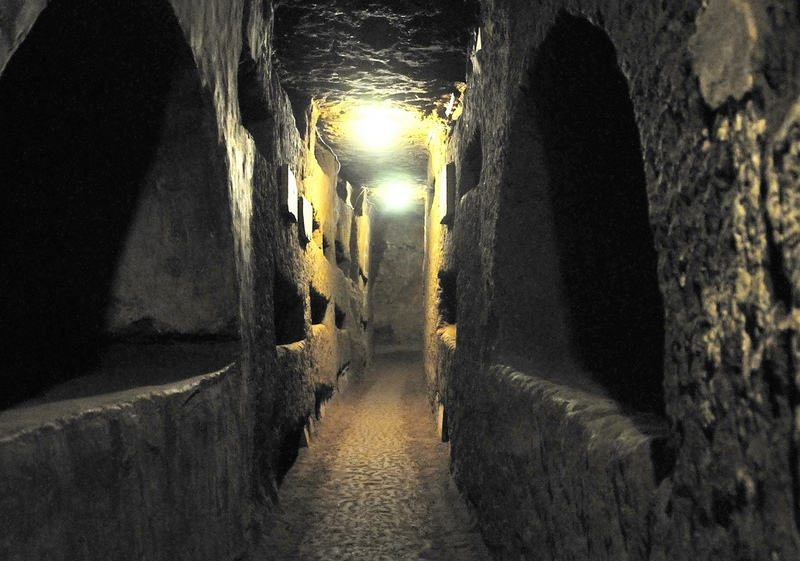
Passageways of the catacombs on the Old Appian Way
Catacombs of San Callisto
Situated on the Old Appian Way , the Catacombs of San Callisto span five levels and a total 20 kilometers in length. Named after the (soon-to-be pope) St. Callixtus, these are among the most significant Christian catacombs in Rome, and acted as the official cemetery of the Church of Rome in the 3rd century AD.
It is believed that roughly half a million Christians were buried in these catacombs, which were built in roughly 150 AD. Of these, there were some 16 pontiffs and 50 martyrs. Today, the Catacombs of San Callisto are open from Thursday to Tuesday between 9 am-12 am and 2 pm-5 pm.
→ Click to a look at our Private Catacombs and the Appian Way Tour !
Catacombs of San Sebastiano
If you are journeying Via Appia Antica, the Catacombs of San Sebastiano will show themselves as an easily accessible option, much like San Callisto. In fact, this hypogeum cemetery has always proved easy to access, resulting in a lack of respective preservation.
However, what is left of this smaller four-story catacomb is truly worth the visit. A restored crypt of St. Sebastian includes a table altar and a bust of the saint attributed to Bernini , as well as pagan mausoleums and Christian iconographies covering the walls of the catacomb.
More graffiti, reading ‘ domus Petri ’ also hints at the possibility that Peter the Apostle was buried within these walls, or more likely gives us the idea that this was of general consensus at the time.
The Catacombs of San Sebastiano are open to visitors from Monday to Saturday between 9 am-12 am and 2 pm-5 pm.
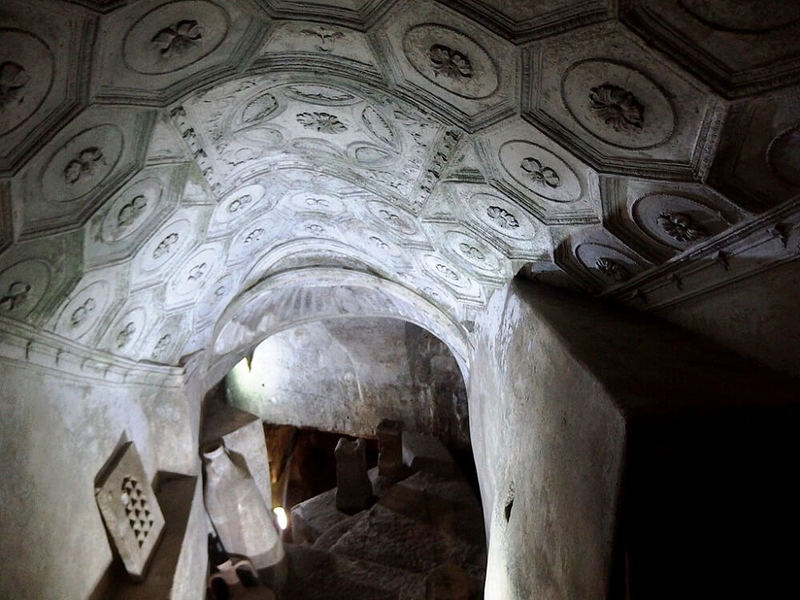
Pagan mausoleum in the Catacombs of San Sebastiano
Bone Church and the Capuchin Crypt
Whilst not technically one Rome’s catacombs, the Bone Church (also known as the Santa Maria della Concezione dei Cappuccini ) offers many visitors greater exposure to the buried themselves that they may feel the more well-trodden path of the catacombs in Rome can provide.
Passing through the church, which is still in operation, one will arrive at the Capuchin Crypt. Here, six rooms contain the skulls and bones of friars who died between 1528 and 1870 – clearly a more recent development than the catacombs of the Old Appian Way.
Taking an Underground Rome Tour with Walks Inside Rome, you can discover the stories behind these 3,700 Capuchin monks that decorated the crypts, and why they were decorated in this way over hundreds of years.
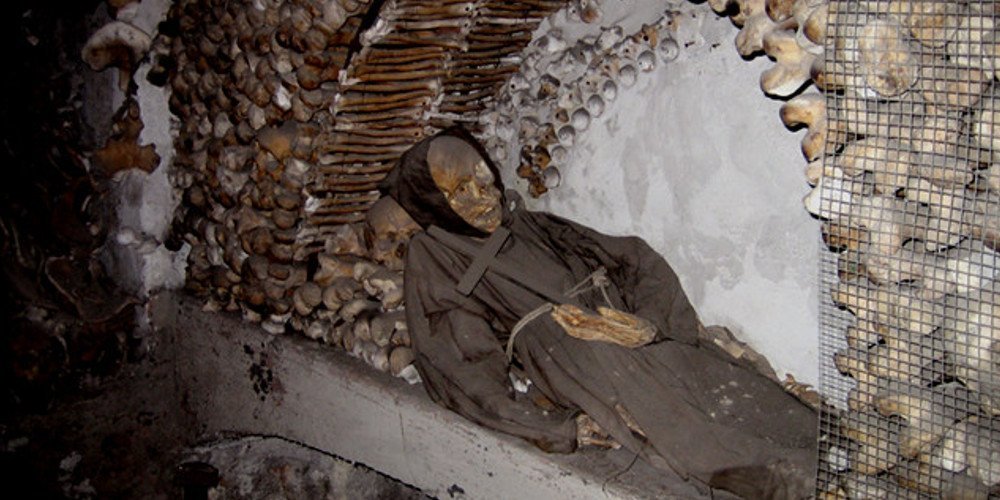
A Capuchin monk’s remains in the Bone Church
Catacombs of Domitilla
Also situated on Via Appia Antica, the Catacombs of Domitilla were discovered in 1593 by Bosio, the archaeologist who slightly lost his way upon discovery. A Christian cemetery, the passageways were mostly used throughout the fifth century AD, and host over 26,000 tombs.
These catacombs differ from their Old Appian Way counterparts in the fact that they still hold human remains. Moreover, the walls are covered in paintings depicting scenes of the mundane, such as bakers and grape vines, to biblical, pagan, and mythical images.
The Catacombs of Domitilla are open to visitors from Wednesday to Monday between 9 am-12 am and 2 pm -5 pm.
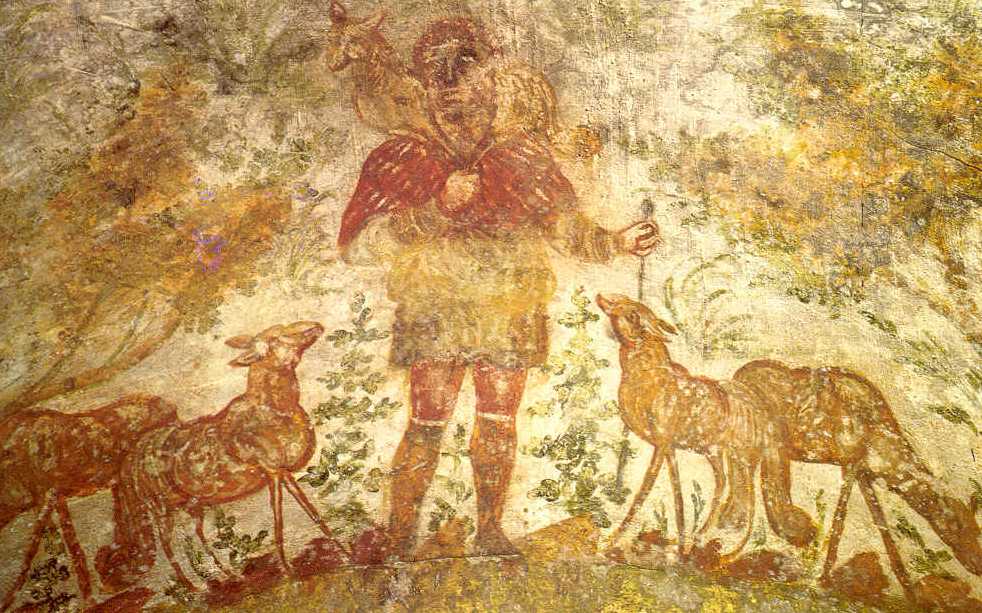
Good Shepherd painting in the Catacombs on Domitilla
The Jewish catacombs of Vigna Randanini
The necropolises that stretch from outside ancient Rome’s walls do not all belong to Christianity. Six Jewish catacombs have been unearthed from Rome’s underbelly, although only Vigna Randanini can be visited today.
With a Jewish Catacombs and Old Appian Way Tour , one can see the wider galleries and the ‘Kokhim’ graves with the wonderfully painted cubicula. Well-preserved, yet more intimate than others, the modest nature of these tombs can be attributed both to the poverty endured by the Jewish community of the time and the Jewish tendency to shun ostentatiousness.
Moreover, we can attribute the fact that the Jewish Romans created their own catacombs to their wish to avoid the Greek and Roman custom of cremation.
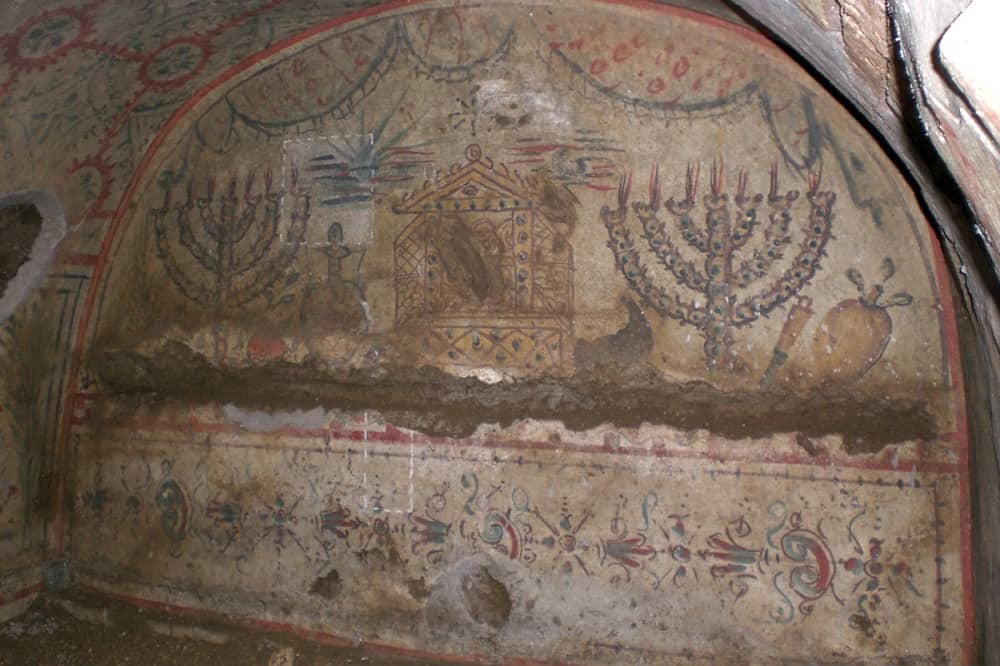
Wall paintings in the Jewish Catacombs
Visit the Catacombs with Walks Inside Rome
Walks Inside Rome has been guiding visitors through the city’s catacombs for over two decades, providing immersive, authentic, and educational experiences for those who wish to delve deep into underground Rome.
Our local, licensed guides who are experts in art, history, archaeology, and food endeavor to transform your catacombs tour into something unforgettable.
See our website, or contact us via email to see our entire catalog of catacombs tours and more. We can’t wait to hear from you so we can customize your catacombs in Rome experience and explore the Eternal City together!
Related Tours
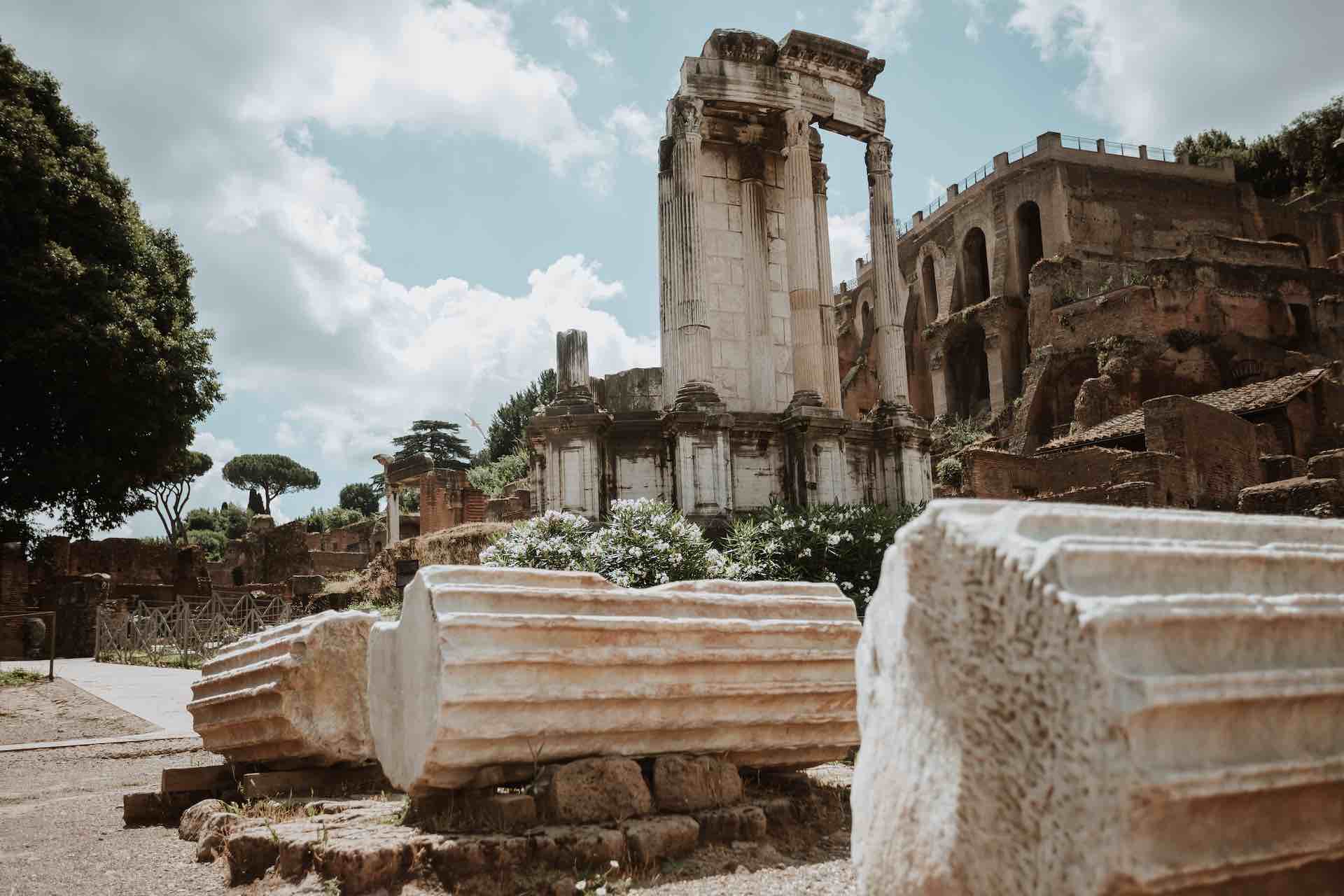
Ancient & Christian Rome Tour | Private
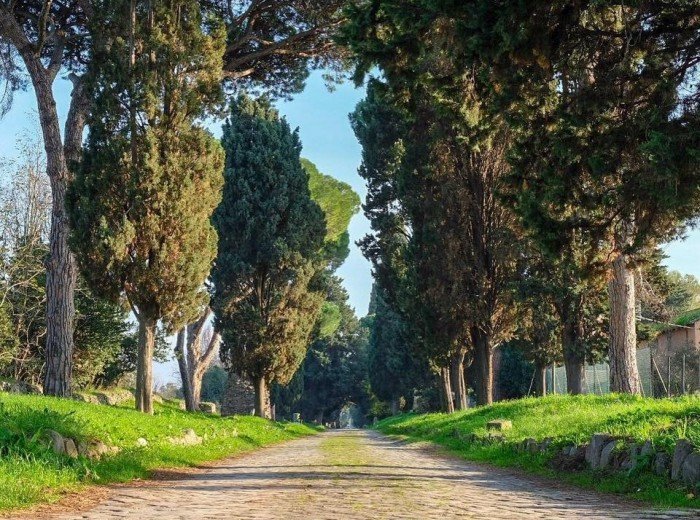
Catacombs & the Appian Way Tour | Private
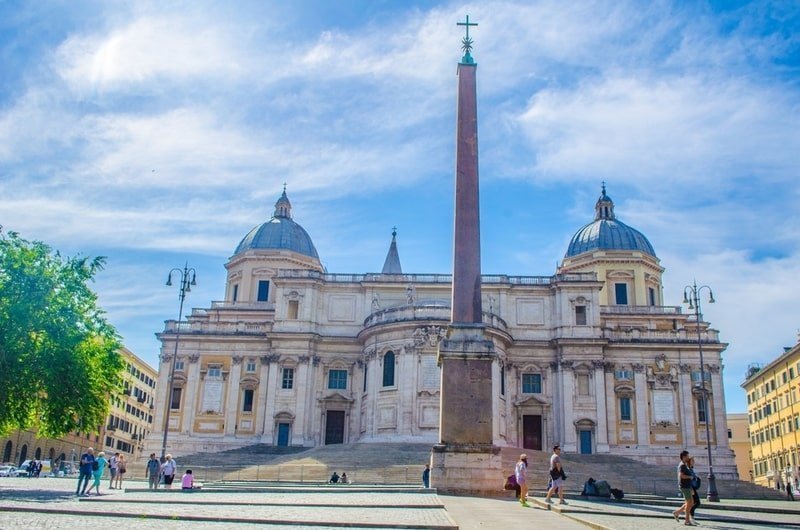
Christian Rome & Basilica Tour | Private
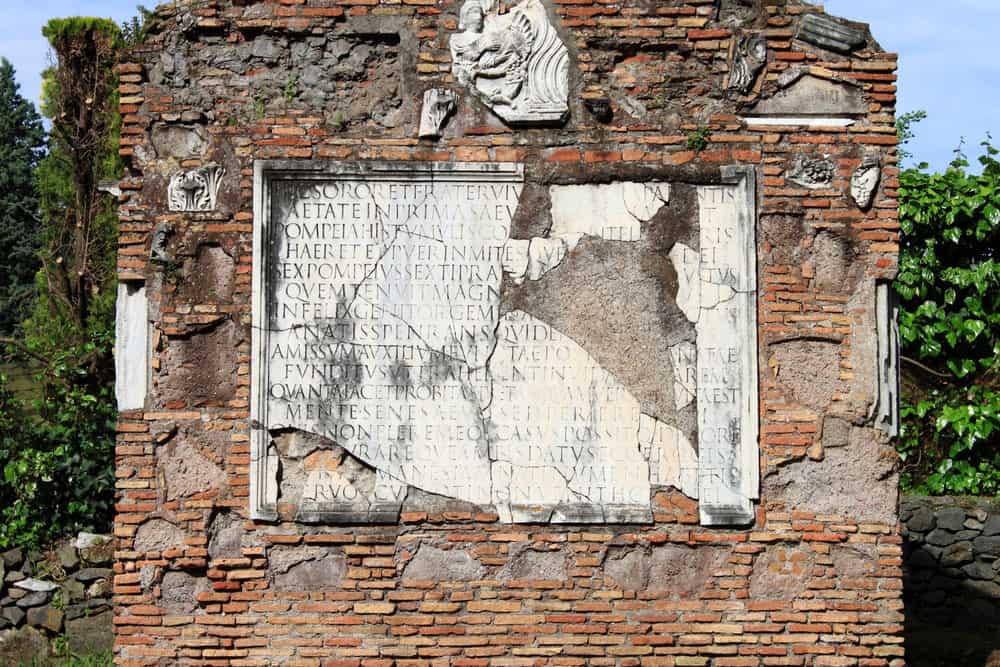
Jewish Catacombs and Old Appian Way | Private
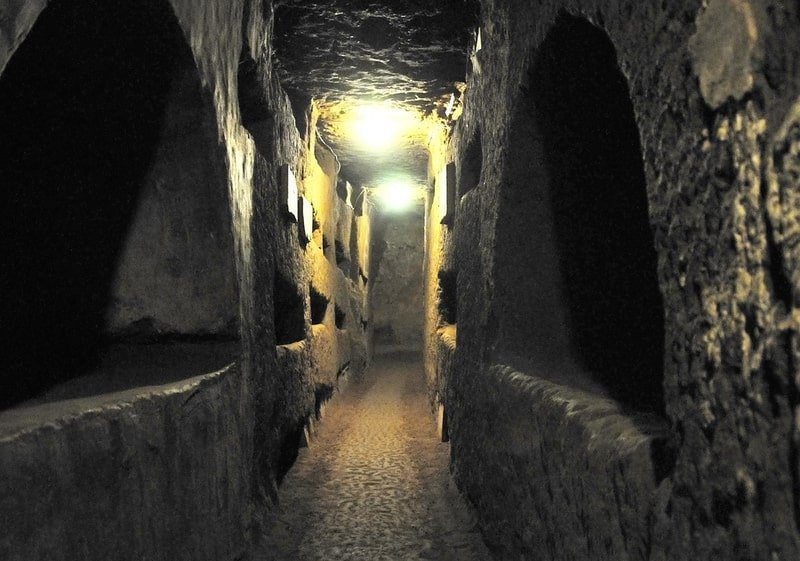
Underground Rome Tour | Private
- Rome Guided Tours
- Cooking Classes in Rome
- Rome for Kids Tours
- Rome Small Group Tours
- Walks Inside Rome
- +39066624626
- +393387791615
- Privacy Policy
- Cookie Policy
Forgot your password?
Lost your password? Please enter your email address. You will receive mail with link to set new password.
Back to login

11 BEST Catacombs of Rome Tours (selected by an Italian)
By: Author Stefania Guglielmi
Posted on Last updated: July 11, 2024
Categories Europe , Italy
Rome is one of the most important – and visited – cities in the world. Center of the Roman Empire and later capital of the Kingdom and Republic of Italy, Rome has an incredibly rich history . And it’s evident in pretty much every corner!
From the astounding Colosseum to the Forum and Palatine Hill, the ruins of its past keep the stories alive . And if you add mouthwatering cuisine and breathtaking architecture to the mix, you’ve got yourself an unparalleled city destination .
But did you know there’s more to Rome’s ancient settlements…and many of them are underground? Rome, in fact, hides a mysterious world beneath its streets: the catacombs .

These centuries-old tunnels are a time capsule dating back to the first five centuries AD. They are packed with art, relics, and mind-blowing constructions.
Home to enthralling tales as well as invaluable antiques, the catacombs are a lesser-known and highly recommended attraction. They’re a great addition to your 3-day itinerary in Rome !
While you could visit the catacombs on your own, most of them are on the outskirts of the city center, and require some transportation planning.
On top of that, exploring the sites as you learn about their meaning and history makes all the difference, so I highly recommend booking a tour .
In this article, I’ve rounded up the very best catacombs of Rome tours . This way, whichever option you decide to join, you know it will be good value. Check them out!
Why rely on my guide for Catacombs of Rome tours? As an Italian who’s devoted years to exploring and writing about Italy, I’ve curated this list with an eye for the exceptional.
My recommendations focus on tours that delve deep into the mysterious world beneath Rome. They offer both quality and captivating storytelling … So get ready for an incredible ride!
I generally use Viator and Get Your Guide to book tours around the world. I especially recommend them for their great cancellation policy. If your travel plans change, you can cancel most activities up to 24 hours in advance for a full refund.
Limited time? These are the ultimate tours :
OUR PICK: The BEST Catacombs of Rome Tour
Unearth the mysteries lurking beneath the city’s streets on this Rome: Crypts & Catacombs Underground Tour with Transfers . You’ll hop on an air-conditioned coach and breeze through the city to explore three of Rome’s most intriguing attractions.
Start by visiting the 2-millennia-old catacombs. This is where Christians would practice their faith safe from their persecutors. You’ll learn about the history and purpose of the passageways which were not only used for praying but also for burials.
Next up is the 4th-century Basilica di San Martino al Monte, filled with spectacular and ancient frescoes. Your last stop will be the spine-chilling Capuchin Crypt, an eerie series of chapels adorned with the bones of 4,000 Capuchin monks. The Capuchin Museum is also included!
This tour of catacombs in Rome allows you to skip the lines at the three attractions, and gain insights on each location from your guide.
Why this tour? It takes you to not one, but three different catacombs and underground chapels. You’ll delve into the history and significance of the crypts with an expert on the subject, and get to visit different versions of them. If you’re interested in this side of Rome, it’s the most comprehensive option.
Read what the reviews say :
“Our guide was fantastic very informative and helpful. the tour was fantastic!!!! 11/10 recommend for any and all that want to see and learn about Rome darkest secrets!!” Hunter – Read more reviews
This tour includes : Transfers, a guide, skip-the-line tickets for all attractions, and an audio guide to the Capuchin Crypt and Museum. ➥ BOOK IT HERE
Other Great Options To Consider
▶️ This Catacomb of St. Callixtus and Appian Way: Guided Tour takes you to the catacombs located beneath the city’s ancient aqueducts. Travel by bus to the site, and then trace the footsteps of the early Romans as you walk along the rustic Appian Way.
Then, travel back in time as you explore the Catacombs of St. Callixtus. They were carved in the first centuries AD and served as the final resting place for Christians.
Discover the burial niches, venture into the Crypt of the Popes, and admire the haunting beauty of sarcophagi. All the while your guide will be providing the stories that go with the sights.
This tour includes : Roundtrip transfers from a meeting point, entrance tickets, a guided tour of the catacombs, and headsets. ➥ BOOK IT HERE
▶️ Join this Small-Group Express Tour of Roman Catacombs with Transfer to unearth Rome’s enigma with a professional guide.
Hop on a comfortable minivan and head to Appian Way’s fabled Catacombe di Santa Domitilla. This series of subterranean burial chambers and tunnels is 16 meters underground!
Discover the four levels of the crypts, and trace the religious and mythological frescoes that retell the site’s history. Your guide will tell you about the local martyrs and the shift from Paganism to Christianity.
Then, pay a visit to the 4th-century Basilica of Nereus and Achilleus, also located below the ground.
This tour of Catacombs in Rome includes : Roundtrip transfers from a meeting point, a guide, entrance fees, and headsets. ➥ BOOK IT HERE
▶️ Check out this Catacombs and Hidden Underground Rome: Small Group Max 6 People . You’ll embark on an adventure to uncover the mysteries of subterranean Rome with a professional!
Visit the incredible old tunnels of Basilica di San Clemente, and follow a guide through the underground passageways. Listen to the stories about the Pagan rituals that took place there before being turned into Christian catacombs!
Marvel at the millennia-old paintings, and then head to the Catacombs of Santa Domitilla. It’s one of the most important ancient graveyards in Italy, where the early Christians were buried. The small-group tour is limited to six people, guaranteeing personalized attention.
This tour of the Catacombs in Rome includes : Transportation between the sites, a local guide, and entrance fees. ➥ BOOK IT HERE
Appian Way & Rome Catacombs Tour by E-Bike
The Rome E-Bike Tour: Appian Way, Catacombs & Roman Aqueducts is a fun-filled adventure. It combines a scenic e-bike ride along the beautiful Appian Way with a trip to the eerie underground.
Catch sight of the impressive Aurelian Walls and the grand Circus of Maxentius as you glide toward the tranquil countryside. Keep an eye out for the ancient aqueducts and the Thermal Baths of Caracalla you’ll pass by!
Then, leave your bikes behind to descend into the 2nd-century Catacombs of St. Callixtus. You’ll delve into the burial rituals that took place in that very spot from your very knowledgeable guide.
This tour includes : A Cannondale e-bike and helmet rental, a guide, catacombs visit, and water. ➥ BOOK IT HERE
Catacombs in Rome Tour by Golf Cart
Ditch the foot fatigue with this Rome: Catacombs and Appian Way Golf Cart Small-Group Tour , and cruise the city in style. Zoom past some iconic sights, including the Trajan’s Column, Circus Maximus, and the Colosseum on a very original tour of the city.
Then, head to the Appian Way, an ancient Roman road used for military purposes in the 4th century. There you’ll visit the intriguing catacombs located 16 meters below the ground, which brim with history, religion, and a tad of eeriness.
Geared with a set of headsets, you’ll hear your guide loud and clear as they cover everything about these mysterious burial sites.
This tour includes : A tour of Rome by golf cart, a guide, entrance to the catacombs, headsets, and water. ➥ BOOK IT HERE
After-Hours Tour of the Catacombs in Rome
This Rome: After-Hours Catacombs Tour with Bone Crypt Entry ensures an intimate and very special experience. You’ll get access to the ancient burial sites after all the tourists have gone home.
Start by exploring the Capuchin Crypt, better known as the Bone Chapel after the 4,000 remains of Capuchin Monks that decorate the chapels. Take advantage of the audio guide provided to learn about this location, and then follow your guide to the Roman Catacombs.
Descend into the ground for a tour of the catacombs, relishing the excitement of being the only group to walk the mysterious passageways. The best part? Your expert guide will tell you all about the birth of Christianity, and the role that these catacombs played in the religion!
This tour includes : Transportation, a guide, and entrance fees. ➥ BOOK IT HERE
A Private Tour of Rome Catacombs
Traveling with your gang? Book this Secrets Below Rome: Tour of Catacombs and Ancient Appian Way for your group of 7. You will descend into the ancient Catacombs of San Callisto or San Sebastiano to explore tombs and art.
Your driver will pick you up at your hotel, and tell you what to expect at the catacombs which you’ll explore on your own with the provided tickets.
You’ll then be taken to the Appian Way, the road used by the Romans to transport military supplies during the 4th century AD.
Learn about the sites from your driver, and take your time exploring them before returning to your accommodation in Rome.
This Rome Catacombs private tour includes : Private transportation, an English-speaking driver, and entrance tickets. ➥ BOOK IT HERE
Family-Friendly Tour to the Catacombs
Dive into a thrilling adventure at Rome’s Catacombs with this Catacombs for Kids – Private Family Tour .
You’ll visit the underground cemeteries with a friendly guide who’ll conduct a treasure hunt. The activity will keep you and your children super entertained and invested in the tour!
Solve riddles as you explore the Capuchin Crypt and the Catacombs of Santa Domitilla, and win prizes while learning about the catacombs’ history in a way that’s appropriate for children to hear.
This tour includes : A guide, entrance tickets, transfers between the sites, and a treasure hunt. ➥ BOOK IT HERE
Rome Catacombs Guided Tours with No Transfers
▶️ Uncover the hidden world below with a Rome: Catacombs of Priscilla Entry Ticket & Guided Tour . You’ll get to visit one of the many underground sites used by the early Christians for funerals and burials.
What makes the Catacombs of Priscilla stand out, however, is that it wasn’t originally used as a resting place but as an arenarium. It was then found by the Christians and incorporated into the complex structure of floors and niche tombs.
You’ll gain access to the site and explore it with a guide, learning about the history of Christianity in Rome. The process of shifting from Pagan rituals to Christian belief, and stories of local martyrs will also be shared!
This tour includes : A guided tour of the Catacombs of Priscilla with entrance tickets. ➥ BOOK IT HERE
▶️ Delve into the depths of history with this Rome: Catacombs of Domitilla Entry Ticket & Guided Tour . Descend 16 meters underground to explore the chillingly ancient burial chambers decorated with a blend of Pagan and Christian frescoes.
Accompanied by a guide, you’ll learn about the martyrs’ sacred resting grounds, and the importance of the catacombs for Roman Christianity in the first centuries AD.
As you navigate the maze of chambers, you’ll discover the site’s restoration processes and hear stories from almost 2,000 years old.
This tour includes : A tour guide, and entrance tickets to the catacombs. ➥ BOOK IT HERE
Stefania Guglielmi is the founder of Every Steph. Originally from Bologna, Italy, she's been traveling full-time since 2016 and has visited over 50 countries across 6 continents. She believes sustainable travel and luxury travel can go hand in hand and has been advocating for responsible tourism since 2014. Stefania's advice and travel experiences have been featured in important publications such as Business Insider, Refinery29, and Yahoo Money.
Sign me up for the monthly newsletter!

Rome’s Catacombs: Exploring The Darker Side of The Eternal City
Rome’s catacombs are among the city’s most curious sights – a reminder of the darker side of the Eternal City. Here’s what you need to know.
Rome is a city of many faces – one steeped in art, history, and culture. But what about the dark side of the eternal city?
Not to dig up the past (OK, that’s exactly what I’m doing) but let’s dive into the history of Rome’s catacombs – one of the darker sides of the city.
Rome sits atop a vast network of these burial tunnels and exploring them should be on your Rome itinerary – no matter how short it is.
So, here’s what to expect when you visit the catacombs of Rome.
What Are Catacombs and Why Does Rome Have So Many of Them?
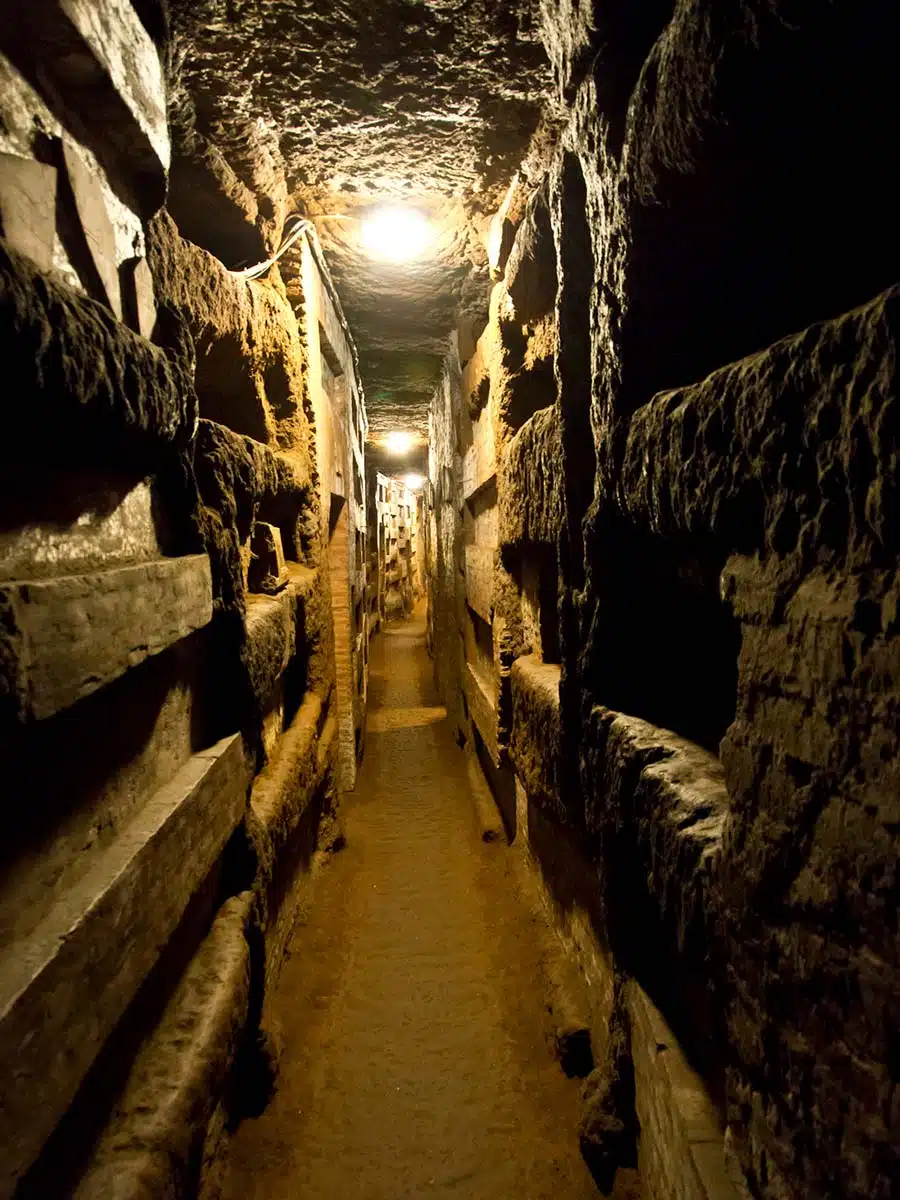
Why does Rome have so many catacombs? What are catacombs?
Okay, hold onto your explorer’s hats, folks. Class is in session.
What are Catacombs?
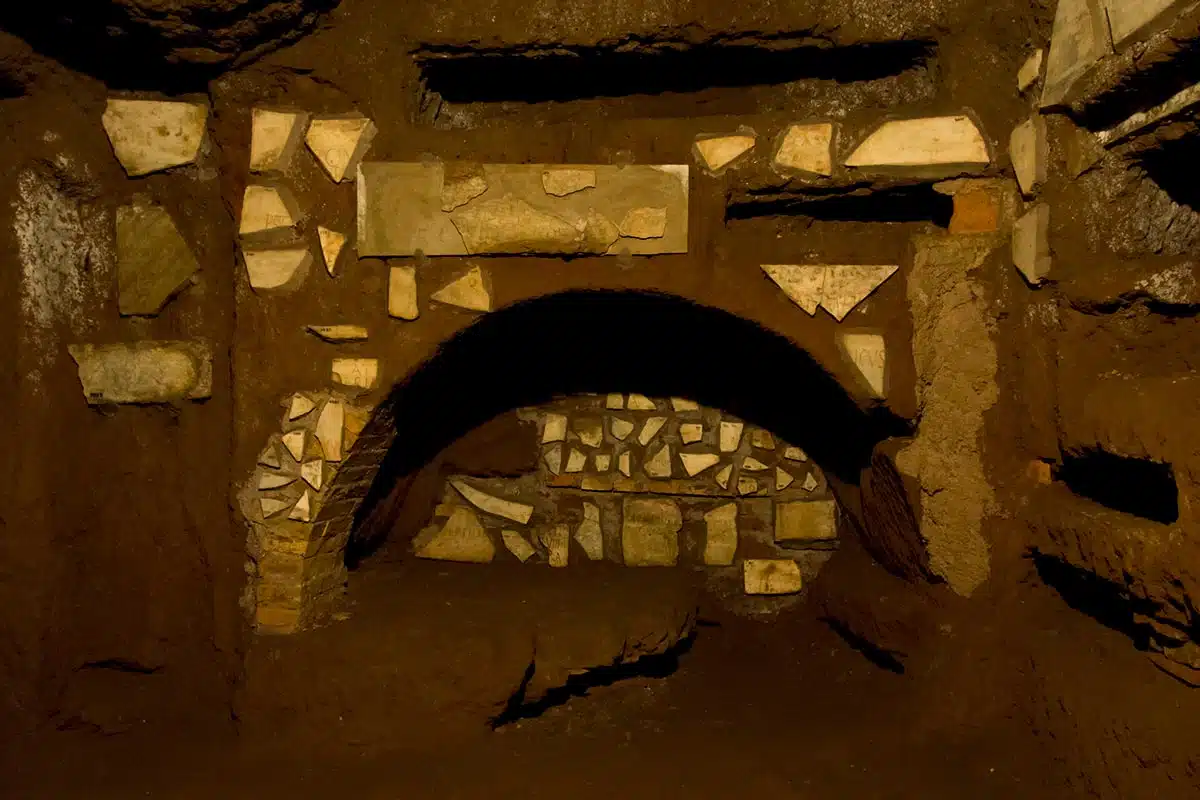
First up, what even is a catacomb? In short, a catacomb is a collection of underground passageways or tunnels. These intersect at points and often stretch for quite a few kilometres.
That doesn’t sound creepy at all, right? Well, here’s the catch. Catacombs are not just empty passageways. No, my intrepid adventurers, they usually come lined with thousands of human remains.
Yes, catacombs are burial tunnels. In fact, these labyrinths – which are as spooky as you’d expect them to be – served quite the purpose back in the day.
A Brief History of Rome’s Catacombs
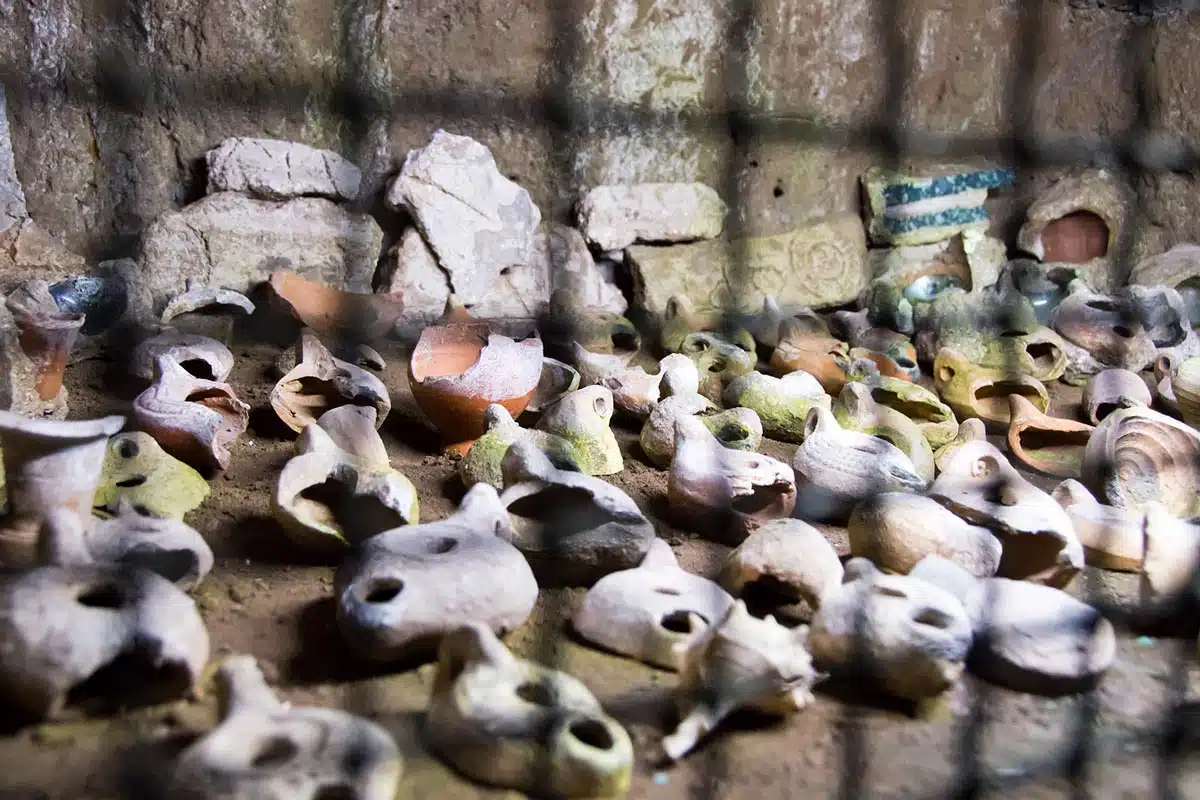
According to some archaeologists (it’s still a bit of a guesstimation), there are about 60 catacombs underneath Rome. You see, sometime between the first and second centuries, Roman law prohibited the burial of the deceased within the city.
The Jewish and Christian communities faced significant persecution in Rome – particularly between the 1st century AD and 4th century AD. Living in communities distinct from the mainstream pagan society, they also buried their dead separately too.
Initially, only Jewish citizens used the tunnels, and then about a century later, Christians followed suit.
The catacombs offered a safe place to bury their dead without fear of displaying religious symbols upon tombs. Thousands of people found their eternal resting place within these mazes.
Then in 313, the persecution of Christians stopped with the signing of the Edict of Milan . This edict allowed for the building of churches and the designation of burial land. But, the use of catacombs persisted until the 5th century.
The barbarian invasion of Italy in the 8th century resulted in heavy looting and desecration of the catacombs. Subsequently, the use of catacombs stopped and most left abandoned with important relics moved to churches inside the city.
Now that you know the ins and outs of Rome’s catacombs let’s dive into the best ones you can visit.
Catacombs in Rome You Should Visit
Catacombs of san callisto.
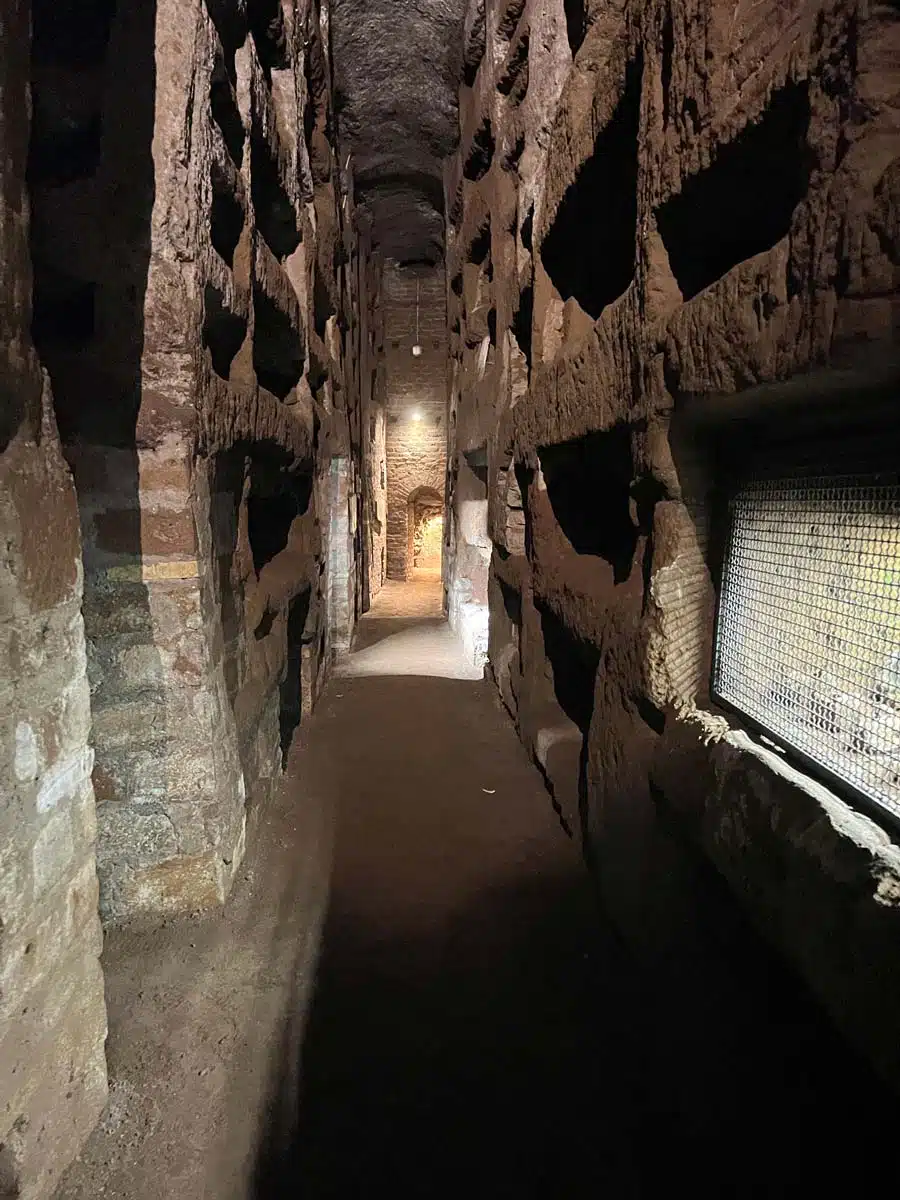
It would be quite a scandal if I started this list with anything but the catacombs of Saint Callisto, also known as Saint Callixtus. Why, you might be asking? Well, it’s considered the most impressive and beautiful (I use the term loosely) in Rome.
Considered the first catacombs used by Christians, they stretch for an astounding 20 kilometres. Within, you’ll find the burial sites of 16 Popes alongside many Christian martyrs.
Two famous sites in the catacombs include the ‘crypt of the Popes’, which houses the sanctified remains of five deceased pontiffs. The other is the crypt of Santa Cecilia.
Top Tip: Book this guid e d tour of the catacombs of St Callixtus, or this tour that includes the Appian Way.
Catacombs of Santa Priscilla
Originally called ‘Regina catacumbarum’, which translates to ‘the queen of catacombs’, this is where roughly 40 thousand burials took place. Amongst these, six Popes and hundreds of martyrs fill its niches.
Inside there are numerous important sites you can visit. The Cubicle of the Velata depicts redemption scenes from the Old Testament. The Greek Chapel showcases frescoes of “franctio panis”, or the sacrament of breaking bread. And what some deem the most ancient depiction of the Virgin Mary and the baby Jesus.
Explore the catacombs of Santa Priscilla, which are open from Tuesday to Sunday. You can choose to go between 9 am and 12 pm or 2 pm and 5 pm.
Catacombs of Domitilla
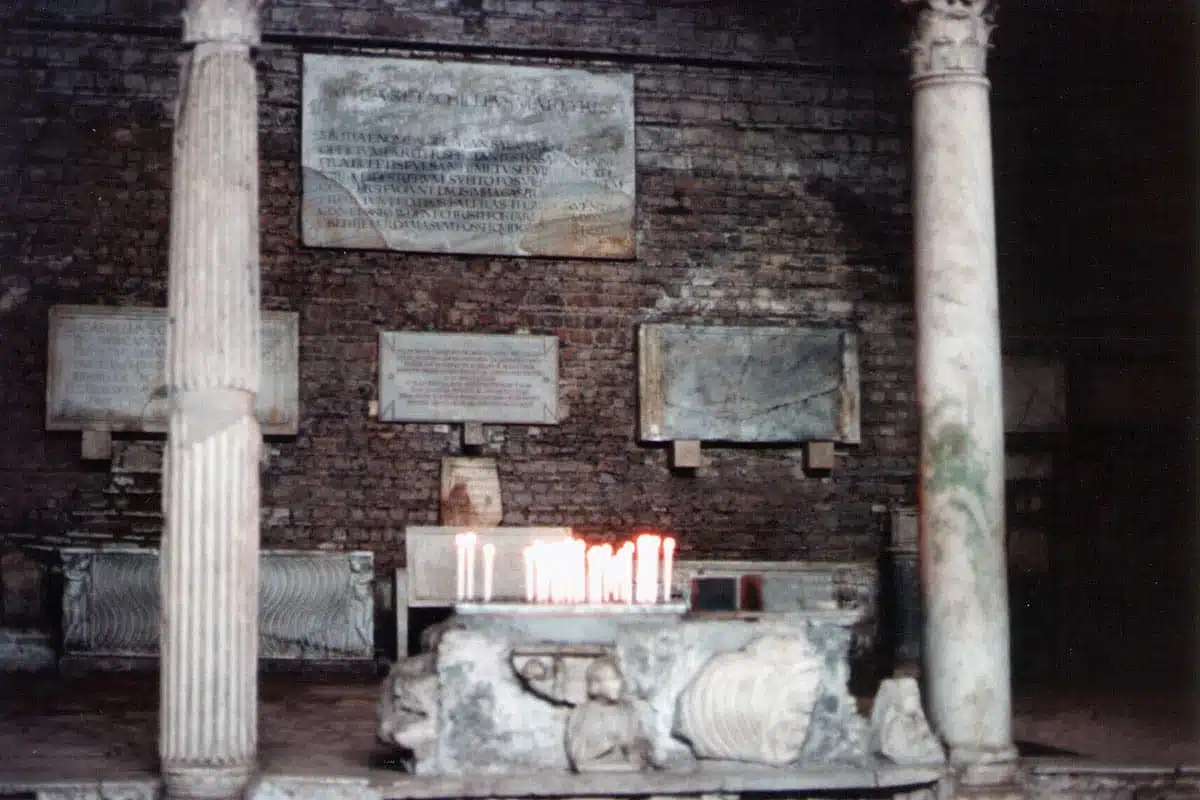
While many other Rome catacombs brim with the history of popes and martyrs, the catacombs of Domitilla tell a different story. Commissioned by the Domitilla family, they span nearly 15 kilometres.
These catacombs are the oldest of Rome’s underground burial tunnels, which is why they have seen significant restorations. Inside, the stunning frescoes offer depictions of Christ, while many others display more Christian art.
Fun fact time. Some of the niches carved into the passageways still contain bones. But, large parts of the catacombs are still closed to the public.
Top Tip: Book this small group Roman Catacombs tour to delve into the history of Domitilla.
Catacombs of Sant’ Agnese
Catacombs are fascinating, but they are also (unsurprisingly) sombre. The catacombs of Sant’ Agnese are exceptionally so. Agnes, a young girl of 12, died due to Christian persecution.
While these Roman catacombs do not contain much in the way of artistic frescoes or paintings, it is worth a visit. Inside the three-tier catacombs, you can see many epigraphical testimonies etched into its walls.
These tell tales of countless visitors to the tomb who came to view one of the first burial catacombs dedicated to a woman. The legend of Saint Agnese is why some call it one of the most famous catacombs in Rome.
Top Tip: You can only visit the catacombs of Sant’ Agnese by booking a guided tour through the official website. Visit their website to book your tickets.
Catacombs of Praetextatus
From an artistic perspective, the catacombs of Praetextatus are the most renowned tunnel network in Rome. It’s also one of the few in the city where depictions of not just Christian symbols mark the walls.
The interior features a few distinct areas as well. First is the Cubicle of Coronatio, which depicts the crowning of Jesus with thorns and the resurrection of Lazarus. Beyond that, it holds the sarcophagus of Emperor Balbino, as well as illustrations of the myth of Achilles.
Top Tip: Choose this guided half-day tour of the catacombs of Rome, which includes significant basilicas, to explore the eternal city’s underground.
Catacombs of San Sebastiano
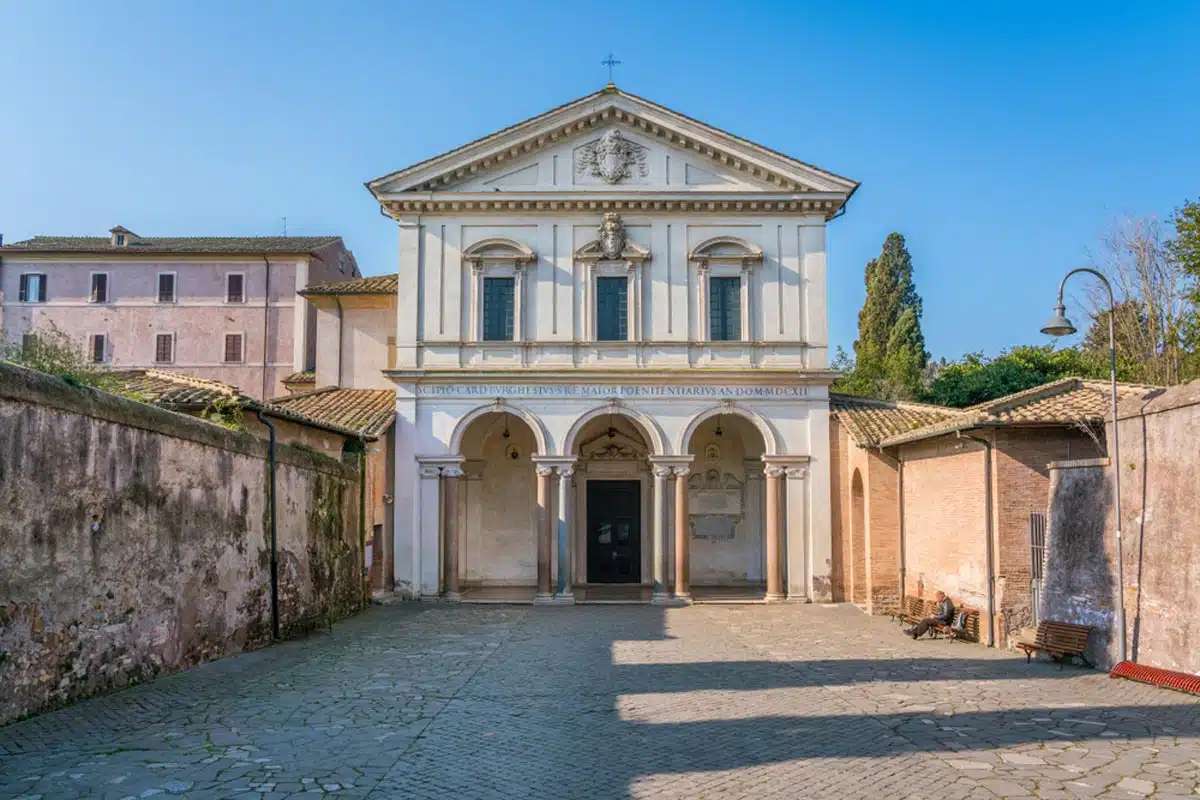
Dedicated to Saint Sebastian, these are the first burial tunnels called catacombs. Persecuted by the Roman Emperor Diocletian for converting thousands of soldiers to Christianity, his remains reside here.
Extending nearly 12 kilometres, you’ll see many distinct decorations distinguishing each corpse buried here. Inside sits the Baroque Basilica of Saint Sebastian, one of Rome’s seven holy pilgrimage sites.
The catacombs also contain a marble statue of St Sebastian and several sacred relics. These include the arrows that pierced his body and the column on which he died.
Top Tip: To view these burial tunnels, book this 3-hour guided tour of the best catacombs in Rome.
Practical Tips for Planning Your Visit to Rome’s Catacombs
Visiting the catacombs independently.
If you’re planning to visit any of the catacombs in Rome independently, there are a few things to remember. Most importantly, you can only enter them as part of a guided tour.
While there are numerous tour operators, each catacomb has its own tour system.
These tours led by monks or priests often involve a sermon. You must also dress appropriately, as the catacombs are holy sites.
Independently, you’ll also need to know each catacomb’s opening and closing times.
Visiting Rome’s Catacombs On a Tour
On the other hand, adding a tour, or tours of Rome catacombs through a tour operator, is a more encompassing experience. These often include more than one catacomb and other areas of interest.
Hosted tours also are led by well-trained guides whose knowledge enhances your overall tour quality. These are, however, often more costly but worth it if pressed for time.
Book Your Catacombs Tour Now
Catacombs in Rome: Map
Now You’ve Explored the Roman Catacombs – Read These
- Unmissable Things to do in Rome
- 3 Day Rome Itinerary
- The Best Places to Stay in Rome
- Cool Day Trips from Rome
- Rome in a Day
- The Rome Rooftop Bars with the Best View
Love This? Save and Share on Pinterest
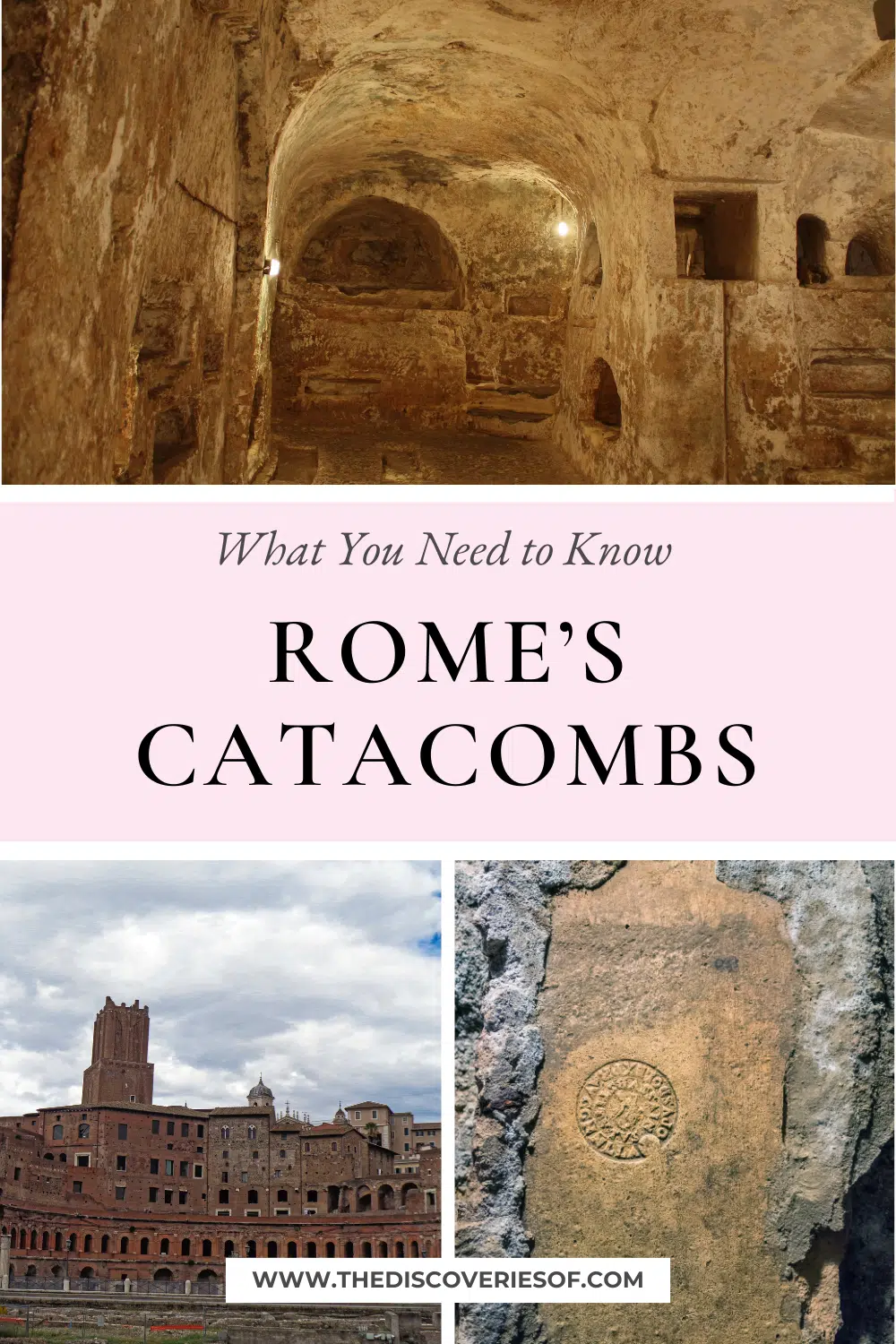
I’m Julianna Barnaby - a professional travel writer and geek extraordinaire. I started The Discoveries Of to help you to discover the best of new destinations from around the world.
Discovering new places is a thrill - whether it’s close to home, a new country or continent, I write to help you explore more and explore differently.
Related Posts
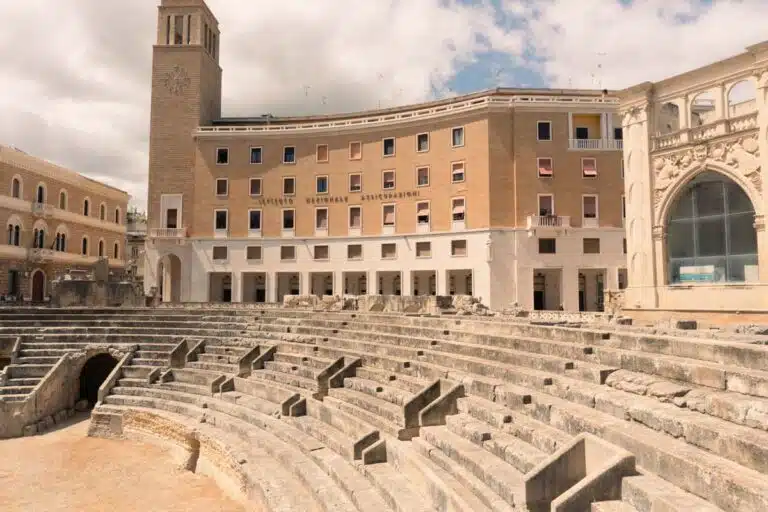
Lecce, Puglia Travel Guide: Discover Italy’s Baroque Gem of the South
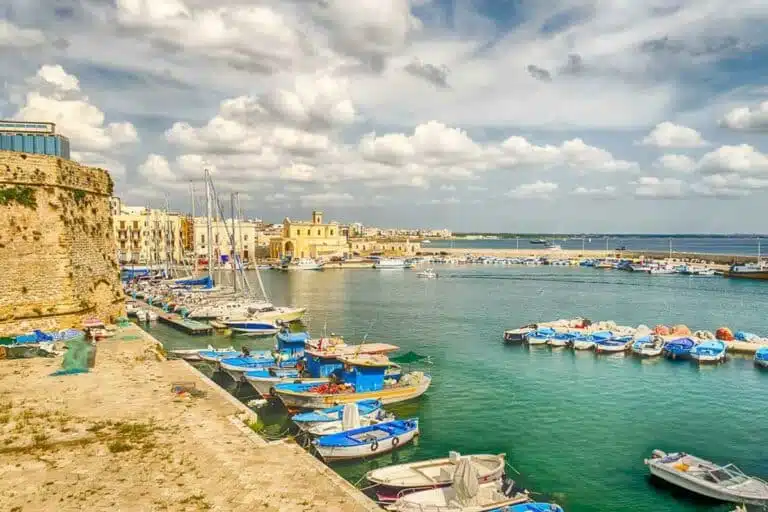
6 Epic Italy Road Trip Ideas for the Ultimate Italian Adventure
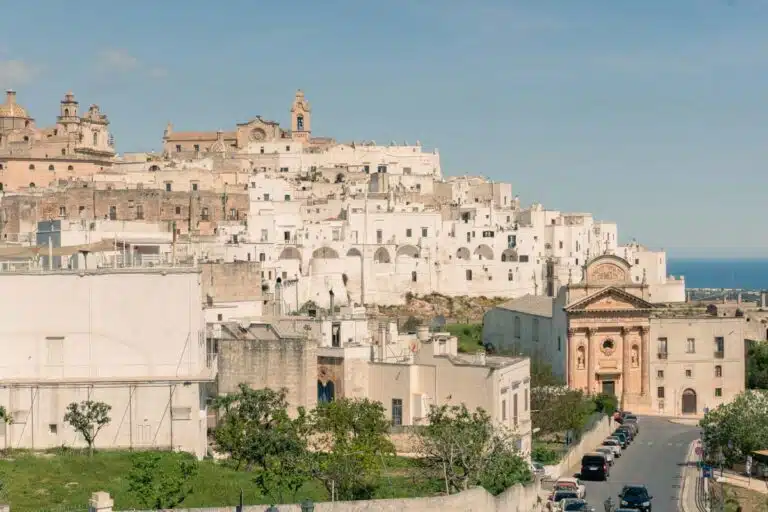
Ostuni, Puglia Travel Guide: Discover Italy’s White City
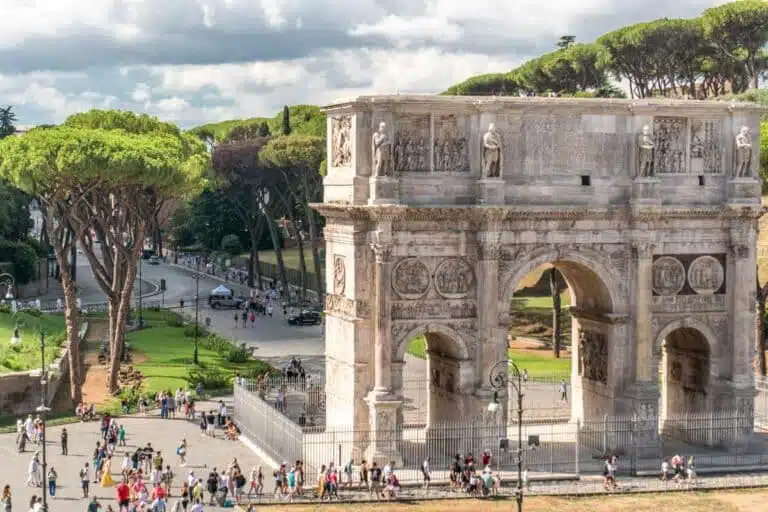
Where to Stay in Rome: The Best Areas + Hotels for Your Trip

Follow me on Instagram for travel inspiration, tips, and guides.

The Catacombs of Rome
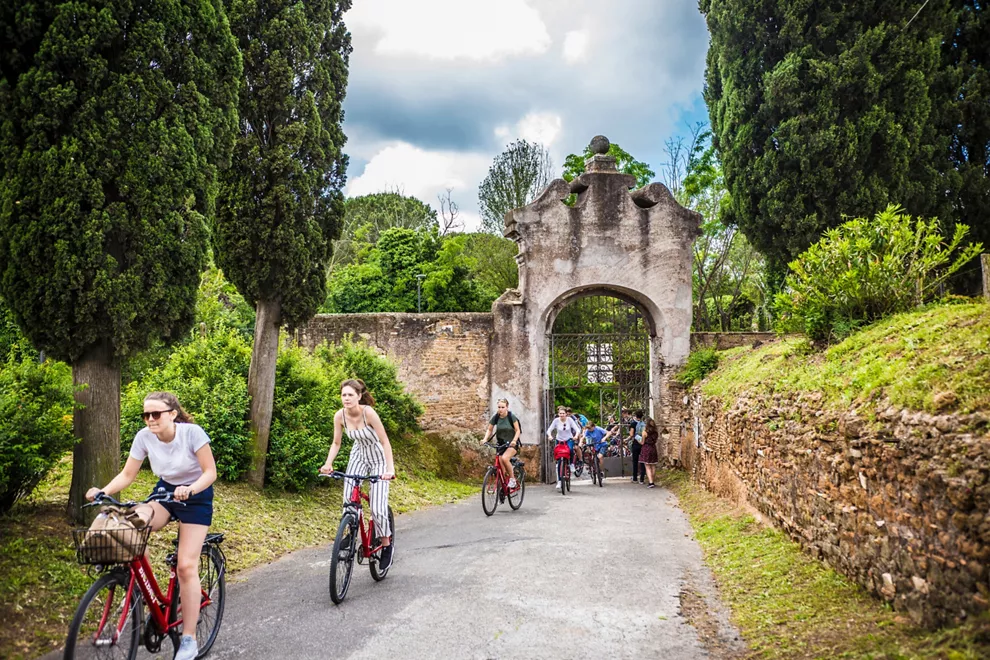
Visiting the catacombs means undertaking a journey through subterranean Rome, where one can discover the gallery of tunnels in which first the pagans, then Christians buried their dead. Fascinating places that narrate ancient Roman customs and traditions, more than 60 catacombs and thousands of tombs exist in and around Rome. Additionally, there were six Jewish catacombs – four of which have disappeared, while the other two remain closed. The Roman catacombs were constructed along the ancient Roman roads (viae consulares) – Via Appia, Ostiense, Labicana, Tiburtina, and Nomentana. Only five catacombs are open to the public today: San Callisto , San Sebastiano and Santa Domitilla in the Appia Antica zone, and Priscilla and S.Agnese in the area of Nomentano-Salario.
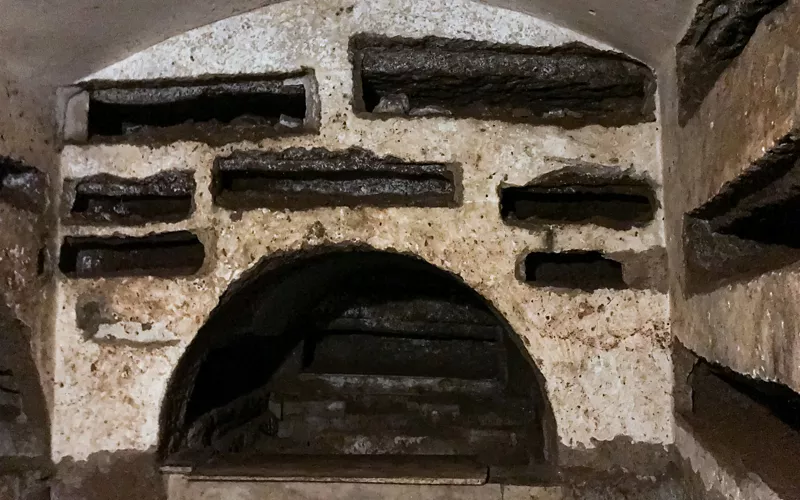
Roman law prohibited burying of the dead inside the old city walls, for sanitary reasons. The ancient Roman ways were lined with elaborate gravesites of society patricians they were often cremated and their ashes were preserved in urns. The first Christians, rather, maintaining that they should be ready for the Resurrection, were not cremated but buried in the underground caves, dug in tufo or lava stone. Once their bodies were wrapped in two layers of cloth soaked with lye (to stave off risk of contamination), they were then deposited in niches inside the cave walls.
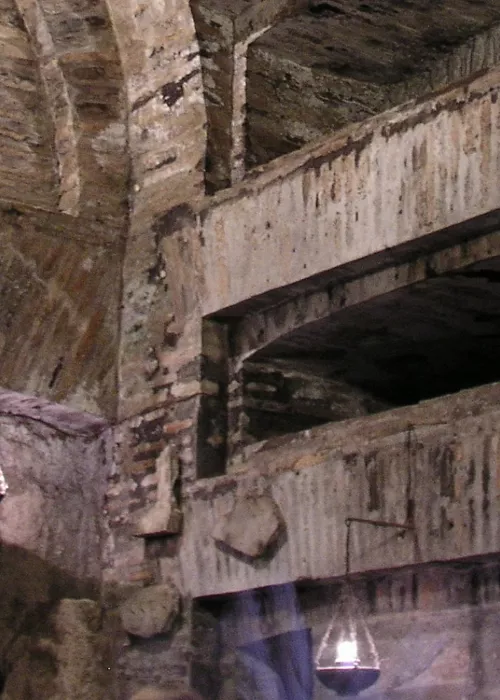
Catacombs of St. Callixtus
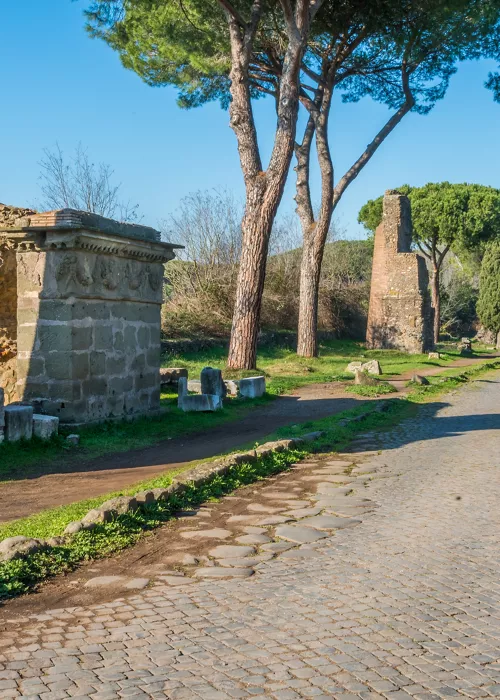
Via Appia Antica
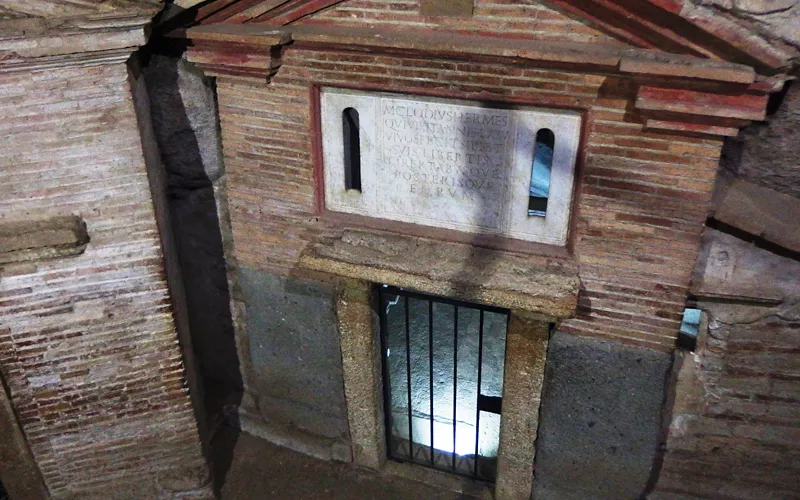
Scholarly opinion varies in regards to the catacombs. While some hold that the first Christians used the catacombs as places of refuge from persecution, others believe that they were meeting-points for honoring the deceased – particularly martyrs and Popes – usually with a banquet or feast. Today the tutelage of the Christian catacombs is entrusted to the Pontificia Commissione di Archeologia Sacra (The Pontifical Commission for Sacred Archaeology), which manages excavations and restorations.
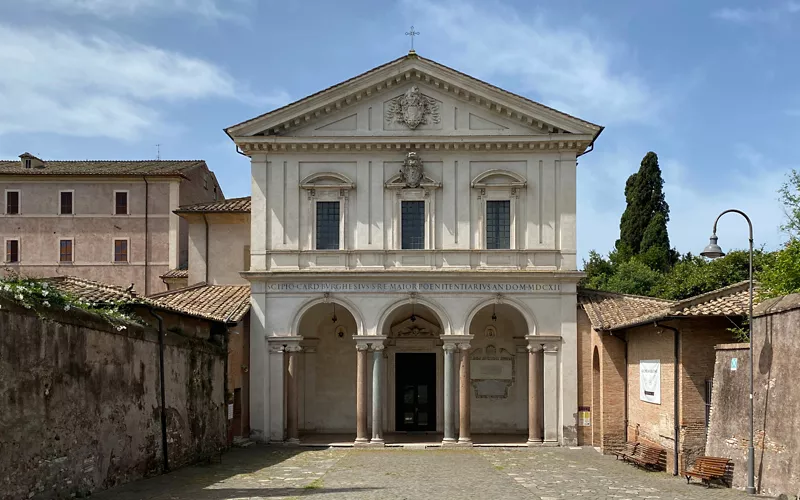
The word “catacomb” is by now used to define just about any underground necropolis . However, the ancient term was “ coemeterium ” deriving from the Greek for "dormitorium," which emphasized the fact that Christians viewed burial as a passing moment before the Resurrection. Moreover, according to some scholars, the term catacomb can be extended to all the Christian cemeteries, yet in antiquity it actually defined the S. Sebastiano complex on the Via Appia. It was also the reference for the stone quarries surrounding the S. Sebastiano catacomb.
Related articles
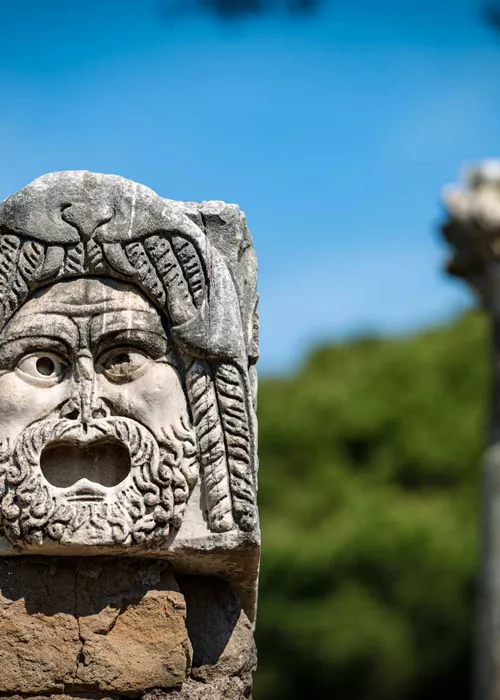
Seven sites of art, history and culture just one hour from Rome
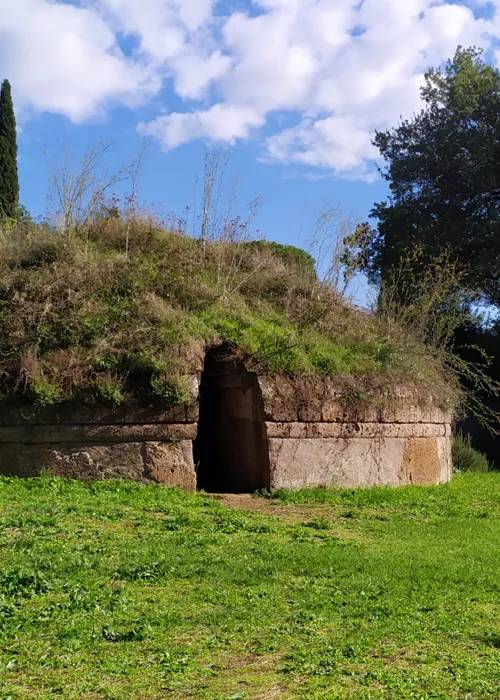
The Necropolises of Tarquinia and Cerveteri

The historical centre of Rome with all its beauty.
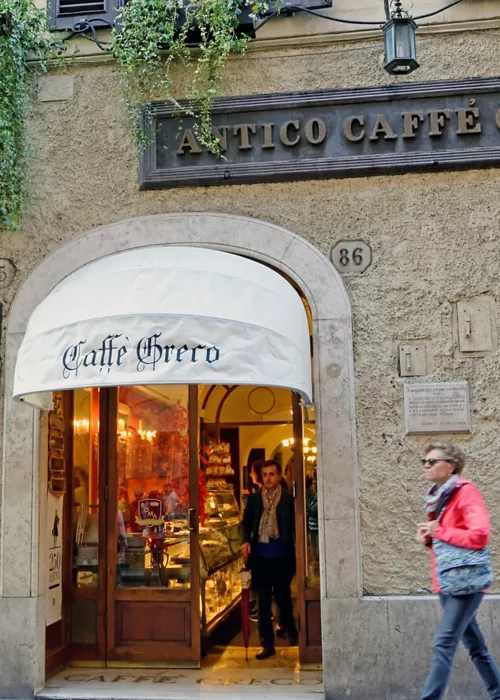
Rome's Historic Cafes
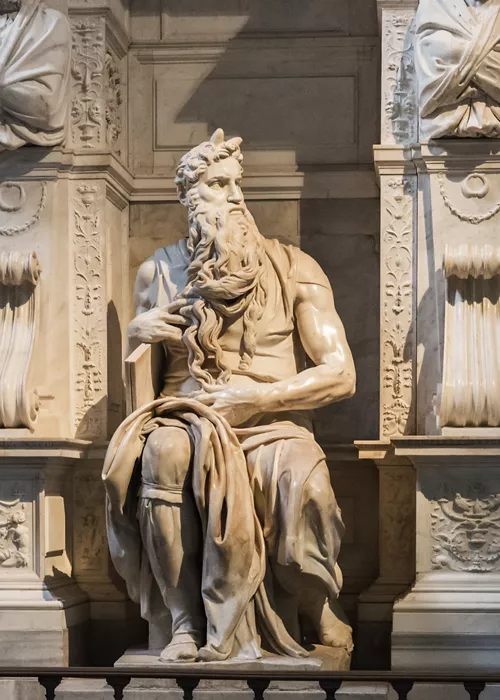
Michelangelo's Moses at San Pietro in Vincoli
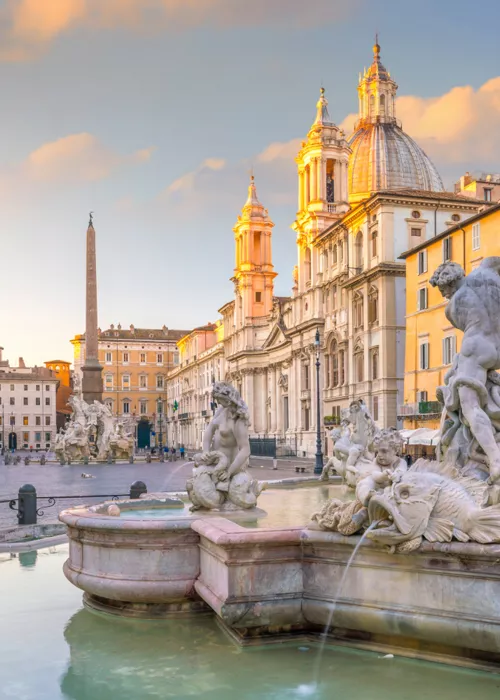
5 unusual things to see in Rome, sacred and profane
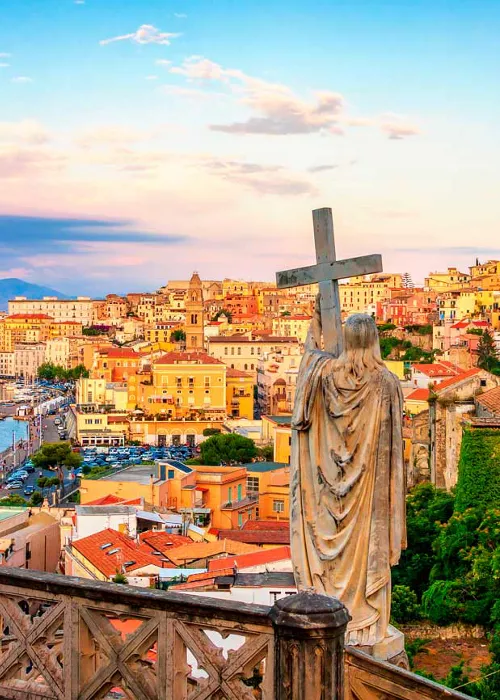
Trips into the countryside starting from Rome

The Vatican Museums and the Sistine Chapel, wonders second to none in the world
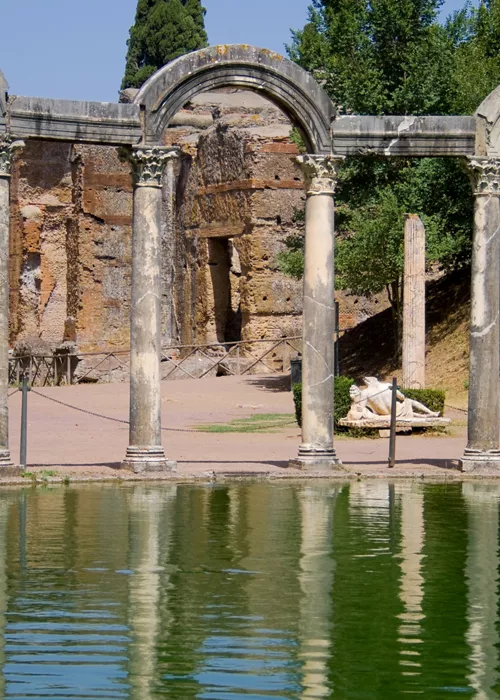
Villa Adriana in Tivoli: an imperial Roman marvel
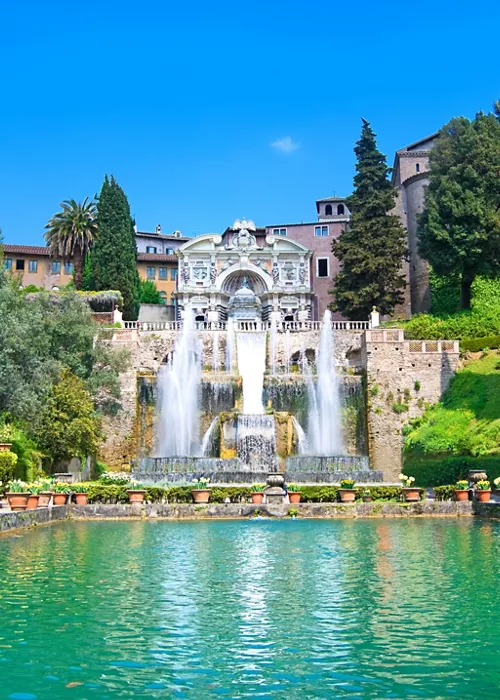
Villa d'Este: a triumph of the Renaissance
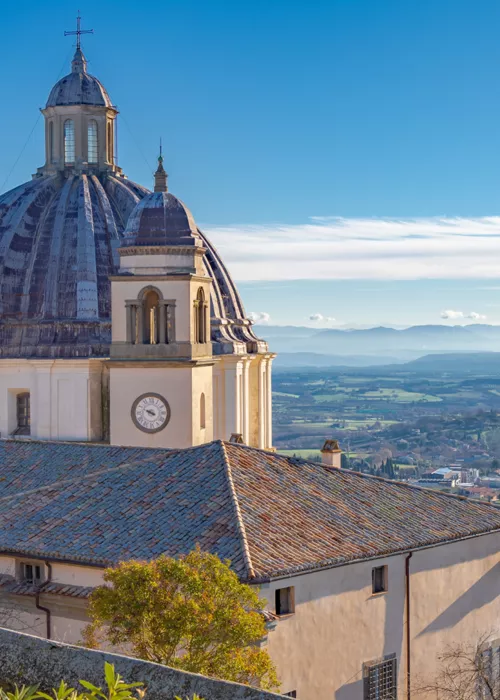
The Via Francigena Lazio, more than just Rome

A tour at Rocca di Papa, a small town where over the centuries various legends have arisen
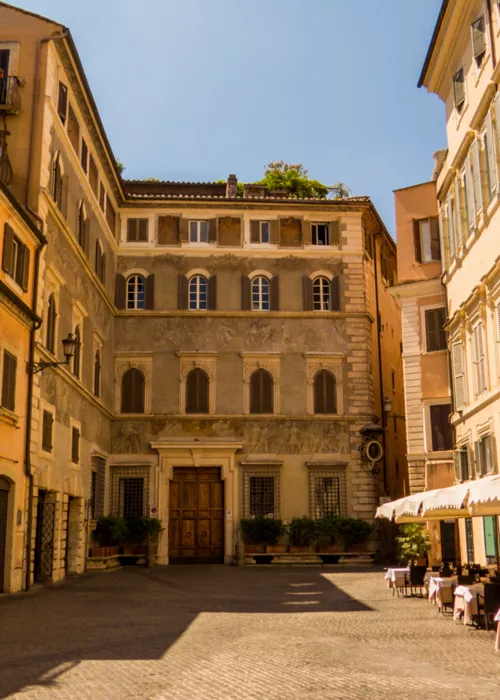
The 'great beauty' of Palazzo Sacchetti, in the heart of Rome, set of the Oscar-winning film by Paolo Sorrentino
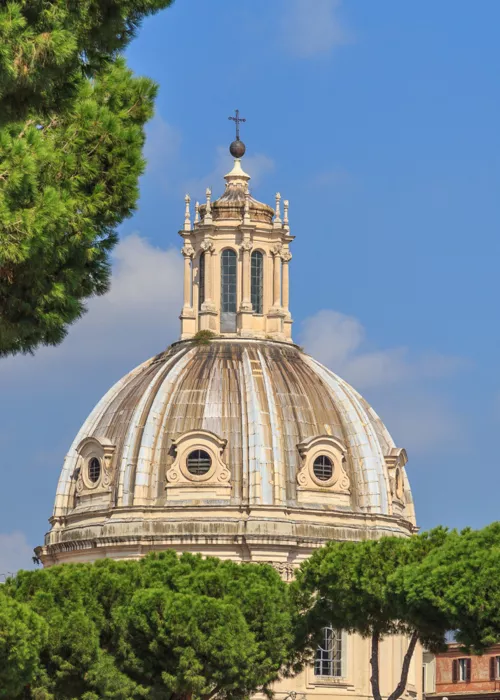
Rome is the perfect destination for sustainable tourism
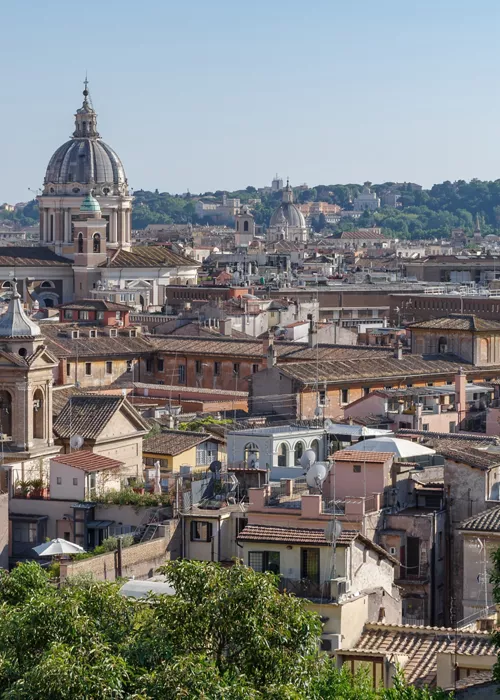
Exclusive aperitifs in Rome's most evocative locations
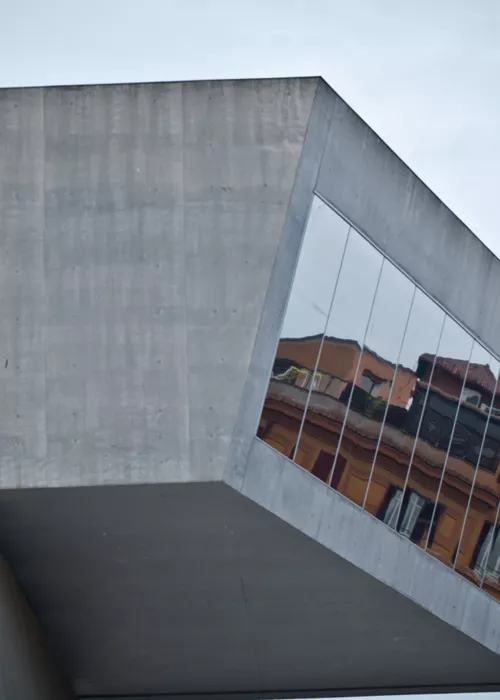
The MAXXI Museum in Rome
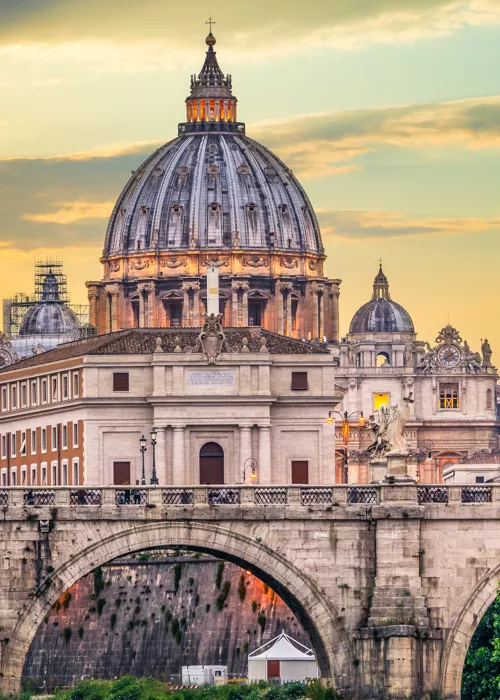
2 days in Rome: the itinerary

Romics 2024

The opening of the Holy Door of St. Peter's and the beginning of the 2025 Jubilee

Jubilee of Artists

Romaeuropa Festival

Jubilee of the Armed Forces

Opening of the Holy Door of Saint Mary Major

The Jubilee of the World of Communications

Continue living like an Italian
Subscribe to the Newsletter so as not to miss places, events and experiences for experiencing the best side of Italy: the authentic one.
Keep up to date
Would you like to learn about the most authentic experiences to be had in Italy, stay up to date on the most interesting events, discover our special offers and receive lots of insider hints and tips?
Save your favorite places
Create an account or log in to save your wishlist
Do you already have an account? Sign in
- In the Press
- Work with us
- Rome & Vatican Rome Vatican Colosseum Rome Food
- Italy Florence & Tuscany Venice & Northern Italy Pompeii & Herculaneum Amalfi Coast & Capri Naples & Southern Italy
The Best Catacombs in Rome You Need to Visit
Fri 12 Jan 2024
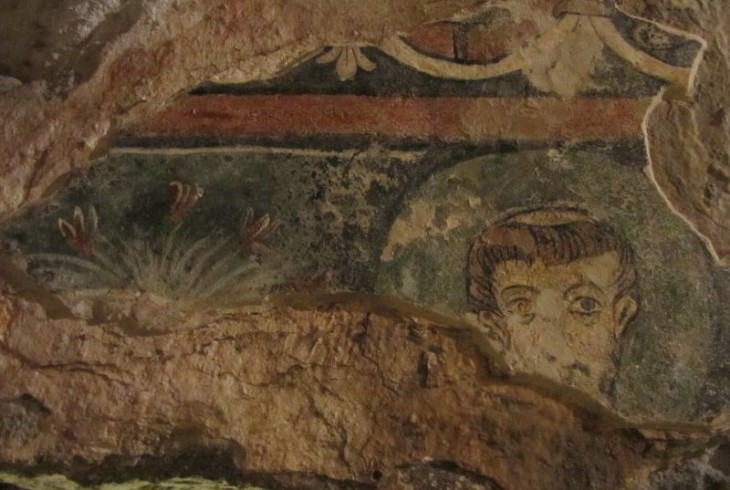
Rome, it is often said, is like some great archaeological lasagne. As if the stunning monuments that grace the streets of the Eternal City weren't reason enough to make Rome one of the world's most fascinating places, what you can see at first glance in Rome barely scratches the surface of the city's riches. Thanks to its continuous habitation over thousands of years, an array of extraordinary historical sites lie concealed beneath the street level of the modern city, vast underground worlds hiding in plain sight just awaiting discovery by the intrepid traveller. And of all the subterranean sites in Rome, the catacombs are arguably the most fascinating .
In these passages and caves carved deep into the Roman bedrock beyond the ancient city walls, the city's early Christian community came to bury their dead in the hope that they would remain undisturbed by those hostile to the new religion. But although these places are conditioned by death, we must remember that death was not the end for these early believers.
To understand these silent memorials in all their complexity, we must understand that they are as much celebrations of a glorious birth rather than commemorations of a sad death. In the shapes and forms of the wonderfully simple wall-paintings, carvings and inscriptions that survive in these tunnels, we can gain a unique insight into the world of early Christianity, and the distant thoughts and philosophies that animated these spaces millennia ago.
To celebrate the launch of our new Secrets Beneath Rome: Capuchin Crypt and Catacombs Tour, this week on our blog we are profiling the most important catacombs that you can visit in Rome!

1. Catacombs of Domitilla
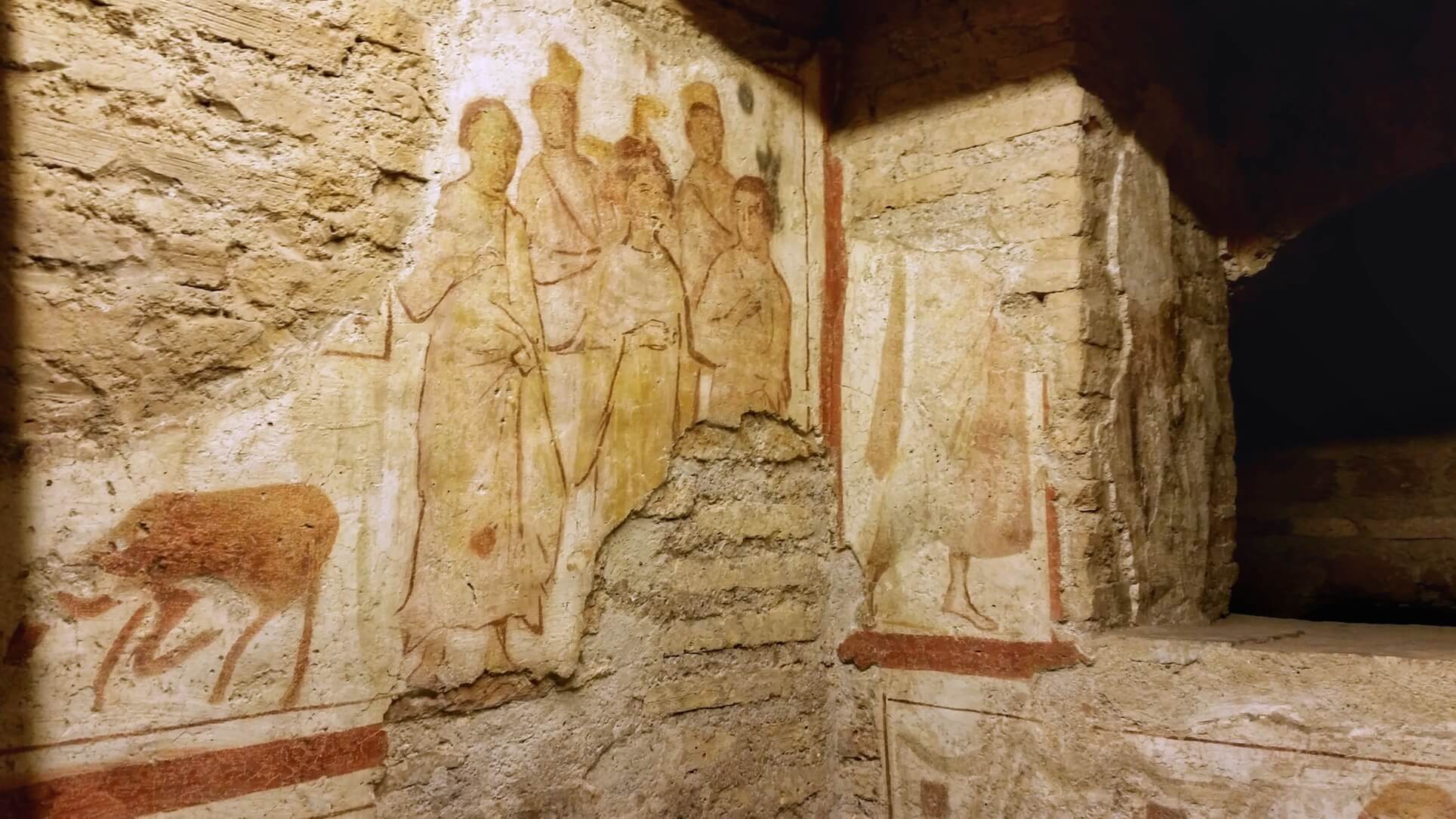
The remarkably well-preserved Catacombs of Domitilla , located along the ancient Via Ardeatina, form one of the largest subterranean burial complexes in Rome. Dating back to the 2nd century, when the aristocratic Christian convert Flavia Domitilla donated land to the nascent church, the catacombs contain a vast network of galleries and tombs linked by labyrinthine tunnels carved out of the soft tufa rock characteristic of the Roman countryside.
The passages are lined floor to ceiling with narrow niches called niches which house the remains of countless early Christians. Small rooms, or cubicles , open out from the maze to reveal the final remaining places of families rich enough to enjoy the peace of private sepulchres. Strange symbols are engraved into their tombs – fish and anchors, secret signs that demonstrated the presence of Jesus Christ, messiah and savior of the Christian faith.
Wall paintings provide a window into the burial practices and beliefs of early Christians: allegorical images of plants and animals including phoenixes - symbolic of the resurrection - appear alongside depictions of important religious figures such as the twelve apostles, and one particularly fascinating portrait of a man identified as Diogenes, who appears with a pickaxe and shovel: it was his task to dig out the catacombs for the secure burial of his fellow Christians.
This extraordinary hidden world lay undiscovered for many centuries until it was unearthed in the late 1500s by Antonio Bosio, a man known as the 'Columbus of the Catacombs' for his intrepid adventuring spirit. He got lost for three days down here in search of the lost origins of Christianity, and it's easy to see why even today, even with the aid of electric light illuminating the spooky way down towards the center of the earth.
Catacombs of Domitilla, Via delle Sette Chiese, 282. Opening Hours: from 9.00 to 12.00 and from 14.00 to 17.00. Closed on Tuesdays. Tickets €8, €5 reductions.
2. Catacombs of San Sebastiano
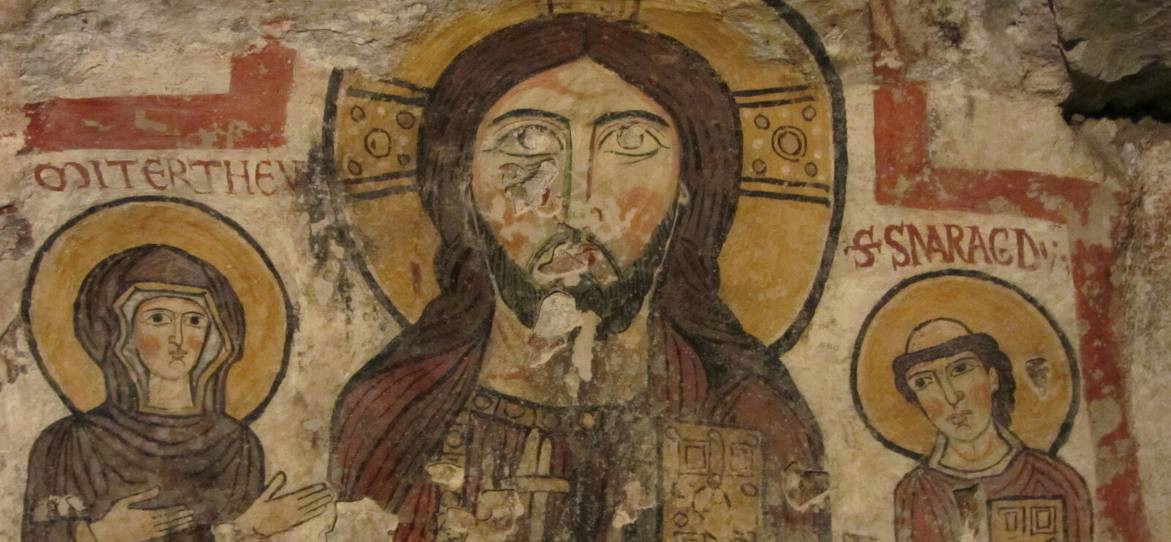
Historically the most easily accessible of the Roman catacombs, the small burial complex of San Sebastiano never slipped from the historical record as did the other entries on our list. Consequently, whilst perhaps being the most famous of the Roman catacombs, it has also suffered the depredations of grave robbers and material stripping more than its neighbours. Nonetheless, it still stands as a fascinating testament to the world of early-Christian Rome.
Believed to house the final remaining place of the highly revered 3rd-century martyr Saint Sebastian, moved here by the pious matron Lucina after he appeared to her in a dream, the catacombs are located beneath the church of San Sebastiano Fuori le Mura near the beginning of the Appian Way.
Originally a mine for pozzolana stone in antiquity, the site was adapted for pagan - and eventually Christian - burial from the 3rd century onwards.. Numerous graffiti referring to the apostles Peter and Paul attest to the site's sacred significance for early Christians, and it has been theorized that the relics of the saints were briefly transferred here to a marble aedicule for safe-keeping in the 3rd century.
The so-called Cubicle of Jonah houses incredible early-Christian frescoes depicting the life of the prophet, while the Crypt of Saint Sebastian features a beautiful marble statue of the saint designed by Baroque master Gianlorenzo Bernini and sculpted by Antonio Giorgetti.
Catacombs of San Sebastiano, Via Appia Antica, 136. Opening Hours: from 9.00 to 12.00 and from 14.30 to 17.00. Tickets €8, €5 reductions.
3. Catacombs of Priscilla
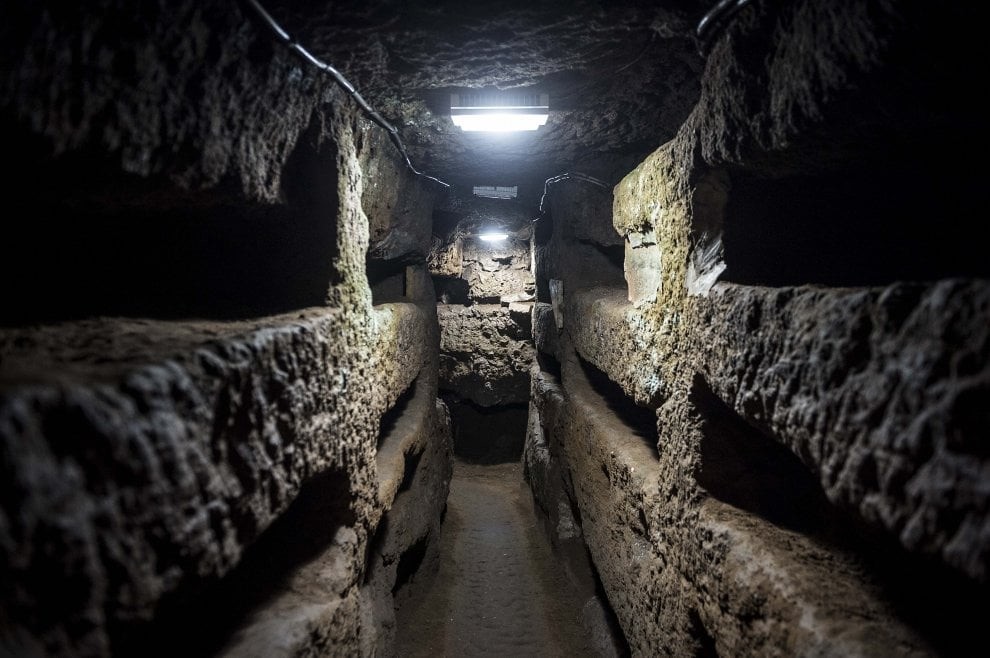
Often referred to as the "Queen of the Catacombs," thanks to the variety and extent of the early-Christian remains housed there, the Catacombs of Priscilla conserve over 40,000 bodies extending over 13 kilometers of tunnels excavated from the soft tufa rock beneath what is now the Roman park of Villa Ada.
Located along the ancient consular road Via Salaria, the complex occupies a particularly privileged place in Christian hagiography as a result of the numerous popes and saints interred here during the time of the Emperor Diocletian's persecution of the new faith: Popes Marcellinus, Marcellus and Sylvester were buried here alongside notable saints including Felix, Philip, Praxedes and Pudenziana.
When the complex was rediscovered at the height of the Counter-Reformation in the 16th century, it caused a sensation. The cardinal and historian Cesare Baronio described how 'all of Rome was filled with wonder' at the find, 'for it had no idea that in its neighborhood there was a hidden city, filled with tombs of the days of the persecutions of the Christians. '
Exceptionally high-quality paintings, including the oldest known depiction of the Virgin Mary and the infant Christ as well as a beautifully enigmatic fresco of a veiled woman dressed in liturgical vestments, make the catacomb an incredibly important site for art historians. The catacombs also feature a vast network of burial niches, adorned with frescoes depicting biblical scenes and symbols of Christian faith.
Counters and marble seating provide evidence that early Christians staged ritual banquets in honor of the dead down here, a fascinating memorial practice that is alluded to in a particularly fine depiction of a Eucharistic meal of bread and fish.
Catacombs of Priscilla, Via Salaria, 430. Opening Hours: from 9.00 to 12.00 and from 14.00 to 17.00. Closed Mondays and the month of August. Tickets €8, €5 reductions.
4. Catacombs of San Callisto
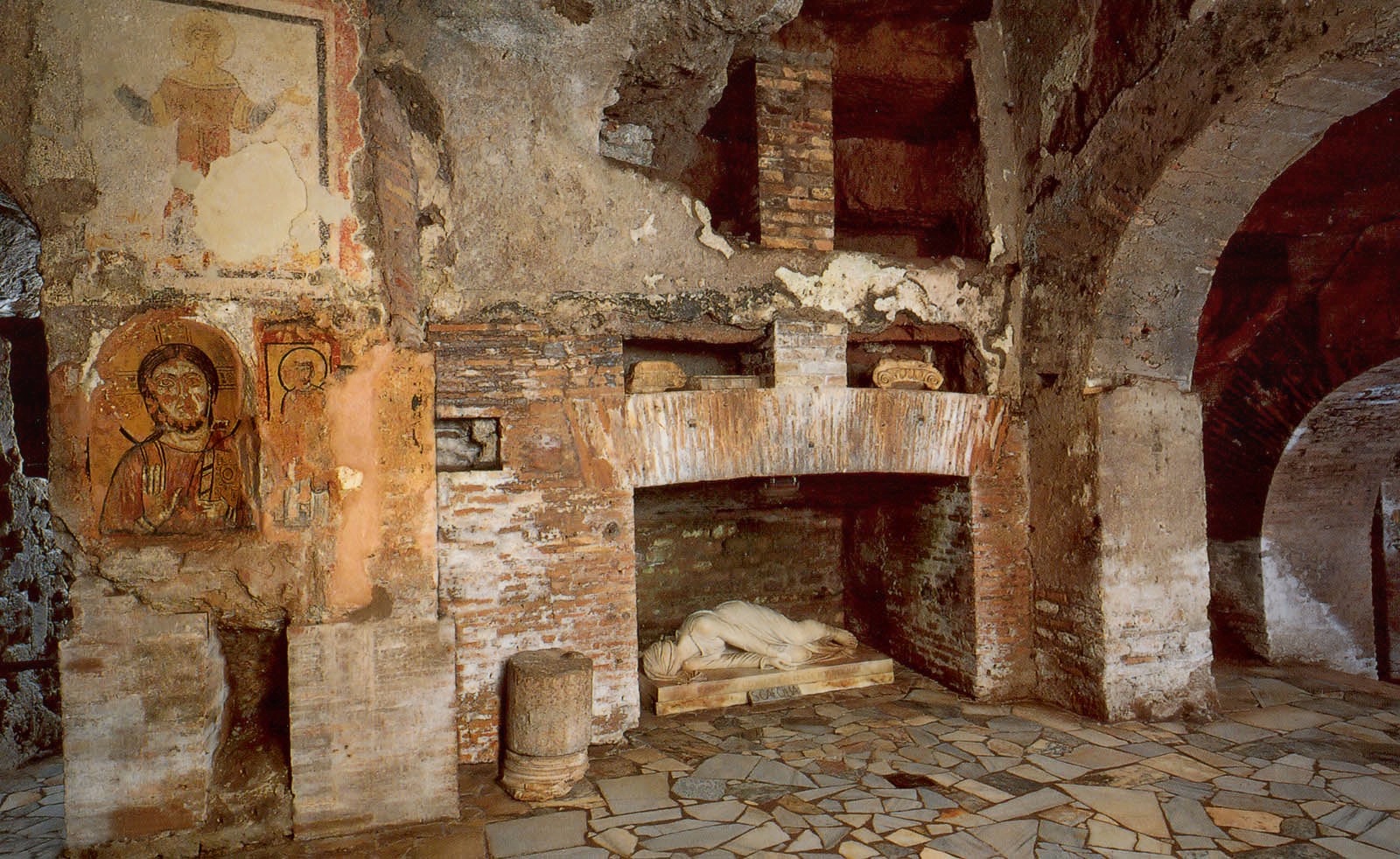
The Catacomb of San Callisto is the oldest and best preserved of the cemetery complexes on the Appian Way. Dating back to the 2nd century AD, the catacombs served as the final resting place for numerous prominent early Christians, and its tunnels and galleries extend over 20 kilometers and multiple levels. Notable features include the Crypt of the Popes, a gallery that was described by its 19th-century rediscover GB de Rossi as a “Little Vatican” thanks to the presence of the mortal remains of no fewer than 9 early pontiffs and 8 bishops.
But perhaps the most famous early Christian laid to rest in the catacomb is the locally revered Saint Cecilia, the patron saint of music who was martyred for her faith in the 3rd century. Her body di lei was moved to the church in Trastevere that bears her name di lei in the year 821, although the original marble sarcophagus in which she was interred is still visible in the atmospheric Crypt of Saint Cecilia.
A copy of the magnificent statue of the saint that graces the high altar of Santa Cecilia in Trastevere has also been placed here, adding to the evocative atmosphere. Well-preserved frescoes depicting the sacraments of Communion and Baptism, meanwhile, are preserved on the walls of the so-called "Cubicoli dei Sacramenti," offering a vivid insight into the lives and customs of the early Christian community in Rome.
Via Appia Antica, 110. Opening Hours: from 9.00 to 12.00 and from 14.00 to 17.00. Closed Wednesdays and the month of February. Tickets €8, €5 reductions.
5. Catacombs of Saint Agnes

According to Christian hagiography, the unfortunate Saint Agnes was little more than a girl when she was brutally executed for refusing to renounce her faith in the 3rd century, and her cult quickly became one of the most popular in all of Rome. A shrine sprang up at her reputed burial place in a small Christian cemetery dug into the side of a hill along the Via Nomentana. When Constantine converted to Christianity and promoted the development of Christian architecture a century later, he commissioned a basilica on the site.
The church was rebuilt in the 7th century and features a stunning apse mosaic featuring the young saint. Descend beneath the church to explore the small catacomb: although there aren't wall paintings comparable to the other sites on our list down here, numerous inscriptions and funerary paraphernalia make the catacombs well worth a visit.
Via Nomentana, 349. Opening Hours: from 9.00 to 12.00 and from 16.00 to 18.00. Closed Sunday mornings and the month of November. Tickets €8, €5 reductions.

We hope you enjoyed our guide to the catacombs in Rome! To visit the catacombs in the company of an expert archaeologist guide alongside other fascinating subterranean sites in the Eternal City, be sure to join our award-winning Secrets Beneath Rome: Capuchin Crypt and Catacombs Tour!
Post Categories
Suggested Tours
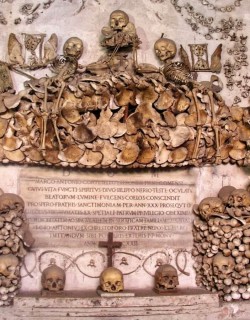
Secrets Beneath Rome: Capuchin Crypt and Catacombs Tour

Domus Aurea Tour (Nero’s Golden House)
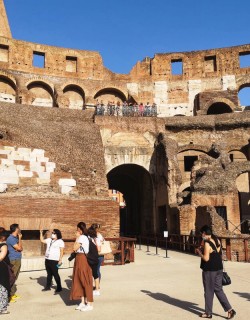
Colosseum with Gladiator Arena Floor, Forum and Palatine Hill Semi-Private Tour

Rome at Twilight Among the Piazzas and Fountains: Evening Semi-Private Walking Tour
Subscribe to our newsletter and receive 5% off your first booking!
You'll also receive fascinating travel tips and insights from our expert team
Subscribe to our free newsletter
Thank you for subscribing!
You should shortly receive a confirmation message with your discount code. If you do not receive this within 5 minutes, please email [email protected].

Catacombs of Rome: how to visit and where to find them

The Catacombs have always been a very fascinating topic, especially in Rome, where we count more than 60 catacombs!
Let’s learn what the catacombs are, which are the best catacombs to visit in Rome and how to visit them. We also offer a semi-private guided tour including one of these catacombs and the Appian way, which you can find here .
What are the Catacombs of Rome?
The name Catacombs comes from the ancient Latin ad catacumbas , which literally means “in the hollow”.
The first catacomb to be called like that was the Catacomb of San Sebastiano . Before becoming a cemetery, there was a quarry of pozzolana ash, which created a sort of cave, a hollow.
Later on the Romans (pagans) built some sanctuaries (still incredibly preserved and visible today!) in the hollow. Successively it became a Christian cemetery.
Since then, every underground cemetery was referred to as “catacomb”.
Which are the best Catacombs to visit in Rome?
With over 60 catacombs in Rome, choosing where to go can be challenging. All the catacombs are located outside of the ancient Roman city walls (the Aurelian walls).
This means you won’t find catacombs in the very city center today, but you’ll have to move in less central areas of the city.
These are the best catacombs of Rome that we suggest visiting. (Please note we’ll be adding more catacombs on this list over time!)
We take you to some of these catacombs during our Oldest Catacombs in the World and Appian Way tour. Click here to learn more!
Catacombs of San Sebastiano

The Catacombs of San Sebastiano are the first catacombs of Rome . This is where the word “catacomb” originated from, and then used to refer to all the underground cemeteries.
The Catacomb of San Sebastiano are located on the Appian Way , in the east suburb of Rome. It features 12 kilometers (7.5 miles) of galleries and more than 100000 burials .
Many tombs of Saints were here, for example San Sebastian. Later on the Popes decided to move the relics of the saints inside their respective churches, to preserve them from the tomb raiders, which in the past have been stealing the grave goods and jewels from the catacombs.
Above the Catacombs of San Sebastiano a basilica church was built, which is also referred to as: in memoria apostolorum . This name comes from the fact that in the 3rd century the relics of St Peter and St Paul were temporarily transferred here to protect them from the persecutions. Now St Paul is buried in the church of St Paul outside the Walls. While St Peter is buried in St Peter’s basilica.
To visit the Catacombs of San Sebastiano you need to buy a ticket directly at the venue or online. The visit to the Catacombs lasts about 40 minutes.
To make the trip to the catacombs even more worth it, you can combine these Catacombs with a tour on the soon-to-be Unesco World Heritage site, the Appian Way. That’s the very first road the Romans built and you can walk on it! All this is included in our Oldest Catacombs in the World and the Best of the Appian Way tour !
Catacombs of Domitilla

The Catacombs of Domitilla are located on the Via Ardeatina, near the Appian Way. These are one of the longest network of corridors among the Catacombs of Rome.
These catacombs feature more than 17 kilometers of galleries , across 4 different levels underground . With an estimate of over 15000 bodies .
During the guided visit you will be able to explore the second level (counting from overground).
The highlights of this catacomb is the underground basilica dedicated to Achille and Nereo, (two of the first Christian martyrs), and the fascinating frescoes that include a lot of the Christian symbolism, still visible in such vibrant colors.
To visit this catacomb you need to pay an entry ticket. That includes the guided tour by the internal guide to the site, which you can purchase directly on site.
Catacombs of San Callisto

The catacombs of San Callisto are the biggest catacombs of Rome. Over half a million Christians were buried here, including 16 popes and several martyrs !
These catacombs feature a network of galleries of about 20 kilometers located across many floors.
The most important highlight is the Crypt of the Popes . Which is also the most sacred place of the Catacombs of San Callisto.
Another highlight is the crypt of Saint Cecilia . This is where the body of the patron saint of music was located, before Pope Pasquale I moved it to the church of Santa Cecilia in Trastevere.
We visit this church and Cecilia’s crypt in Trastevere during our best-selling tour “ Hidden Gems of Trastevere, Tiber Island & Jewish district “.
The Catacombs of San Callisto are located on the Appian Way. This is one of the catacombs which is included in our Oldest Catacombs in the World and the Best of the Appian Way tour !
Written by Federica

You may also like..

Things to do in Rome in Fall 2024
Jul 29, 2024
Museums open by night, festivals of comics, cosplayers and films and the 100-painters exhibition. A lot of things to do in Rome in Fall!

Things to do in Rome in October 2024
Jul 28, 2024
This October 2024 is full of things to do and see in Rome, including glamorous red carpets, comic festivals and scenographic runs!

Things to do in Rome – September 2024
Jul 22, 2024
This September is full of exciting things to do in Rome. The best weather of the year and the coolest events and exhibits to discover!
You say all catacombs are outside Rome. What about Priscilla’s catacomb? It’s on via Salaria in the city.
Ciao Peter! The catacombs were all outside the ANCIENT city walls. The city of Rome later on expanded and now the area of the Catacombs of Priscilla is inside the modern city. But the closest ancient city walls to those catacombs were by Villa Borghese today. Hope this makes sense! 😊
Submit a Comment Cancel reply
Your email address will not be published. Required fields are marked *
Save my name, email, and website in this browser for the next time I comment.
Submit Comment

IMAGES
VIDEO
COMMENTS
6. Crypt of Capuchins. Image: ricTorino / Tripadvisor. Perhaps one of the most famously macabre sights in Rome, the Capuchin Crypt technically isn't a catacomb, but an ossuary. Still, most catacomb tours like this small-group tour include a trip to the legendary "Bone Chapel.".
The Catacombsof St. Callixtus in Rome. They were the official cemetery of the Church of Rome in the 3 rd century AD. Around half a million Christians were buried here, among them many martyrs and 16 popes. They are named after the deacon St. Callixtus who, at the beginning of the 3 rd century AD, was assigned by Pope Zephyrinus to the ...
The catacombs you can easily visit in Rome are the catacombs of Callixtus, Sebastian, Saint Domitilla, Agnes, Priscilla, and Marcellinus and Peter. There are a few more that you can visit only upon request, such as the catacombs of Comodilla or San Pancrazio. There are six known Jewish catacombs in Rome.
What to wear to visit Rome catacombs. There are two main items you need to visit the catacombs in Rome: A shawl or a cardigan and good walking shoes. The shawl/cardigan is essential in all seasons: the catacombs are cold and stay at a temperature of about 16C/61F degrees. This is regardless of the temperature outside: the last time we visited ...
There are a few ways you can get to the Domitilla Catacombs from Rome's city center. By taxi, it will take about 15 minutes. Another option is to take the bus. From Roma Termini station, you'll want to get the 714 bus and take it 12 stops to Navigatori, which should take about 15 or 20 minutes.
The catacombs of Rome offer a very special visit in which the funeral remains of those buried many centuries ago can be seen. It is fascinating to travel through the dark and damp passageways, where you can see, in addition to the niches, some inscriptions with the names of the people that once occupied them.
A visit to Rome's catacombs is more than a simple tourist excursion; it's an emotive expedition offering insight into the world of those who lived two millennia ago. By choosing to explore these ancient passageways with a guide, one not only ensures safety but also gains access to the rich tapestry of stories and historical context that might ...
Additional Information. The catacombs are open every day except Wednesdays from 9:00 - 12:00 in the mornings and 14:00 - 17:00 in the afternoons. The ticket office closes at 16:50. Wheelchairs are not permitted within the catacombs, and those with severe mobility issues may encounter walking difficulties.
1. Top Pick: Rome Catacombs Night Tour with Exclusive Access Photo courtesy of LivTours. 🌟 Rating: 5 Stars ⏳ 2 1/2 Hours Exclusive Rooms, St. Agnes 🔎 Check Rates. This night tour is limited to six people at a time and has access to parts of the St. Agnes catacombs that are usually off-limits. You'll start this catacombs tour at 5 pm with a visit to the Capuchin Monks Bone Chapel ...
Begin your Roman catacombs tour at one of the eeriest places in the city—a cemetery literally built from bones! Underneath a church in the center of Rome, you'll find a crypt decorated with the remains of some thousands skeletons dating as far back as the 16th century. During this exclusive visit just for Walks of Italy guests, you and your ...
The best time to visit the Catacombs of Rome is during the early morning or late afternoon. Arriving early in the morning, shortly after the opening time, allows you to beat the crowd and enjoy a more peaceful experience. Late afternoon visits can also be a good option as the number of visitors tends to decrease towards closing time.
Catacombs of St. Callixtus. damian entwistle/Flickr CC 2.0 Roman Burial Place at Via Appia Antica . Rome's Via Appia Antica, the Old Appian Way, outside the walls of Rome, was used as a burial place for early Christians as well as pagans.At all of the catacombs along the Appian Way, the bones of the dead have been removed to areas deep in the tunnels.
Here are our best Rome Catacomb tours: Rome Catacombs Tour With Capuchin Crypts. After Hours Rome Catacombs Night Tour with Capuchin Crypts. Ancient Rome Tour with Colosseum Arena Floor and Catacombs Tours. History of Christianity Tour with Vatican, Sistine Chapel, and Catacombs. Catacombs Private Tour in Rome. 1.
The Jewish catacombs of Vigna Randanini. The necropolises that stretch from outside ancient Rome's walls do not all belong to Christianity. Six Jewish catacombs have been unearthed from Rome's underbelly, although only Vigna Randanini can be visited today.. With a Jewish Catacombs and Old Appian Way Tour, one can see the wider galleries and the 'Kokhim' graves with the wonderfully ...
A Eucharistic fresco, Catacomb of Callixtus. The Catacombs of Rome (Italian: Catacombe di Roma) are ancient catacombs, underground burial places in and around Rome, of which there are at least forty, some rediscovered only in recent decades.. There are more than 50 catacombs in the underground of Rome in which about 150 km of tunnels run. Though most famous for Christian burials, either in ...
This tour includes: A Cannondale e-bike and helmet rental, a guide, catacombs visit, and water. BOOK IT HERE. Catacombs in Rome Tour by Golf Cart. Ditch the foot fatigue with this Rome: Catacombs and Appian Way Golf Cart Small-Group Tour, and cruise the city in style. Zoom past some iconic sights, including the Trajan's Column, Circus Maximus ...
Top Tip: To view these burial tunnels, book this 3-hour guided tour of the best catacombs in Rome. Practical Tips for Planning Your Visit to Rome's Catacombs Visiting the Catacombs Independently. If you're planning to visit any of the catacombs in Rome independently, there are a few things to remember.
Rome's storied catacombs and crypts are among the city's most fascinating sights, but most tourists never discover these unique attractions hidden below ground. With this tour, explore the eerie bone chapel in the Capuchin Crypt and visit the Catacombs of Santa Domitilla, Rome's oldest and largest.
Etymology. Visiting the catacombs means undertaking a journey through subterranean Rome, where one can discover the gallery of tunnels in which first the pagans, then Christians buried their dead. Fascinating places that narrate ancient Roman customs and traditions, more than 60 catacombs and thousands of tombs exist in and around Rome.
Catacombs of Priscilla, Via Salaria, 430. Opening Hours: from 9.00 to 12.00 and from 14.00 to 17.00. Closed Mondays and the month of August. Tickets €8, €5 reductions. 4. Catacombs of San Callisto. The Catacomb of San Callisto is the oldest and best preserved of the cemetery complexes on the Appian Way.
The Catacombs of San Sebastiano are the first catacombs of Rome. This is where the word "catacomb" originated from, and then used to refer to all the underground cemeteries. The Catacomb of San Sebastiano are located on the Appian Way, in the east suburb of Rome. It features 12 kilometers (7.5 miles) of galleries and more than 100000 burials.
Rome: Guided Roman Catacombs Tour with Transfers. Uncover the secrets hidden the dark depths of the the Domitilla catacombs on this guided tour in Rome. Enjoy the convenience of a transfer from a centrally-located meeting point in the city. Learn about early Christian history and see the underground Basilica of Nereus.
Photo Credit: Dnalor 01 - Own work, CC BY-SA 3.0, via Wikimedia Commons. The Capuchin Crypt in Via Veneto, also known as the bone chapel, is undoubtedly a unique place to see in Rome underground.. Under the church of Our Lady of the Conception of the Capuchins, the crypt was built in the first half of the 17th century by the wish of Pope Urban VIII, whose brother, Antonio Barberini, was a ...
Delve into Rome's underground history as you walk through the oldest and best-preserved catacombs, discovering early Christian burial chambers and stunning frescoes. After the first stop, enjoy a short break to relax, use the restroom, or browse the souvenir shop for unique mementos of your visit.
Hop aboard a comfortable electric golf cart for an impressive underground tour of the Appian Way Catacombs. This journey takes you back to the 3rd century AD, exploring Rome's intriguing history, away from the city's chaos and traffic. Our driver will transport you safely to one of Rome's most hidden and curious destinations: the first Christian catacombs, a place of burial and worship for ...
Special free (or almost free) events in Rome; Renting an apartment in Rome; Day trips from Rome, including Naples/Pompeii, Florence, and beaches; Luggage storage/transport options in Rome; Sports events in Rome; The Jubilee Year 2025 is coming! Christmas and New Year's Eve in Rome - 2024; General information about train travel in Italy; General ...